
Wholesale Product & Resource Guide 1988 - 2023 35 YEARS
Mission
To propagate and market plants that develop the relationship between people and sustainable outdoor environments.
Acknowledgments
Creative Director
Paul Dolan
Launch Design Collective ldcandco.com
Photography
Cover: Harold Davis Photography
Vernonia glauca & Eastern Tiger
Swallowtail Butterflies
Interior: North Creek Nurseries & Cited Contributors

Content & Printing
North Creek Nurseries, Inc.
Conner Printing
Vision
To be, in our customer’s judgment, a leader in the development and practice of sustainable horticultural systems, producing world class plant material.
Corporate Office Display & Trial Gardens
388 North Creek Road Landenberg, PA 19350
8am–5pm EST Monday–Friday
Shipping Facility Plant Pick-Up
124 Wedgewood Road Oxford, PA 19363
7:30am–3:30pm EST Tuesday–Friday
Appointment required to pick up order. Email date & time to Jody Stuart, jody@northcreeknurseries.com
Values
Working in and promoting sustainable environments while delighting our customers and providing opportunities for continuous learning.
877.ECO.PLUG | 610.255.0100
info@northcreeknurseries.com
northcreeknurseries.com

rights reserved. No part or whole of this book may be reproduced without permission. We strive to check and double-check all information for accuracy, but please let us know if you spot an error. Items may be updated without notice.
©2023 North Creek Nurseries
All
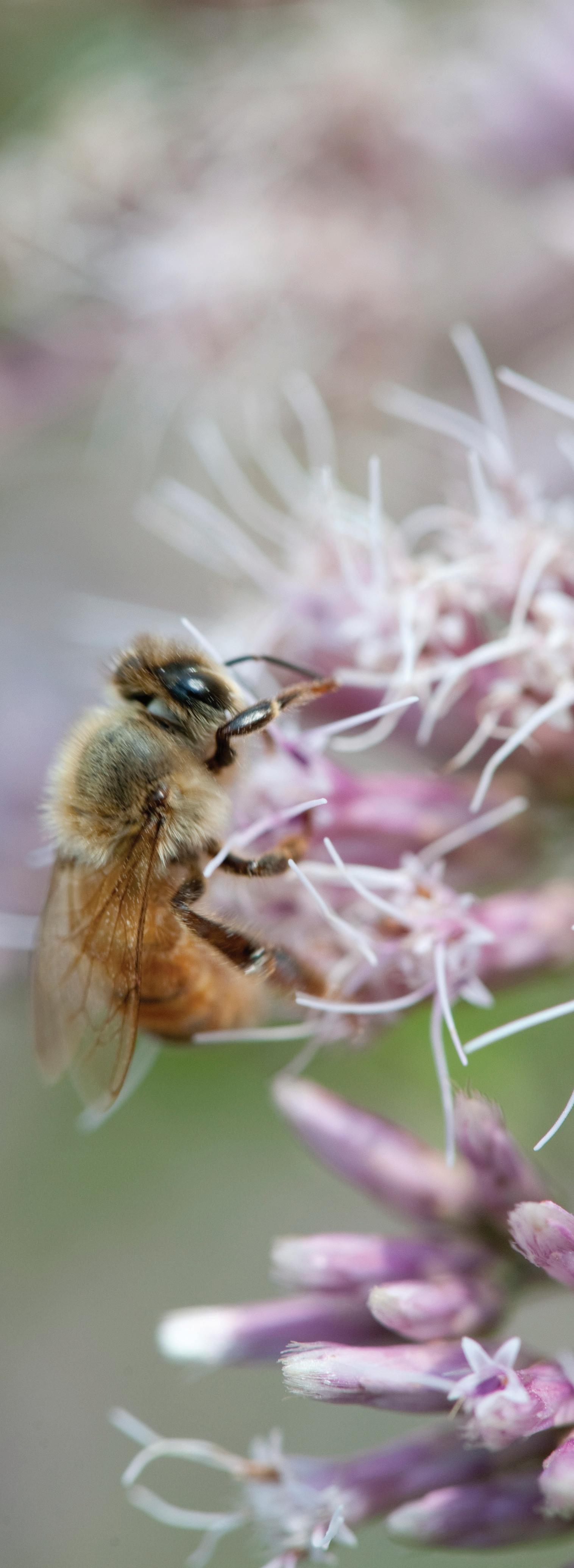
1 Great Plants Start Here™ Rooting for the Future 2 Meet Henry Eilers 3 Keep in Touch 4 Our Broker Network 5 First Friday Garden Loop 6 Custom & Contract Grow Program Growing Better with SANC 7 IPM in Action 8 Our Living Laboratory 9 Landscape Plugs™ Resource Guide 11 North Creek Legacy Items 12 Black Walnut Tolerant 13 Deer Resistant 14 Erosion Control 15 Evergreen Basal Foliage 16 Fall & Winter Interest 17 Green Roof 18 Season Extenders 19 Groundcover Collection 20 No Mow Solutions 22 Pollinator Friendly 23 Rain Garden by Zones 24 Salt Tolerant 25 Potting by Season 26 Perennials 29 Grasses 61 Carex 67 Ferns 71 Vines & Woodies 75 How to Order, Stay Connected 78 Shipping, How to Find Us 80 Eupatorium sp.
Our Building Blocks
Rooting for the Future
A milestone is often an occasion for reflection. Reflection on successes is rewarding; reflection on shortcomings is humbling. Reflection on all the points in between is progress. A milestone is also an opportunity for us to return to what is essential—a return to our why.
To propagate and market plants that develop the relationship between people and sustainable outdoor environments.
I hope the pages of this resource guide provide just this: a reflection of our why embodied by our plant palette today, 35 years since our founding. This publication ultimately serves as an educational resource for our industry, evolving as we too have grown. The details in between speak to all the points in between—our progress—and serve as a nod to the accomplishments we have made as a team through time. My hope is that these collective efforts—our story—will serve as an inspiration for what North Creek has yet to contribute to our industry.
When we started North Creek Nurseries in 1988, native plants were largely unknown to the public. There was little awareness of the vital role native plants play in enhancing biodiversity and supplying ecosystem services. We became pioneers in the native plant propagation movement and did our best to produce and promote plants that contribute ecological function and value—along with beauty—to the world. To educate our customers and the industry, we first sought to educate ourselves on responsible landscape applications, gardening practices, and growing methods.
Today, our team remains dedicated to bridging the gap between horticulture and ecology. We supply our customers with regionally appropriate native plants, native selections, and key species that provide valuable ecosystem services, functioning beneficially in the landscape to help alleviate the burden of climate change and foster pollinator longevity. Sustaining native species is profoundly important to preserve biodiversity for the future.

Discover The Power Of Native Plants!
Native plants are the building blocks of the food web and the foundation of life on Earth. Collectively, our small actions influence substantial change. By working to revitalize nature in our local communities, we begin to understand the importance of a sense of place. We can use this knowledge to introduce, connect, or reconnect people to the environment. To encourage stewardship of our local environment and beyond is to enact the ‘think globally, act locally’ mindset—and uphold native plants as the first choice of growers, gardeners, industry professionals, and anyone who aspires to support and enjoy nature. Help us raise awareness by following in the footsteps of Mother Nature.
With gratitude,
 Steve Castorani President & CEO
Steve Castorani President & CEO
Where Horticulture Meets Ecology™ 2 1985 - 1987 Landenberg Property Acquired (17 acres) Steve, Peg, Dale & Carol Hash Out Business Plan 1988 Founded by Steve Castorani & Dale Hendricks
“ Plants are not a luxury; they are a vital part of what keeps our world in balance.
—Steve Castorani
Meet Henry Eilers
A Botanist by Love and Horticulturist by Trade
We’ve carried his namesake sweet coneflower for years—you know it by its quintessential quilled petals and playful yet prevailing floral display—the Rudbeckia that catches your eye as it peeks in and out of the perennial border. The name behind a plant is oft times layered and unique, and we’d like to introduce you to our friend, Henry Eilers.
A German native, Henry Eilers was born a son of agriculture on his parents’ dairy farm on August 17, 1934, in Juebberde, East Friesland. Upon completing high school, young Henry attended the Horticultural Trade School in Oldenburg and apprenticed at a greenhouse firm in nearby Bad Zwischenahn.
“Even my earliest childhood memories include those of the natural world, as my interest in this area was derived from both the love of my mother and her love and knowledge for wildflowers—nurture and nature—as she shared them with me.”
—Henry Eilers
After immigrating to America in 1955, Henry set down roots in Litchfield, Illinois and began his first job at Litchfield Floral Gardens, a subsidiary of a nursery in nearby St. Louis, Missouri.
He then took a position with H. F. Henrichs Publications in developing Sunshine Park. During that time, he met his future wife, Ursula Garbe. A man of duty, Henry was called into service in 1957 by the US Army where he served as Artillery Survey Computer in the 4th Armored Division—a human computer—calculating logarithms, triangulations, and measurements by hand.
Discoverer and creator, Henry is a lover of natural areas, gardens and of family through and through. A man dedicated to his craft and passion for horticulture, together with Ursula, Henry founded H E Nursery in the fall of 1960. His fascination with and eagerness to learn about the native flora of the Midwest was the start of a lifelong journey.
Today, nearly 70 years later we have his namesake Rudbeckia in honor of this road travelled—and an exciting new introduction on the way.

Keep an eye on availability, as we’ll be adding yet another Eilers selection to our offering–this time a white flowered form of skullcap, Scutellaria incana ‘Prairie Snow’. Limited offering to start—if you have a soft spot for skullcap, consider the achromatic impact of ‘Prairie Snow’.

A lifelong learner, contributor, and industry supporter, Mr. Eilers has lent service and expertise to an assortment of associations and industry organizations to nurture the nature we create together. It is a privilege to carry his plants and call him our friend.

Great Plants Start Here™ 3 1991 ‘Hippies Use Side Door’ Sign Unveiled at North Creek World Headquarters Gifted by Ed Snodgrass 1992 Joined International Hardy Plant Union/Internationale Stauden-Union (ISU) 1988 Join the Perennial Plant Association (PPA) 1989 House 30 Constructed (First Heated Greenhouse) 1990 Alex Tovar Hired – North Creek’s Longest Tenured Employee 1990 - 1991 Joined Pennsylvania Landscape & Nursery Association (PLNA) & International Plant Propagators Society (IPPS)
Coming 2024! Scutellaria incana ‘Prairie Snow’
Rudbeckia subtomentosa ‘Henry Eilers’
Keep In Touch
Customer Service
Josiah Gregory Customer Service & Sales Support Manager josiah@northcreeknurseries.com
Sharon Dunfee Customer Service Team Leader sdunfee@northcreeknurseries.com
Annie Acton Customer Service Representative annie@northcreeknurseries.com
Mary Stevens
Customer Service Representative & Sales Support mary@northcreeknurseries.com
Scott Fisher
Ecological Customer Service Representative scott@northcreeknurseries.com
Sales, Plant Trials & Marketing Angela Clelan Regional Sales Manager angela@northcreeknurseries.com
Jerry Rice
Regional Sales Manager jerry@northcreeknurseries.com
Arden Pontasch Plant Trials Manager arden@northcreeknurseries.com
Carrie Wiles Marketing Manager carrie@northcreeknurseries.com
Julia Eppes Marketing Assistant julia@northcreeknurseries.com
Finance & Billing
Nikki Drake Controller nikki@northcreeknurseries.com
Joy Curry Financial Assistant joy@northcreeknurseries.com
Growing, Inventory & Production Pancho Castillo Senior Grower & Propagator pancho@northcreeknurseries.com
Kassie Garris Growing Coordinator Landenberg Nursery kassie@northcreeknurseries.com
Ryan Butcher Growing Coordinator Oxford Nursery butch@northcreeknurseries.com
Sarah McGinty Inventory Manager sarah@northcreeknurseries.com
Victoria Bolden Production Specialist victoria@northcreeknurseries.com
Rose Daly Production Coordinator rose@northcreeknurseries.com
Courtney Knight Production Administrator courtney@northcreeknurseries.com
Jaime Manlove Production Administrator jaime@northcreeknurseries.com
Shipping & Customer Pickup
Ryan McGinty Oxford Farm Manager ryan@northcreeknurseries.com
Jody Stuart Shipping Manager jody@northcreeknurseries.com
Jerry Harris Oxford Farm Assistant & Driver 484.614.8647
Joe Miller Driver 484.221.0682
Where Horticulture Meets Ecology™ 877.ECO.PLUG | info@northcreeknurseries.com | northcreeknurseries.com 4 1999 Oxford Property Acquired (28 Acres) 1994 First Stormwater Infrastructure Basins Created and Vegetated (Landenberg Property) 1995 Greenhouse Expansion – House 40 & 50, 100 & 200 Constructed 1995 Groundwork Laid for 300’s Greenhouse Range 1999 First Color Catalog Published 2001 Introduced Landscape Plugs™ LP32 and LP50 to the Ecological Market
Our Broker Network
Ball Horticultural Company 630.231.3600 ballhort.com
BFG Supply Co. 800.883.0234 www.bfgsupply.com
Bondi Plant Brokerage 619.403.0238 bondibrokerage.com
Eason Horticultural Resources 800.214.2221 ehrnet.com
Express Seed Company 800.221.3838 expressseed.com
Florasource, Ltd® 949.498.1131 florasourceltd.com
Germania Seed Co. 800.380.4721 germaniaseed.com
Griffin Greenhouse Supplies, Inc. 800.888.0054 griffins.com

Holland Garden Products Eric Olson 616.610.0048
McHutchison 800.943.2230 mchutchison.com
Mid Atlantic Plant Company 800.366.0350 midatlanticplant.com
Netherland Bulb Company 800.78.TULIP netherlandbulb.com
Perennial Market 877.766.8748 perennialmarket.com
Robin Wittman Co. Inc. 845.744.6801
Star® Roses & Plants 800.457.1859 starrosesandplants.com
Maryland Plants & Supplies, Inc. 800.248.2818 marylandplantsandsupplies.webs.com
The Henry F. Michell Company 800.422.4678 michells.com
The Nursery Stock Market 502.243.4718 nurseryguide.com
Vaughan’s Horticulture 855.864.3300 vaughans.com
Canada FloreXpress Marc Piché (Quebec) 450.540.0934 marc1piche@gmail.com
Great Plants Start Here™ 5 2006 Implemented NeonicotinoidFree Growing Practices and IPM Program 2007 Established Comprehensive Recycling Program 2001 Installed Tall Meadow with Landscape Plug™ Product Line 2004 Co-Created the American Beauties Native Plants® Brand 2005 Developed Extensive Plant Trialing Program as Part of Our New Product Introduction Process 2006 Established Native Species Seed Orchard of Local Ecotypes to Increase Biodiversity
First Friday Garden Loop Custom & Contract Grow Program
Display & Trial Gardens
388 North Creek Road
Landenberg, PA 19350
We thrive on sharing knowledge and experiences about the plants we propagate, and the land management strategies employed at North Creek. With over three acres of display gardens, watershed management areas, and trial comparisons—and 35 years’ experience of trial and error—North Creek is committed to being a resource for our customers, our industry, and our local community. From constructed wetlands, rain gardens, and bioswales to side-by-side comparison trials and display gardens demonstrating planting designs for erosion control and pollinator value, our living laboratory has countless opportunities for observation and education. Experience the seasonal transitions of our stormwater management systems and trial gardens year-round—even while dormant, plants are still hard at work! Our First Friday Garden Loop provides an opportunity for visitors to tour at their leisure via our self-guided map or join an employeeled group tour.

Contact us at marketing@northcreeknurseries.com
Seeking a species not customarily found on our product availability? Or in a liner size not traditionally offered by North Creek?
Let’s find a way to work together!
As licensed propagators for a variety of breeding networks, we have access to new introductions and seed species beyond the core you have come to rely upon. Whether a grower looking to add depth to your perennial palette, or a design and installation professional seeking Landscape Plugs™ in quantities that accommodate the specific needs of your projects—you can count on North Creek!
For detailed information—as well as ordering guidelines—please contact our customer service team for details. Advance notice and approval from our production team is required to enter a custom grow contract.
• Secure Custom Material
• Name your Quantities
• Job-site Delivery Option
Contact us today to review options and discuss how we may assist! Minimum quantity per variety may vary; contact our customer service team for details.
877.ECO.PLUG sales@northcreeknurseries.com
Where Horticulture Meets Ecology™ 6
2009 Executed Working Smarter Training Challenge & Implemented Lean Flow 2008
2008 Elvis aka
Diboll
to
PPA 2008 Instituted the CSA— Company Supported Agriculture—Employee Vegetable Garden 2010 Achieved Sustainable Sites (SITES™) Qualification
Expansion of Living Laboratory Stormwater Management Systems (Including: Meadows, Pollinator Gardens, and Stormwater BMPs)
Neil
Arrives
the North Creek Evening Garden Reception for
On the move—now administered by 16 growing facilities spanning 13 states nationwide! The Systems Approach to Nursery Stock Certification (SANC) is a systems-based method that places emphasis on how plants are produced over the course of cultivation rather than how they appear at the time of a single point of inspection. This voluntary audit-based program for plant production facilities utilizes a comprehensive approach to reduce pest risks associated with plant handling and exchange. SANC is an ongoing effort to incorporate the designated processes into existing state-based certification programs to reduce pest risk and disease movement while facilitating and expediting the handling of nursery stock.
Why SANC?
For North Creek, the SANC program has helped elevate our growing practices. Working in step with SANC, our team ensures clean, healthy plugs are produced efficiently with less handling—streamlining processes on our end saves time and money on your end—a win for our customers, a win for our staff, and a win in our effort to run a lean business.
Recognizing that each production facility is unique, SANC can be tailored to diverse types of nurseries, greenhouses, and growing facilities. North Creek is proud to be an original adopter of SANC—the 2nd nursery in Pennsylvania and the 5th nursery in the nation to receive SANC accreditation—and our team is happy to discuss the benefits and rewards this program provides our industry.
Benefits to Shipping States
• Focus resources to reduce pest risk and enhance existing programs
• Enable plant production facilities to create cleaner product
• Expedited inspections time
Benefits to Receiving States
• Plant material from SANC-certified facilities addresses systemic plant health at every level


• Lessens risk of quarantined pest introduction

7 Great Plants Start Here™
2015 Completed Executive Academy for Growth & Leadership (EAGL) Certificate in Applied Horticultural Business Management 2010 Awarded Farmer of the Year, Chester County, Pennsylvania (First Nursery in PA to be Honored with this Distinction) 2012 Shipping Facility Upgrade (Oxford Property) 2011 North Creek Unique™ Collection Created 2012 Introduced First Patented Plant – Schizachyrium scoparium ‘Standing Ovation’ 2012 Joined Sustainable Business Network of Greater Philadelphia GSI Partners
Integrated Pest Management in Action
Our approach to Integrated Pest Management (IPM) stands with the habitats our plants will eventually call home. Whether en route to a residential oasis, urban greenspace or landscape restoration project—however big or small—these sites work to enhance habitat for pollinator support and longevity. In keeping with our mission, every effort is made to grow plants in the safest and most sustainable manner possible. For our team, for our customers, for the planet. Every plant counts.
Sound IPM
The first step in our IPM program is our use of beneficial insects, serving as a frontline preventative in supporting the health of our plants. If the need to address a pest population arises, we act by these pillars of our IPM program.

Setting Action Thresholds
Treat only when populations cause economic damage
Scouting & Identification
• Identify the pest—proper ID is critical
• Determine and implement the best method of treatment
• Track pest and beneficial populations
• Gauge the effectiveness of treatments
Prevention & Control
• Identify the appropriate time to act
• Utilize earth-friendly methods such as nematodes, beneficial predatory insects, and soft chemistry
• Prevent populations from reaching action threshold
• Treat on a case-by-case basis and according to the specific issue
• Reach a preventable level to allow beneficials to catch up
Where Horticulture Meets Ecology™ 8 Beneficial insects released on Phlox paniculata ‘Jeana’
2016 Honored with Land Ethics Award by Bowman’s Hill Wildflower Preserve 2015 Honored with Grower Award by Perennial Plant Association 2015 Landenberg Greenhouse Range Expansion Complete (54,720 sqft) 2015 Shady Groundhuggers™ Collection Published 2016 Implemented PowerPivot Data Collecting for IPM Program 2016 Awarded Operation of the Year —Excellence in Sustainable Production by Greenhouse Grower Magazine
Our Living Laboratory
Sited at North Creek’s World Headquarters in Landenberg, PA, over 3 acres of gardens function as our living laboratory—the home of our plant trialing program, featuring extensive habitat, experimental, and comparison plantings. In these gardens, we evaluate the ecological, functional, and aesthetic characteristics of every plant we propagate with guidance from North Creek’s New Plant Principles—must be garden-worthy, not be aggressive or invasive, and require little maintenance once established. We are ever evaluating our catalog material and trialing plants from plant breeders, industry suppliers, native plant enthusiasts, as well as our own selections. As your partner in ecological landscape solutions and garden-worthy plants, it is our responsibility to produce, provide, and promote perennials we firmly stand behind. The information we gather from our gardens and share with the industry is the foundation of our offerings to our valued customers—true North Creek plants grounded in 35 years of experience.
Landscape Plugs™
Superior landscape solutions for customer success
The Sustainable Landscape Plug™
• Custom soil blend
• Tray made of 100% recycled and recyclable material
• Less waste on job site—improved liner with no under tray
The Highest Quality Landscape Plug™
• Re-engineered tray for maximum root development and heartier crown
• Root channels guide roots downward to prevent circling

• Optimal root density for rapid transition to native soils
• Custom grow options available—consistent quality and reliable availability
The Most Efficient Landscape Plug™
• Reduced labor costs—fast layout, installation, and cleanup
• Reduced freight & handling costs—plants ship directly to job site on recyclable wooden racks

Native Plant Solutions For Ecological Landscapes™

9 Great Plants Start Here™
2017 Earned Systems Approach to Nursery Certification (SANC) Compliant Status via National Plant Board 2018 Hall of Fame Award by Pennsylvania Landscape & Nursery Association (PLNA) 2020 Oxford Greenhouse Range Expansion Complete 2020 Horticultural Industry Leadership Award (HILA) by Nursery Management Magazine 2020 Awarded the Paul Ecke Jr. Commercial Award by The American Horticultural Society 2021 - Beyond Continue to Expand Shade Trial Gardens and Look to the Future!


Great Plants Start Here™ 11 Resource Guide North Creek Legacy Items 12 Black Walnut Tolerant 13 Deer Resistant 14 Soil Stabilizers 15 Evergreen Basal Foliage 16 Fall & Winter Interest 17 Green Roof 18 Season Extenders 19 Groundcover Collection 20 No Mow Solutions 22 Pollinator Friendly 23 Rain Garden by Zones 24 Salt Tolerant 25 Potting by Season 26
into the
things,
Nature be
teacher. –William Wordsworth Adiantum pedatum & Geranium maculatum
“ Come forth
light of
let
your
North Creek Legacy Items
Upon 35 years in business, we naturally start to reflect on what is central to our cause— what makes us North Creek—and the plants that have been with us from the start. In step with our mission, these tried-and-true species and cultivars have earned a spot on our availability since our first flat shipped in 1988. Like old friends, our North Creek Legacy Plants have been with us for the long haul. They conjure a smile when we see them holding space in our product guide and exemplify garden worthiness across perennial borders near and far. It is inspiring to see these integral members of our product offering continue to prove their merit, and our privilege to provide customers with plants they can rely on, year after year. This collection of 65 plants is definitive of what it means to be North Creek.
Perennials
Achillea ‘Moonshine’
Achillea millefolium ‘Paprika’
Amsonia hubrichtii
Anemone sylvestris
Aquilegia canadensis
Aquilegia canadensis ‘Corbett’
Asclepias incarnata
Asclepias tuberosa
Aster cordifolius
Aster divaricatus
Aster novae-angliae
Aster novae-angliae ‘Purple Dome’
Asteromea mongolica
Baptisia australis
Calamintha nepeta ssp. nepeta
Ceratostigma plumbaginoides
Chelone glabra
Chelone lyonii ‘Hot Lips’
Chrysogonum virginianum ‘Allen Bush’
Chrysogonum virginianum var. australe
Coreopsis verticillata ‘Moonbeam’
Coreopsis verticillata ‘Zagreb’
Echinacea purpurea ‘White Swan’
Eupatorium coelestinum
Eupatorium fistulosum
Eupatorium perfoliatum
Geranium maculatum
Eupatorium ‘Gateway’
Heuchera americana ‘Dale’s Strain’
Heuchera micrantha ‘Palace Purple’
Iris cristata
Iris versicolor
Lobelia cardinalis
Lobelia siphilitica
Monarda fistulosa
Packera aurea
Penstemon digitalis
Penstemon digitalis ‘Husker Red’
Phlox stolonifera ‘Sherwood Purple’
Polemonium reptans
Porteranthus trifoliatus
Rudbeckia fulgida ‘Goldsturm’
Rudbeckia laciniata
Rudbeckia laciniata ‘Autumn Sun’
Rudbeckia triloba
Salvia nemorosa ‘East Friesland’
Salvia nemorosa ‘May Night’
Scabiosa ‘Butterfly Blue’
Sedum ‘Weihenstephaner Gold’
Sedum telphinum ‘Autumn Joy’
Solidago graminifolia
Solidago sphacelata ‘Golden Fleece’
Tiarella cordifolia
Verbena hastata
Vernonia noveboracensis
Veronicastrum virginicum
Grasses
Calamagrostis brachytricha
Calamagrostis ‘Karl Foerster’
Chasmanthium latifolium
Panicum virgatum
Schizachyrium scoparium
Scirpus cyperinus
Sorghastrum nutans
Vines & Woodies
Caryopteris × clandonensis ‘Dark Knight’
Lonicera sempervirens
Where Horticulture Meets Ecology™ 877.ECO.PLUG | info@northcreeknurseries.com | northcreeknurseries.com 12
Black Walnut
Tolerant
Black walnut, or Juglans nigra, is a deciduous tree commonly found in the landscape along the East Coast. Though a beautiful shade tree with edible fruits that support wildlife, this species produces the allelochemical juglone, which is toxic to vegetation and stunts growth, therefore preventing plant establishment in proximity to the root zone. Juglone persists in the soil for years after a walnut tree is gone—this residual effect is powerful enough to continue keeping many perennials at bay. Luckily, quite a few native plants have adapted to this pressure and can survive in soils with juglone present. For those struggling to find beautiful plants that can tolerate black walnut, this list includes perennials, grasses, and ferns for full sun to shade conditions that thrive in areas where black walnut is—or was—growing.
Allium cernuum
Andropogon sp. and cvs.
Anemone sp. and cvs.
Aster sp. and cvs.
Bouteloua curtipendula
Calamagrostis sp. and cvs.
Chasmanthium latifolium
Deschampsia sp. and cvs.
Eragrostis spectabilis
Festuca glauca cvs.
Hakonechloa macra
Helleborus Brandywine™

Heuchera sp. and cvs.
Iris sp. and cvs.
Juncus sp. and cvs.
Lonicera sp. and cvs.
Mertensia virginica
Monarda sp. and cvs.
Muhlenbergia sp. and cvs.
Panicum sp. and cvs.
Phlox sp. and cvs.
Polemonium reptans and cvs.
Polystichum sp.
Schizachyrium sp. and cvs.
Sorghastrum nutans and cvs.
Sporobolus heterolepis
Stachys sp. and cvs.
Tradescantia sp. and cvs.
13 Resource Guide
Monarda punctata
Deer Resistant
Oh, dear! The deer are at it again! You’re probably tired of hearing this, but we cannot stress this fact enough—deer-resistant does not mean deer-PROOF! In lean times, when food sources are scarce, these beautiful yet destructive creatures will eat just about anything verdant and lush. However, plants included on this list are generally the last thing a deer will try in the garden. These plants are typically unpalatable and not as susceptible to deer pressure—unless under extreme duress. So, go on, Bambi—make our day.
Achillea sp. and cvs.
Agastache sp. and cvs.
Allium cernuum
Amsonia sp. and cvs.
Andropogon sp. and cvs.
Aquilegia canadensis and cvs.
Asclepias sp. and cvs.

Asteromea mongolica
Athyrium sp. and cvs.
Calamagrostis sp. and cvs.
Calamintha sp. and cvs.
Caltha palustris
Carex sp. and cvs.
Caryopteris sp. and cvs.
Ceratostigma plumbaginoides
Chasmanthium latifolium
Chrysogonum virginianum and cvs.
Coreopsis sp. and cvs.
Dryopteris sp. and cvs.
Echinacea sp. and cvs.
Eupatorium sp. and cvs.
Euphorbia amygdaloides var. robbiae
Gaura lindheimeri cvs.
Gelsemium ‘Margarita’
Helenium sp. and cvs.
Helleborus Brandywine™
Juncus sp.
Lavandula cvs.
Leucanthemum ‘Becky’
Lonicera sempervirens and cvs.
Matteuccia struthiopteris
Meehania cordata
Monarda sp. and cvs.
Muhlenbergia sp. and cvs.
Nepeta sp. and cvs.
Osmunda regalis var. spectabilis
Packera sp.
Panicum virgatum and cvs.
Perovskia cvs.
Polystichum sp.
Pycnanthemum sp. and cvs.
Rubus calycinoides
Salvia lyrata ‘Purple Knockout’
Salvia nemorosa cvs.
Schizachyrium sp. and cvs.
Scirpus sp.
Sisyrinchium cvs.
Solidago sp. and cvs.
Sorghastrum nutans and cvs.
Stachys cvs.
Viola walteri ‘Silver Gem’
Where Horticulture Meets Ecology™ 14
Asclepias tuberosa
Soil Stabilizers
Steep hillsides, sandy soils, banks along a water feature—the one thing these areas have in common is a need for erosion control during inclement weather. Soil stabilization is the key to maintaining a landscape, as wind and rain can lead to surface soil runoff and erosion over time. With proper physical erosion control barriers, stormwater management techniques, and species selection, these trials become points of interest rather than insurmountable challenges. We offer a full selection of perennials, ferns, and grasses that run the light tolerance gamut of full sun to shade—providing beautiful green solutions to stabilizing soil no matter the cultural requirements.
Acorus americanus
Agastache foeniculum
Allium cernuum

Andropogon sp.
Aster sp. and cvs.
Antennaria plantaginifolia
Caltha palustris
Carex sp. and cvs.
Chasmanthium latifolium
Chrysogonum sp. and cvs.
Erigeron ‘Lynnhaven Carpet’
Eupatorium sp. and cvs.
Euphorbia amygdaloides var. robbiae
Iris versicolor and cvs.
Juncus effusus
Juncus tenuis
Lysimachia lanceolata ‘Burgundy Mist’
Matteuccia struthiopteris
Monarda bradburiana
Monarda didyma and cvs.
Monarda fistulosa and cvs.
Nepeta sp. and cvs.
Oenothera sp. and cvs.
Packera sp.
Panicum sp. and cvs.
Pycnanthemum sp. and cvs.
Rubus calycinoides
Ruellia humilis
Schizachyrium sp. and cvs.
Scirpus sp.
Solidago sp.
Sorghastrum nutans and cvs.
Waldsteinia ternata
15 Resource Guide
Pycnanthemum flexuosum
Evergreen Basal Foliage
Beyond floral display and foliage texture, additional plant characteristics can enhance a garden design. When selecting plants, considering the whole of their features is beneficial—as these can provide interest, extend the season, and even serve important functions in the landscape. Evergreen basal rosettes are modified stems with a circular arrangement of leaves at the base of the plant. This dense cluster of foliage assists plants in surviving harsh winters, aids them in outcompeting surrounding plants, and provides protection from herbivory. Incorporating plants with evergreen basal foliage in the garden can allow you to utilize this survival mechanism as a design element. These plants can lend winter interest, suppress germination of weed seeds, and supply ecosystem services such as habitat for fauna and erosion control. A little less time weeding and a bit more time enjoying the beauty of your garden—sounds good to us!
Antennaria plantaginifolia
Carex amphibola
Carex appalachica
Carex eburnea
Carex flaccosperma
Carex laxiculmus Bunny Blue® ‘HOBB’
Carex morrowii ‘Ice Dance’
Carex oshimensis ‘Evergold’
Carex pensylvanica
Carex plantaginea
Carex radiata
Carex rosea
Carex ‘Silver Sceptre’
Chrysogonum virginianum and cvs.
Festuca glauca cvs.
Helleborus Brandywine™
Hypericum calycinum and cvs.
Juncus sp.
Lobelia sp. and cvs.
Lysimachia lanceolata ‘Burgundy Mist’
Oenothera sp. and cvs.
Pachysandra procumbens
Packera sp.
Polystichum sp.
Rubus calycinoides

Salvia sp. and cvs.
Sedum sp. and cvs.
Solidago sempervirens
Stachys cvs.
Viola walteri ‘Silver Gem’
Waldsteinia ternata
Where Horticulture Meets Ecology™ 16
Packera aurea foliage
through winter months
Fall & Winter Interest
Agastache sp. and cvs.
Amsonia hubrichtii
Andropogon sp.
Asclepias sp. and cvs.
Aster sp. and cvs.
Asteromoea mongolica
Baptisia sp. and cvs.
Bouteloua curtipendula
Calamagrostis cvs.

Calamintha nepeta ssp. and cvs.
Carex sp. and cvs.
Caryopteris cvs.
Chasmanthium latifolium
Chrysogonum virginianum and cvs.
Coreopsis palustris ‘Summer Sunshine’
Deschampsia cespitosa and cvs.
Dryopteris sp. and cvs.
Echinacea sp. and cvs.
Eragrostis spectabilis
Eupatorium sp. and cvs.
Geranium × cantabrigiense cvs.
Helianthus salicifolius cvs.
Heliopsis helianthoides cvs.
Helleborus Brandywine™
Heuchera sp. and cvs.
Hibiscus moscheutos
Juncus sp.
Kalimeris cvs.
Liatris sp.
Lysimachia lanceolata ‘Burgundy Mist’
Monarda sp. and cvs.
Muhlenbergia sp. and cvs.
Nepeta cvs.
Panicum sp. and cvs.
Perovskia cvs.
Polystichum acrostichoides
Pycnanthemum sp.
Rudbeckia sp. and cvs.
Schizachyrium sp. and cvs.
Scirpus sp.
Solidago sp. and cvs.
Sorghastrum nutans and cvs.
Sporobolus heterolepis
Vernonia sp. and cvs.
17 Resource Guide
Schizachyrium scoparium ‘Standing Ovation’
Green Roof
Green space—whether urban, suburban, or rural—provides opportunity to experience the depth of beauty that nature has to offer. The color green symbolizes nature and the natural world and is thought to relieve stress and aid in the healing process. Today, more than half of the world’s population inhabits urban areas, with projections expected to trend upward. The effort to ‘green our cities’ makes sense. Hand in hand with urban parks, green roofs provide city residents with an improved quality of life while providing a sense of emotional, mental, and physical well-being.
The Greatness of Green Roofs: Environmental, Economic, and Social Benefits
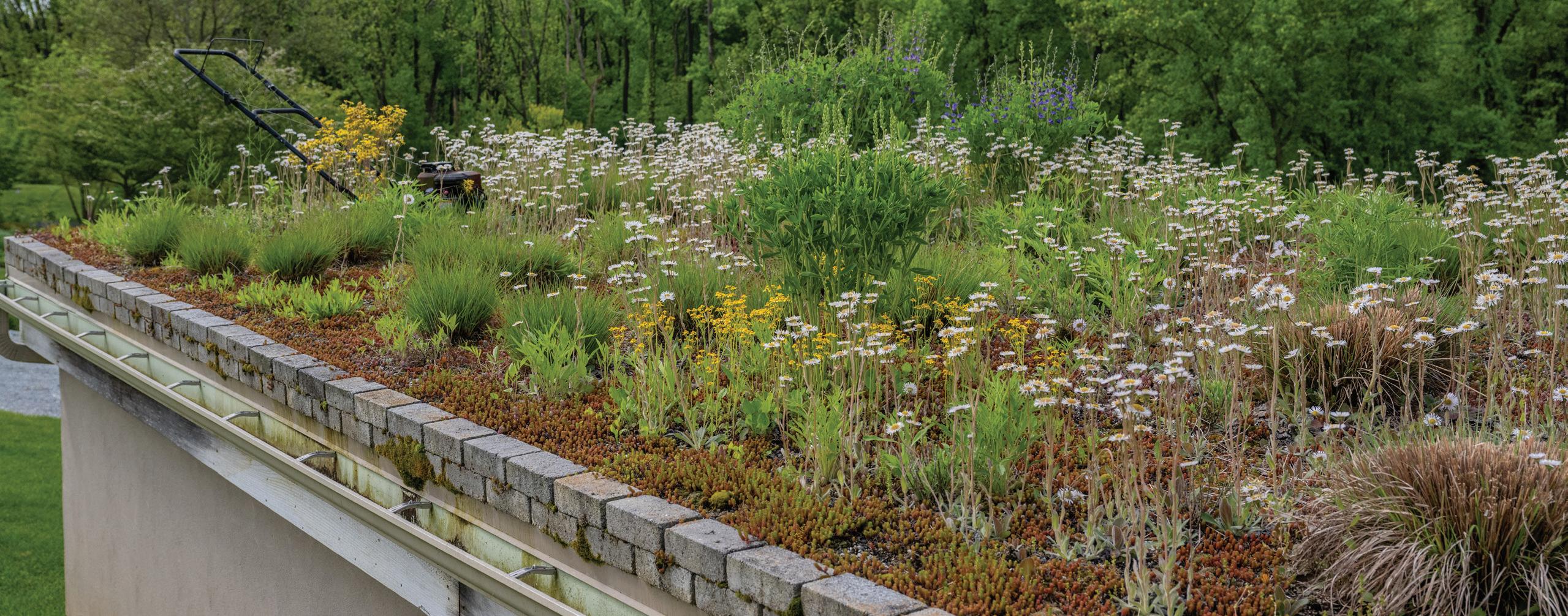
• Stormwater runoff retention
• Urban heat island mitigation
• Reduced building energy costs
• Carbon sequestration
Shallow Substrate (4”)
Sedum ‘Cherry Tart’
Sedum ‘Dazzleberry’
Sedum ‘Lime Zinger’
Sedum ‘Weihenstephaner Gold’
Sedum reflexum ‘Blue Spruce’
Sedum rupestre ‘Angelina’
Sedum sieboldii
Sedum spurium ‘John Creech’
Sedum spurium ‘Red Carpet’
Sedum ternatum ‘Larinem Park’ (shade)
Deeper Substrate
(not irrigated) (6-8”)
Achillea sp. and cvs.
Agastache sp. and cvs.
Allium cernuum
Asclepias tuberosa
Aster ericoides ‘Snow Flurry’
Bouteloua curtipendula
Calamintha sp. and cvs.
Callirhoe involucrata
• Longer lifespan than standard roofs
• Reduced noise and air pollution
• Increased urban biodiversity
Festuca glauca cvs.
Lonicera sempervirens and cvs.
Monarda punctata
Muhlenbergia sp. and cvs.
Nepeta cvs.
Oenothera fruticosa and cvs.
Panicum sp. and cvs.
Favorite Green Mulch (under 12”)
Antennaria plantaginifolia
Carex amphibola
Carex morrowii ‘Ice Dance’
Carex pensylvanica
Erigeron ‘Lynnhaven Carpet’
Euphorbia amygdaloides var. robbiae
Lysimachia lanceolata ‘Burgundy Mist’
Pachysandra procumbens
Packera sp.
Waldsteinia ternata
Where Horticulture Meets Ecology™ 18
Green roof on North Creek’s pump house
Season Extenders
Just when you think you’ve seen the last of your garden’s display in its final flush of fall flowers, plants surprise you with other ornamental features–guiding the garden past the frost finish line. In winter’s muted landscape, characteristics like the structure, texture, form, and height of a plant can shift into the spotlight–providing definition in relief to the softened landscape.
Grasses are a staple for structure in the winter landscape. Late-blooming plants like Vernonia extend the season with ornamental seedheads, exciting the eye with each intricate, colorful faded flower. Rudbeckia and Echinacea stalks create a dynamic sense of movement and textural interest amidst the stiller surroundings, while their seedheads are an important food source for birds.
Plants with late-season interest can be beautiful while serving as beneficial cover and forage over the winter months. This array of winter shades may be subtle, but well-suited to the changing nature of the garden. These season extenders are sure to grace you with fall and winter beauty with their flowers, foliage, seedheads, or structure.
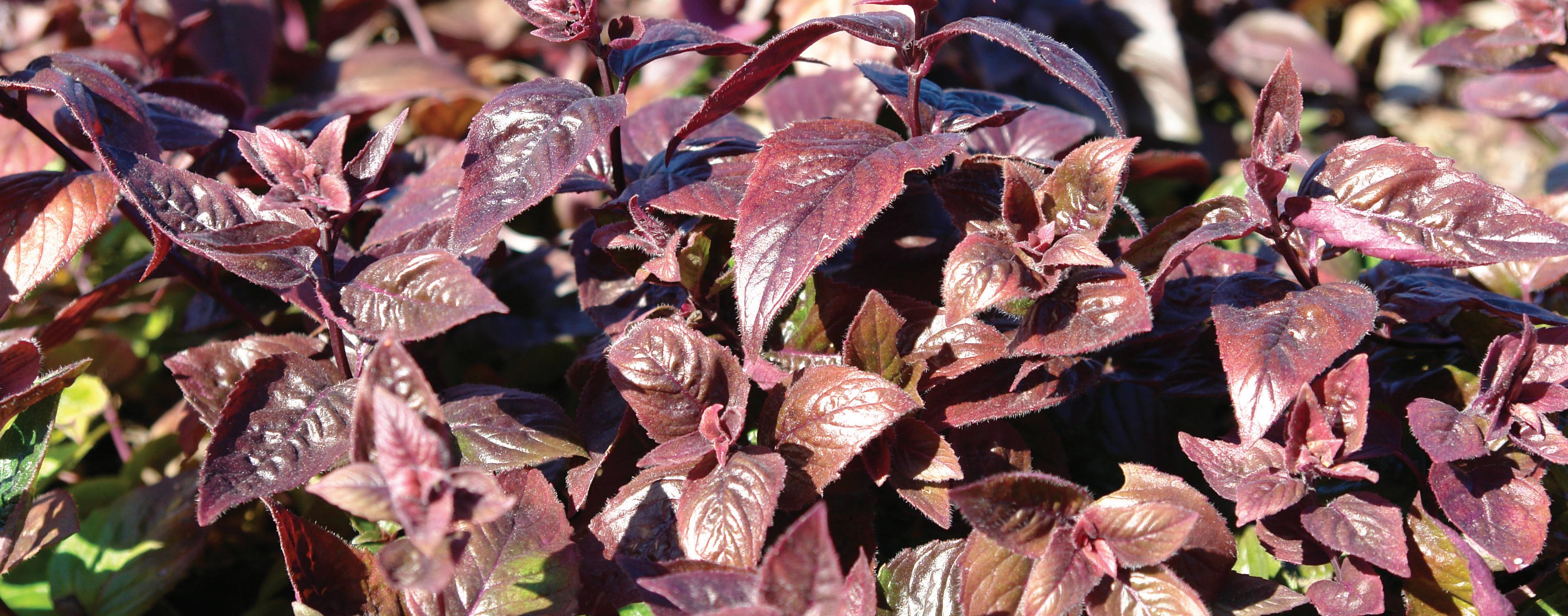
Amsonia hubrichtii
Andropogon sp.
Anemone canadensis
Aster oblongifolius and cvs.
Calamagrostis sp. and cvs.
Calamintha nepeta ssp. and cvs.
Chasmanthium latifolium
Deschampsia cespitosa and cvs.
Echinacea sp. and cvs.
Eragrostis spectabilis
Helianthus salicifolius cvs.
Helleborus Brandywine™
Monarda bradburiana
Muhlenbergia sp. and cvs.
Panicum sp. and cvs.
Polystichum sp.
Rudbeckia sp. and cvs.
Schizachyrium sp. and cvs.
Scirpus cyperinus
Solidago sp. and cvs.
Sorghastrum nutans and cvs.
Sporobolus heterolepis
Vernonia sp.
19
Monarda bradburiana
Resource Guide
Groundcover Collection
What makes a groundcover a groundcover? While low height comes to mind, what truly makes a plant a groundcover is the way it grows, forming solid, interconnected mats of foliage. This ability to form dense cover discourages weeds naturally, while providing multiple seasons of interest from flowers to foliage. We have chosen our top-performing perennial groundcovers for commonly found challenging landscapes: moist sun, dry sun, moist shade, and dry shade. These groundcovers form herbaceous mats, spread steadily, and max out at 18” tall in the landscape.
Here are our top-performing perennial groundcovers for common challenging conditions: moist sun, dry sun, moist shade, and dry shade. These reliable groundcovers form herbaceous mats, spread steadily, and max out at 18” tall in the landscape.
Moist Sun
Usually found in low-lying areas with poor soil drainage, moisture-loving perennials grow robustly in sunny, moist sites. They are happy with wet feet and are less likely to develop diseases associated with high moisture levels, such as mildew. These selections are typically found along streams, ponds, or low areas prone to seasonal flooding typical of wet meadow environments. In the cultivated garden, they are ideal for a low spot where water collects and are excellent options for rain gardens.
Alchemilla mollis ‘Auslese’
Anemone sp. and cvs.
Aster ‘Wood’s Blue’
Aster ‘Wood’s Pink’
Aster ‘Wood’s Purple’
Aster novae-angliae ‘Purple Dome’
Aster novae-angliae ‘Vibrant Dome’
Caltha palustris
Chelone obliqua Tiny Tortuga™
Deschampsia cespitosa ‘Goldtau’
Geranium macrorrhizum cvs.
Dry Sun
Heuchera villosa ‘Caramel’
Hypericum calycinum and cvs.
Juncus tenuis
Monarda bradburiana
Packera obovata
Physostegia virginiana ‘Miss Manners’
Rudbeckia ‘Little Goldstar’
Salvia lyrata ‘Purple Knockout’
Solidago Little Lemon®
Verbena ‘Homestead Purple’
Dry sun is a common condition found along exposed slopes, near walls or pathways absorbing and emitting heat, or newly constructed buildings or developments where UV is plentiful and the soil quality poor and rocky. Fortunately, quite a few plants have adapted to these hot, dry circumstances, especially those originally found in the prairies or in the steppes. Here are some tough perennials that can withstand heat, uneven moisture levels, poor soil, and glaring sun.
Achillea sp. and cvs.
Amsonia ‘Blue Ice’
Antennaria plantaginifolia
Aster oblongifolius ‘October Skies’
Bouteloua curtipendula
Calamintha sp. and cvs.
Coreopsis pubescens ‘Sunshine Superman’
Coreopsis verticillata and cvs.
Eragrostis spectabilis
Euphorbia amygdaloides var. robbiae
Festuca glauca cvs.
Hypericum calycinum and cvs.
Kalimeris incisa ‘Blue Star’
Lysimachia lanceolata ‘Burgundy Mist’
Muhlenbergia reverchonii UNDAUNTED®
Nepeta sp. and cvs.
Oenothera sp. and cvs.
Rubus calycinoides
Salvia lyrata ‘Purple Knockout’
Salvia nemorosa cvs.
Sedum sp. and cvs.
Solidago sphacelata ‘Golden Fleece’
Stachys cvs.
Where Horticulture Meets Ecology™ 877.ECO.PLUG | info@northcreeknurseries.com | northcreeknurseries.com 20
Moist Shade
Species native to these environmental elements originate from deciduous forests with rich, moist soils. Moisture loving, shade-tolerant perennials thrive in soggy or saturated soil conditions, don’t mind wet feet, and are less likely to develop diseases associated with high moisture, such as mildew. Usually found in low-lying areas with poor soil drainage, these groundcovers provide lush texture and seasonal appeal in gardens where tall buildings and mature canopy with long shadows can limit perennial selection.
Adiantum pedatum
Athyrium sp. and cvs.
Carex appalachica
Carex cherokeensis
Carex flaccosperma
Carex laxiculmus Bunny Blue® ‘HOBB’
Carex plantaginea
Carex radiata
Chrysogonum virginianum and cvs.
Dryopteris erythrosora ‘Brilliance’
Dryopteris marginalis
Dry Shade
Helleborus Brandywine™
Heuchera sp. and cvs.
Onoclea sensibilis
Packera aurea
Phegopteris decursive-pinnata
Phlox divaricata ‘Blue Moon’

Polemonium reptans and cvs.
Stylophorum diphyllum
Tiarella sp. and cvs.
Tradescantia ‘Sweet Kate’
Tricyrtis cvs.
Most perennials adapted to cool, shady conditions are native to rich, moist deciduous forests. However, dry shade is one of the most common garden challenges—especially along shaded slopes, areas close to building foundations, under eaves, or beneath mature trees thirsty for any available soil moisture. In such competitive conditions, many shade perennials fail to thrive—but with the right plants, these gardens transform from a challenge into a delight.
Aster divaricatus ‘Eastern Star’
Carex appalachica
Carex eburnea
Carex flaccosperma
Carex laxiculmus Bunny Blue® ‘HOBB’
Carex pensylvanica
Carex plantaginea
Carex oshimensis ‘Evergold’
Carex ‘Silver Sceptre’
Chrysogonum virginianum and cvs.
Deschampsia flexuosa
Dryopteris erythrosora ‘Brilliance’
Dryopteris marginalis
Erigeron ‘Lynnhaven Carpet’
Euphorbia amygdaloides var. robbiae
Geranium maculatum and cvs.
Heuchera longiflora
Heuchera villosa ‘Caramel’
Heuchera macrorhiza ‘Autumn Bride’
Meehania cordata
Packera aurea
Phlox stolonifera ‘Sherwood Purple’
Phlox divaricata cvs.
Polystichum sp.
Sedum ternatum ‘Larinem Park’
Waldsteinia ternata
21
Resource Guide
Phlox divaricata ‘Blue Moon’
No Mow Solutions
There is something so pleasing, on a primitive level, about having a clear sight line with undulating, low-growing grasses and sedges. Whether beneath a deciduous canopy, along a steep hillside that’s impossible to mow, or as companion in a short, sunny meadow— plants included on our no-mow solutions list stay under 2’ tall, (some up to 3’ feet when in bloom) and cover the full spectrum of sunlight requirements. Go for a rich carpet of a single species planting such as the soft running of Carex pensylvanica or a textured, layered meadow of sun-drenched clumping genera such as Muhlenbergia, Bouteloua, Panicum, and Schizachyrium—you can’t go wrong with replacing tired lawn with the lowmaintenance ease of these no-mow grasses and sedges. Pro-tip: Carex are an excellent replacement to traditional grasses and fescues that struggle to compete with the shallow root environment and shady canopy created by deciduous trees. Once a year, in late winter or early spring, trim these grasses and sedges to the ground in anticipation of fresh, new growth—much more enjoyable than mowing your lawn weekly all summer long!

Bouteloua curtipendula
Carex amphibola
Carex appalachica
Carex cherokeensis
Carex eburnea
Carex flaccosperma
Carex laxiculmus Bunny Blue® ‘HOBB’
Carex morrowii ‘Ice Dance’
Carex muskingumensis
Carex oshimensis ‘Evergold’
Carex pensylvanica
Carex plantaginea
Carex radiata
Carex rosea
Carex ‘Silver Sceptre’
Deschampsia sp. and cvs.
Eragrostis spectabilis
Festuca glauca cvs.
Hakonechloa macra
Juncus tenuis
Muhlenbergia sp. and cvs.
Panicum ‘Cape Breeze’
Schizachyrium sp. and cvs.
Sporobolus heterolepis
Where Horticulture Meets Ecology™ 22
Sporobolus heterolepis en masse at Scott Arboretum
Pollinator Friendly

Our pollinator plant collection includes a diverse mix of perennials, grasses, sedges, and vines to help you exceed the expectations of your customers. Since North Creek’s founding in 1988, we have set out to increase appreciation of native plants, as well as raise awareness of just how critical native plants are to the health of our ecosystem. In our 35th year, we are happy to say that this awareness and appreciation has increased—is even at the forefront of market demand—but there is still work to be done.
Plants are not a luxury; they are a vital part of what keeps our world in balance. It is important to continue to ask ourselves what we and members of our industry are doing to advocate for improving pollinator health. By incorporating these plants into your production schedule or garden design, you can be sure of your contributions to this effort by producing plants that are beneficial to—and beloved by!—pollinators.
Achillea sp. and cvs.
Agastache sp. and cvs.
Allium cernuum
Amsonia sp. and cvs.
Andropogon sp. and cvs.
Anemone sp. and cvs.
Antennaria plantaginifolia
Aquilegia canadensis and cvs.
Asclepias sp. and cvs.
Aster sp. and cvs.
Baptisia sp. and cvs.
Bouteloua curtipendula
Callirhoe involucrata
Caltha palustris
Carex pensylvanica
Chelone sp. and cvs.
Coreopsis sp. and cvs.
Echinacea sp. and cvs.
Erigeron ‘Lynnhaven Carpet’
Eryngium yuccifolium
Eupatorium sp. and cvs.
Helenium sp. and cvs.
Helianthus sp. and cvs.
Heliopsis sp. and cvs.
Hibiscus moscheutos
Iris sp. and cvs.
Liatris sp. and cvs.
Lobelia sp. and cvs.
Lonicera sp. and cvs.
Mertensia virginica
Monarda sp. and cvs.
Oenothera sp. and cvs.
Packera sp.
Panicum sp. and cvs.
Penstemon sp. and cvs.
Phlox sp. and cvs.
Physostegia virginiana cvs.
Polemonium reptans cvs.
Pycnanthemum sp. and cvs.
Ratibida sp. and cvs.
Rudbeckia sp. and cvs.
Ruellia humilis
Salvia sp. and cvs.
Schizachyrium sp. and cvs.
Sedum sp. and cvs.
Silene ‘Short and Sweet’
Solidago sp. and cvs.
Sorghastrum nutans and cvs.
Sporobolus heterolepis
Thermopsis villosa
Tiarella sp. and cvs.
Tradescantia sp. and cvs.
Verbena hastata
Vernonia sp. and cvs.
Veronicastrum virginicum
Waldsteinia ternata
Zizia aurea
23 Resource Guide
‘Jeana’
Phlox paniculata
Rain Garden by Zones
Right plant, right place—proper species selection is the determining factor for a project’s success. This 3-zone guide is based on the soil moisture gradient and serves as a tool for choosing species that will quickly knit together to form stable plant communities.

Zone 1
Acorus americanus
Asclepias incarnata and cvs.
Athyrium filix-femina and cvs.
Athyrium niponicum cvs.
Caltha palustris
Carex amphibola
Carex radiata
Carex stricta
Carex vulpinoidea
Chelone glabra
Chelone lyonii ‘Hot Lips’
Dryopteris × australis
Dryopteris erythrosora
‘Brilliance’
Dryopteris golidana
Dryopteris marginalis
Eupatorium dubium ‘Little Joe’
Eupatorium fistulosum
Eupatorium perfoliatum
Eupatorium ‘Gateway’
Helenium sp. and cvs.
Hibiscus moscheutos
Iris versicolor and cvs.
Juncus effusus
Juncus tenuis
Lobelia sp. and cvs.
Matteuccia struthiopteris
Osmunda regalis var. spectabilis
Packera aurea
Scirpus cyperinus
Scirpus validus
Solidago graminifolia
Verbena hastata
Vernonia noveboracensis
Veronicastrum virginicum
Zone 2
Andropogon gerardii
Aster novae-angliae and cvs.
Aster novi-belgii
Carex amphibola
Carex pensylvanica
Carex radiata
Chasmanthium latifolium
Deschampsia cespitosa and cvs.
Eryngium yuccifolium
Eupatorium dubium ‘Little Joe’
Eupatorium fistulosum
Eupatorium perfoliatum
Eupatorium ‘Gateway’
Helenium sp. and cvs.
Juncus effusus
Juncus tenuis
Liatris spicata
Monarda didyma and cvs.
Monarda fistulosa and cvs.
Panicum sp. and cvs.
Physostegia virginiana cvs.
Pycnanthemum flexuosum
Pycnanthemum muticum
Rudbeckia laciniata
Rudbeckia maxima
Solidago rugosa ‘Fireworks’
Sorghastrum nutans and cvs.
Thalictrum rochebrunianum
Tradescantia ohiensis
Zone 3
Amsonia hubrichtii
Andropogon virginicus
Asclepias tuberosa
Asclepias verticillata
Aster laevis ‘Bluebird’
Aster novae-angliae and cvs.
Aster novi-belgii
Baptisia sp. and cvs.
Bouteloua curtipendula
Calamintha sp. and cvs.
Callirhoe involucrata
Carex appalachica
Chasmanthium latifolium
Coreopsis sp. and cvs.
Echinacea sp. and cvs.
Eragrostis spectabilis
Geranium sp. and cvs.
Helianthus sp. and cvs.
Heliopsis sp. and cvs.
Monarda sp. and cvs.
Nepeta cvs.
Oenothera sp. and cvs.
Panicum sp. and cvs.
Penstemon sp. and cvs.
Phlox paniculata ‘Jeana’
Physostegia virginiana cvs.
Pycnanthemum sp.
Rudbeckia fulgida ‘Goldsturm’
Rudbeckia fulgida var. fulgida
Rudbeckia ‘Henry Eilers’
Rudbeckia triloba
Ruellia humilis
Schizachyrium sp. and cvs.
Solidago ‘Solar Cascade’
Solidago rugosa ‘Fireworks’
Solidago sempervirens
Sorghastrum nutans and cvs.
Thermopsis villosa
Vernonia ‘Iron Butterfly’
Where Horticulture Meets Ecology™ 24
Salt Tolerant
The idea of plants being able to withstand salt seems counterintuitive—the chemical nature of the sodium and chlorine ions break down plant cells as it binds to other molecules and disrupts the pathways plants use to absorb water and nutrients—effectively stopping the critical photosynthesis process when salt is in high enough quantities. But as always, nature finds a way, and some plants not only mildly tolerate salt but thrive in it. This list, originally featured in our weekly The Plug® email, is full of plants that have evolved in conditions with higher-than-normal salinity. In areas surrounding roadways or ocean shores, selecting plants with high salt tolerance leads to greater planting success as they are durable and adapted to such conditions. Designer-tip: some plants listed are tolerant of salt spray more than soil salinity and vice versa. It is important to do your research to find a plant most suitable to the environment in which it will be exposed. Reports performed by NC State, University of Maryland, and University of Wisconsin were excellent resources to assist in creating this plant list.
Achillea sp. and cvs.
Allium cernuum
Anemone canadensis
Aquilegia canadensis and cvs.
Asclepias tuberosa
Aster novae-angliae and cvs.
Aster novi-belgii
Baptisia sp. and cvs.
Bouteloua curtipendula
Calamagrostis ‘Karl Foerster’

Carex flaccosperma
Carex vulpinoidea
Chasmanthium latifolium
Deschampsia cespitosa and cvs.
Echinacea purpurea and cvs.
Eragrostis spectabilis
Gelsemium ‘Margarita’
Hibiscus moscheutos
Juncus effusus
Lonicera sempervirens and cvs.
Monarda didyma and cvs.
Muhlenbergia sp. and cvs.
Oenothera sp. and cvs.
Perovskia cvs.
Panicum virgatum and cvs.
Rudbeckia sp. and cvs.
Schizachyrium sp. and cvs.
Scirpus validus
Solidago sempervirens
Sorghastrum nutans and cvs.
Sporobolus heterolepis
Veronica spicata ‘Glory’
25 Resource Guide Rain garden layout by zones at North Creek
Potting by Season
Year Round
Achillea sp. and cvs.
Acorus americanus
Agastache sp. and cvs.
Alchemilla mollis ‘Auslese’
Amsonia sp. and cvs.
Asteromea mongolica
Calamagrostis brachytricha
Calamintha sp. and cvs.
Carex sp. and cvs.
Chrysogonum virginianum and cvs.
Coreopsis sp. and cvs.
Erigeron ‘Lynnhaven Carpet’
Geranium sp. and cvs.
Heuchera sp. and cvs.
Iris cristata sp. and cvs.
Lavandula cvs.
Lonicera sempervirens and cvs.
Lysimachia lanceolata ‘Burgundy Mist’
Mertensia virginica
Nepeta hybrids and cvs.
Onoclea sensibilis
Perovskia cvs.
Phlox carolina ssp. carolina ‘Kim’
Phlox paniculata ‘Jeana’
Physostegia virginiana cvs.
Porteranthus trifoliatus and cvs.
Pycnanthemum sp.
Rubus calycinoides
Rudbeckia fulgida var. fulgida
Rudbeckia subtomentosa ‘Henry Eilers’
Rudbeckia triloba and cvs.
Salvia lyrata ‘Purple Knockout’
Scabiosa ‘Butterfly Blue’
Sedum sp. and cvs.
Sisyrinchium cvs.
Stachys ‘Helen von Stein’
Stachys ‘Silver Carpet’
Stokesia laevis ‘Peachie’s Pick’
Tradescantia sp. and cvs.
Zizia aurea
Spring and Summer
Adiantum pedatum
Andropogon sp.
Anemone sp. and cvs.
Asclepias sp. and cvs.
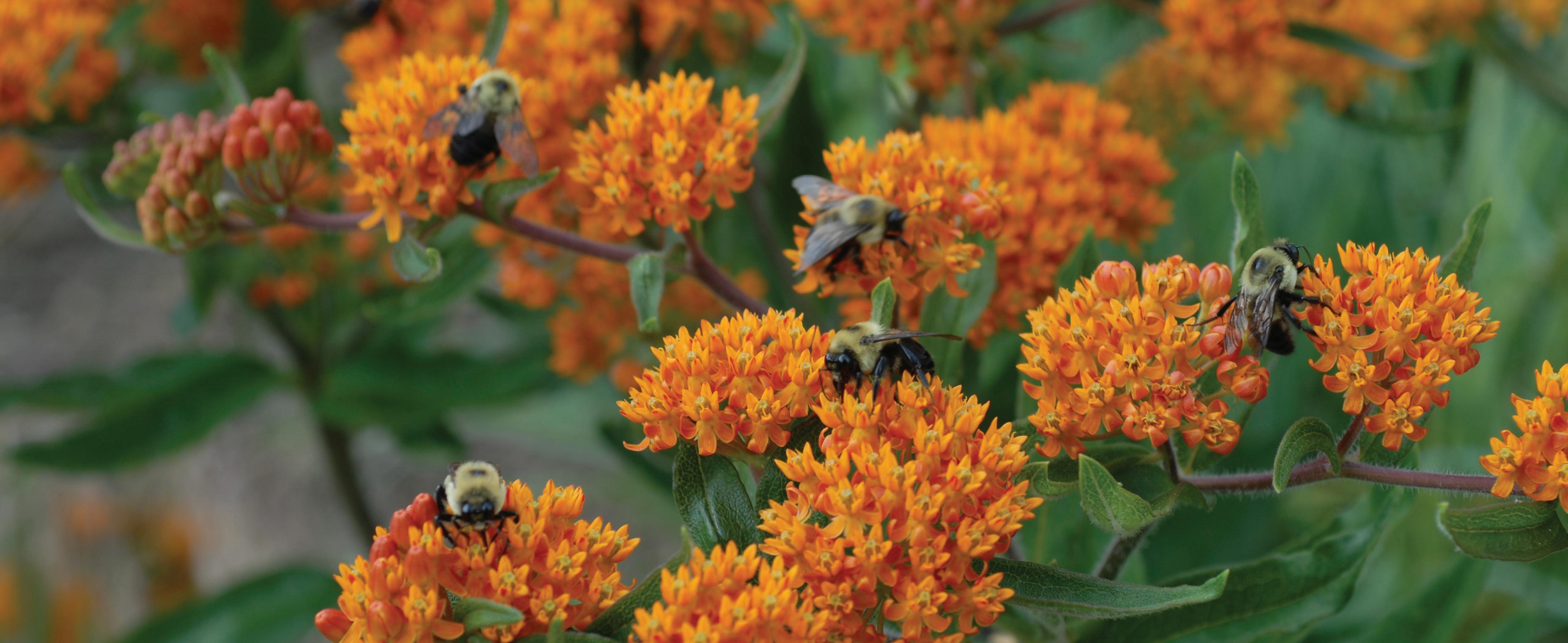
Aster sp. and cvs.
Athyrium sp. and cvs.
Baptisia sp. and cvs.
Boltonia asteroides
Bouteloua curtipendula
Caryopteris cvs.
Ceratostigma plumbaginoides
Chelone sp. and cvs.
Clematis virginiana
Delphinium exaltatum
Dryopteris sp. and cvs.
Echinacea sp. and cvs.
Eragrostis spectabilis
Eryngium yuccifolium
Eupatorium sp. and cvs.
Euphorbia amygdaloides var. robbiae
Gaura cvs.
Gelsemium ‘Margarita’
Gentiana ‘True Blue’
Hakonechloa macra
Helenium sp. and cvs.
Where Horticulture Meets Ecology™ 26
Asclepias tuberosa
Helianthus sp. and cvs.
Heliopsis sp. and cvs.
Helleborus Brandywine™
Hibiscus moscheutos
Hypericum calycinum and cvs.
Iris versicolor
Kalimeris cvs.
Liatris sp.
Lobelia sp. and cvs.
Matteuccia struthiopteris
Muhlenbergia sp. and cvs.
Oenothera sp. and cvs.
Osmunda sp.
Panicum virgatum and cvs.
Phegopteris decursive-pinnata
Penstemon sp. and cvs.
Polystichum sp.
Rudbeckia ‘American Gold Rush’
Rudbeckia fulgida var. and cvs.
Schizachyrium sp. and cvs.
Scutellaria sp. and cvs.
Solidago sp. and cvs.
Sorghastrum nutans and cvs.
Sporobolus heterolepis
Tricyrtis cvs.
Verbena ‘Homestead Purple’
Vernonia sp. and cvs.
Fall
Allium cernuum
Antennaria plantaginifolia
Aquilegia canadensis and cvs.

Aruncus dioicus
Calamagrostis ‘Karl Foerster’
Callirhoe involucrata
Caltha palustris
Chasmanthium latifolium
Deschampsia sp. and cvs.
Festuca glauca cvs.
Gentiana ‘True Blue’
Juncus sp.
Leucanthemum ‘Becky’
Meehania cordata
Monarda sp. and cvs.
Pachysandra procumbens
Packera sp.
Phlox divaricata cvs.
Phlox stolonifera ‘Sherwood Purple’
Polemonium reptans and cvs.
Ratibida sp. and cvs.
Rudbeckia laciniata and cvs.
Rudbeckia maxima
Ruellia humilis
Salvia nemorosa cvs.
Scirpus sp.
Silene ‘Short and Sweet’
Stachys monieri ‘Hummelo’
Stylophorum diphyllum
Thalictrum rochebrunianum
Thermopsis villosa
Tiarella sp. and cvs.
Verbena hastata
Veronica spicata ‘Glory’
Veronicastrum virginicum
Viola walteri ‘Silver Gem’
Waldsteinia ternata
27
Resource Guide
Geranium ‘Rozanne’
Asclepias syriaca
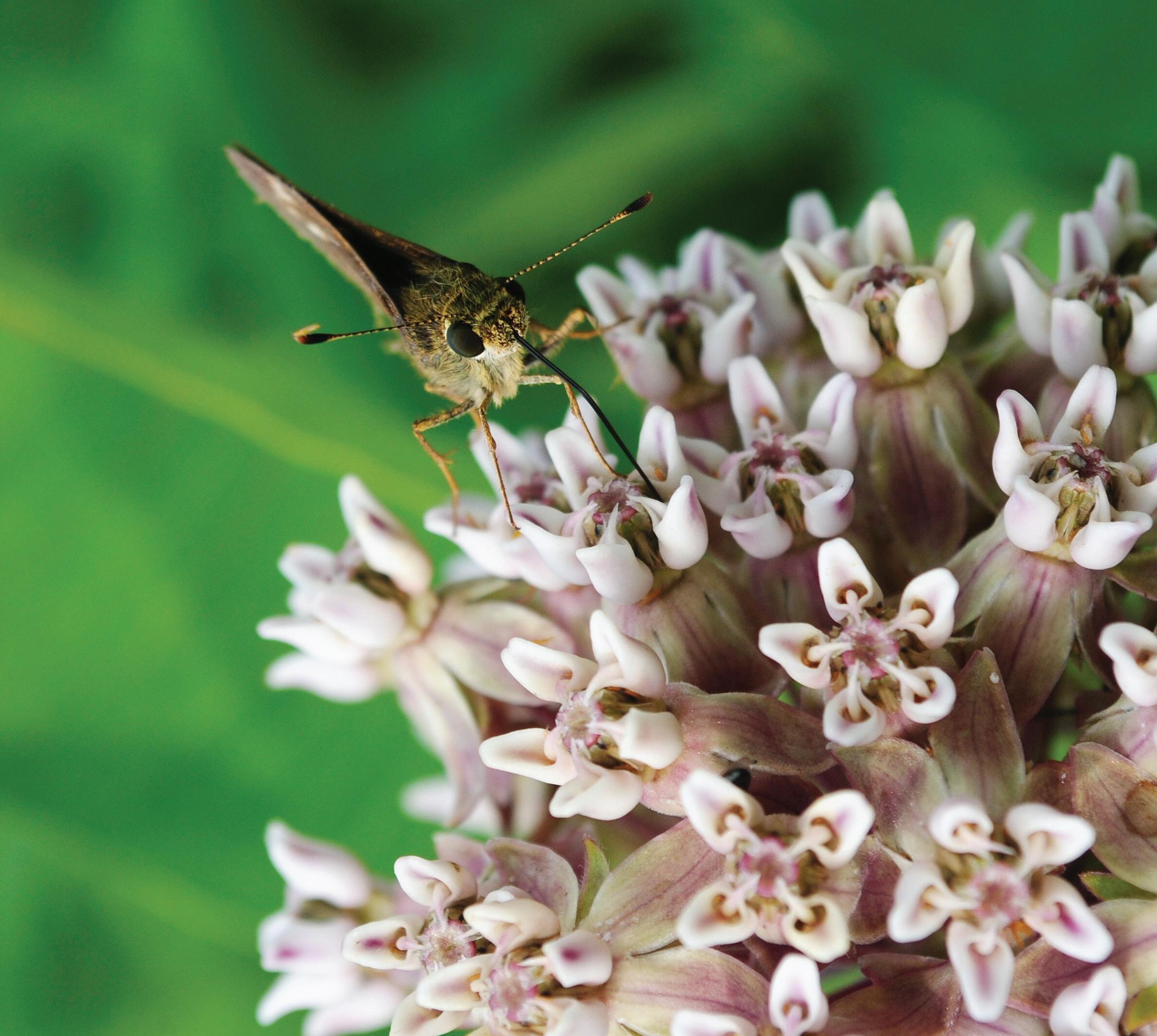
Key to Symbols
Full Sun Part Sun/Part Shade
Full Shade Native to Eastern U.S.
Attracts Butterflies Pollinator Friendly
Deer Resistant Cut Flower
Ornamental Foliage Salt Tolerant
Erosion Control Groundcover
Drought Tolerant Bird Friendly
Attracts Hummingbirds
Propagation Methods
seed
op open pollinated; propagated from seed and quite genetically variable.
scl seed cultivar; true from seed variety with distinct differences from the species. Consisent ornamental characteristics with slight individual variability.
veg
veg true cultivar; named variety propogated vegetatively. All plants are genetically identical.
tc tissue culture; all plants are genetically identical
Perennials Achillea
Achillea yarrow
Members of the Asteraceae family, yarrow is trouble-free, and easy to grow. A droughttolerant perennial with flat-topped flowers and lacy foliage, yarrow works excellently in the garden and provides months of blooms. Foliage will remain through winter in warmer zones. Happiest in full sun with good soil drainage. Especially attractive to pollinators, yarrow can be cut back after its initial flowering to encourage rebloom.
Agastache hyssop
A group of tremendous performers hardy through at least Zone 6. Dependable in production—and ready for potting up year-round. Beloved by an assortment of pollinators!
Amsonia bluestar
Strong growers and beautiful additions to the woodland edge or a sunny border, these mounded herbaceous, shrublike perennials are covered in small, star-like blue flowers in spring and summer with foliage that is attractive all season. For best color, site in full sun in moist, well-drained soil—autumn delivers a beautiful golden-yellow cast to foliage with select species of bluestar.
Anemone
anemone
Legend has it that the Greek goddess Aphrodite’s tears gave life to anemones as she wept in mourning for the death of the god Adonis. Linked with anticipation, is thought that the petals of Anemone flowers begin to close when rain is approaching. Beautiful planted en masse; anemones are distinctive with their long, graceful flowers held above mounds of dark green foliage. Most plants prefer to be grown in part shade in moist,
to Aster
well-drained soils. Ensure that fall-blooming Anemones receive enough sunlight for optimal floral display. Seedheads are an attractive winter feature. Anemone derives from anemos, the Greek word for wind.
Aquilegia wild
columbine
Aquilegia canadensis is found throughout the Eastern United States and thrives in thin soil above granite and along gravelly hillsides, becoming an easy choice for woodland meadows. A short-lived perennial, columbine spreads readily by seed and naturalizes.
A. canadensis is a key early season nectar source for native hummingbirds and at least four species of native bees. Aquilegia derives from aquila—meaning eagle—in reference to the spurred, hook-shaped blooms which resemble eagles’ talons.
Asclepias milkweed
Milkweeds are an important nectar source for bees and other nectar-seeking insects, and the sole food source of Monarch butterfly larvae. From our experience, milkweeds tend to emerge from their first winter dormancy in an inconsistent manner; therefore, our collection only ships in active growth.
Aster aster
In reference to the attractive flower heads, the name Aster comes from the Ancient Greek word meaning star. A very popular garden plant with a wonderful array of late season appeal—a quick turn spring potting crop guaranteed to boost your fall sales! From A. cordifolius to A. tataricus, our selection has something for everyone! Though the Asteraceae family was broken into smaller genera, for sake of ease we refer to plants as Aster, noting updated specific epithets.
29 Perennials | Grasses | Carex | Ferns | Vines & Woodies
Achillea ‘Moonshine’ (1)
A tried-and-true silver-leaved selection with broad yellow flowers topping sturdy stems. An excellent choice for a hot, dry site. A beautiful cut flower!
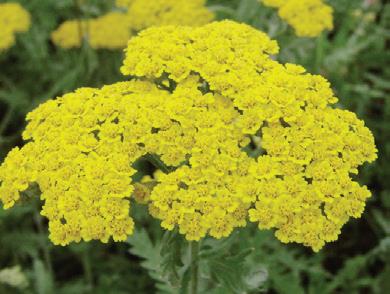
veg
1-2’ | Z 3-8 | 72
Achillea ‘Terracotta’
An Ernst Pagels introduction with pronounced silvery foliage and bright peach flowers that slowly turn to rich hues of earthy reds and oranges.
veg
2’ | Z 3-8 | 72
Achillea millefolium—NEW!
Naturalized yarrow has soft fernlike leaves that provide textural interest in the garden with soft white blooms in summer and occasionally into fall. Beloved by pollinators, A. millefolium spreads by rhizome and can be used as a full sun native lawn substitute.

op
1-3’ | Z 3-8 | LP50
Achillea millefolium
‘Oertel’s Rose’ (2)
A strong growing rose-pink variety. Flowers fade to near white atop deep green, ferny foliage. Carries through the heat and humidity of the deep south like a champ! Blooms June-September.
veg
12-15” | Z 3-8 | 72
Achillea millefolium ‘Paprika’
Intense red flowers surround golden centers. A vigorous grower that quickly forms a dense weed-blocking mat. An easy and rewarding production plant.
veg
2-3’ | Z 3-8 | 72
Agastache ‘Blue Fortune’ (3)
Selected for its profusion of longlasting, deep-blue flower spikes, ‘Blue Fortune’ is a A. foeniculum × A. rugosum hybrid made by Gert Fortens of the Arboretum Trompenberg in Rotterdam. Enjoy the procession of bees, butterflies, and hummingbirds from summer into autumn.
veg
3’ | Z 6-9 | 72
Agastache ‘Golden Jubilee’ Chartreuse coleus-like foliage is incredible on its own, but the blue bottlebrush flowers in mid-summer are the icing on the cake. Very hardy and will self-sow. Benefits from a little shade in production to protect leaf color. A 2003 AllAmerica Selection Flower Award Winner.
veg
2-3’ | Z 5-9 | 72
Agastache foeniculum anise hyssop
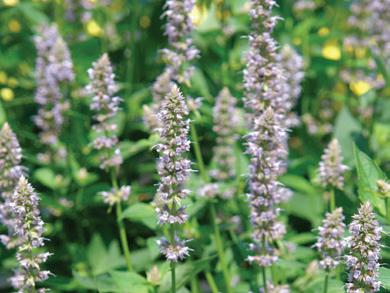
An upright, clump-forming native with densely packed, terminal spikes of lavender purple flowers. A highly ornamental member of the mint family with fragrant foliage and exceptional drought tolerance.
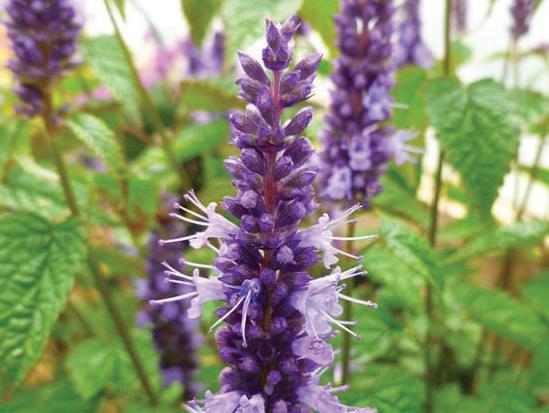
op
2-4’ | Z 4-8 | LP50
Agastache rugosa
‘Little Adder’ PP26514—NEW! (4)
A Darwin Perennials selection with medium violet-purple flowers, dark green foliage, and a vigorous, upright-mounding growth habit. Compared to A. ‘Black Adder’, ‘Little Adder’ sits lower in the perennial border and exhibits a more uniform branched habit. The bonus is the abundance of blooms—it’s safe to say pollinators will be very happy with the addition of this little gem in the landscape!

veg
15-18” | Z 5-9 | 72
Alchemilla mollis ‘Auslese’ lady’s-mantle
Green to bright chartreuse flowers appear in cloud-like clusters above scalloped, gray-green foliage late spring through summer. A robust and vigorous selection with strong, sturdy stems and wonderfully uniform habit. Prefers cool, moist soil. A perfect floral arrangement accent!
scl
12-16” | Z 3-8 | 72
Allium cernuum (5)
nodding onion
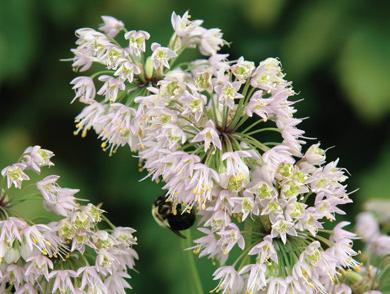
Found on ledges, gravel, and rocky or wooded slopes, this delicate native perennial produces gently nodding pink flowers in late spring. Beautiful in the garden, naturalized in a meadow, or planted in an extensive (3-5” deep) green roof. Easy, dependable, and very tolerant of drought once established.
op
12-18” | Z 4-8 | LP50
Amsonia ‘Blue Ice’ (6)
A long-blooming and compact selection, ‘Blue Ice’ has dark blue buds and flowers, blooming with 5 weeks or more of color. Best in full sun, but will tolerate part-sun conditions in average, well-drained soils. Deep green leaves turn bright yellow in fall. Looks fantastic in a gallon!
veg
12-15” | Z 5-9 | 72 + LP32
Amsonia hubrichtii (7)
threadleaf bluestar
A graceful and long-lived native plant with very fine foliage and clusters of steel blue flowers in May and June on an upright, bushy plant. Excellent golden fall color. Thrives in full sun or part shade. No insect or pest problems. Found in Arkansas in 1942 by Leslie Hubricht. The Perennial Plant Association’s 2011 Perennial Plant of the Year®. op 3’ | Z 4-9 | 72 + LP50
Anemone canadensis (8) Canadian anemone

A strong growing plant that needs room to move in moist, rich soils. Clear, white single flowers from midspring into early summer. Happy in average to dry soils as well, it fills in beautifully around larger plants.
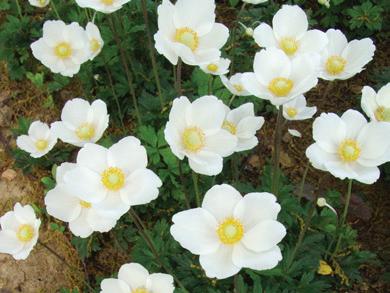
veg
12-18” | Z 4-8 | 50
Anemone sylvestris (9) snowdrop windflower
Delicate nodding white flowers in spring atop dense lustrous green foliage. A low-maintenance groundcover for bright shade!
op 12-18” | Z 4-8 | 72

Where Horticulture Meets Ecology™ 877.ECO.PLUG | info@northcreeknurseries.com | northcreeknurseries.com 30
1 2 3 4 5 6 7 8 9
Anemone Fantasy™
‘Pocahontas’ PP25352 (10)
Covered in double flowering, bubblegum pink blooms from mid to late summer! The seedheads look like little fluffy cotton balls, standing atop strong stems to give interest to the garden from fall into winter. This vigorous, clumping selection is a delight in the garden or mixed container.
tc 12-18” | Z 5-8 | 50
Anemone Fantasy™
‘Red Riding Hood’ PPAF (11)
Gorgeous bright rose-pink, single flowers bloom from late summer into early fall. A lovely cut flower plant with a clump-forming, compact habit that makes it just as lovely in the garden!
tc 12-18” | Z 5-8 | LP32
Anemone × hybrida
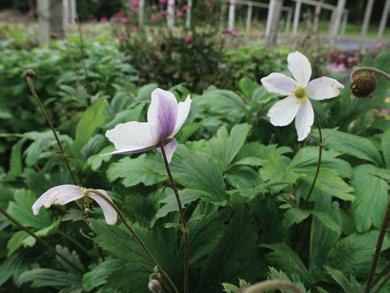

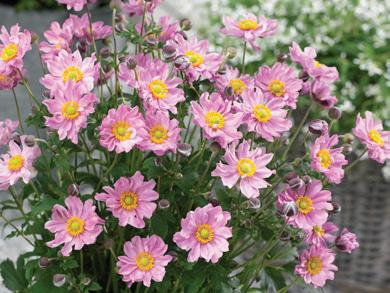
‘Honorine Jobert’ (12)
Japanese windflower

A timeless classic—this stately, clear-white selection was made in the mid-1800s and is still beloved by the modern gardener. Effortless and dependable with a bounty of flowers come summer. Spent flowers give way to cottony clusters of playful seedheads. The Perennial Plant Association’s 2016 Perennial Plant of the Year®
tc
3-4’ | Z 5-8 | 50
Anemone × hybrida Wild Swan™
‘MACANE001’ PP23132 (13)
A perennial border is not complete without the everlasting beauty and bloom of Wild Swan™. Gently nodding white inflorescences hover above medium green foliage. The noted charm of this selection is the lovely lavender-blue accent coating the sepal exterior. Flowers from mid-summer into autumn.

tc
18” | Z 5-8 | 50
Antennaria plantaginifolia (14) pussytoes
A tough native groundcover that thrives in full sun and dry, lean soils! This mat-forming perennial has fuzzy foliage with a grayish-blue cast. Blooms in early spring; flowers are whitish-pink and clustered, resembling a cat’s paw. Great in open woodland edges, rock gardens, or prairies. Larval host plant of the American lady butterfly.
veg
6-12” | Z 3-8 | LP32
Aquilegia canadensis (15)
Red flowers with yellow centers in April and May. Excellent shady rock garden naturalizer. Occurs naturally in rich rocky woods, slopes, cliffs, ledges, pastures, and roadside banks.
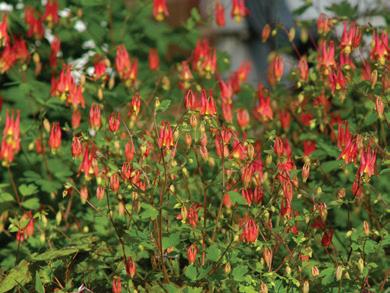
op
1-3’ | Z 3-8 | 72 + LP32
Aquilegia canadensis ‘Corbett’
Profuse show of butter-yellow, lantern-shaped flowers from April to May. Its short stature, delicate color and mid-spring bloom time make it an ideal companion for spring bulbs! Spotted by Lawrence Clemens, who asked that it be named after the Corbett Historic District near Monkton in Baltimore County. Bluemount Nurseries of Monkton, MD was the first to offer this charming local Aquilegia to the market.
scl
12-18” | Z 3-8 | 72
Aquilegia canadensis

‘Little Lanterns’
dwarf wild columbine
A compact, red-stemmed selection, ‘Little Lanterns’ is short in stature with a bountiful supply of pendantshaped flowers in shades of red and yellow.
scl
12-18” | Z 3-8 | 72
Aruncus dioicus
goat’s beard
A large, fine-textured Astilbe-like native ideally suited for average to moist woodland conditions. Large, creamy white, feathery plumes in early summer.

op
4-6’ | Z 5-9 | 50
31 Perennials | Grasses | Carex | Ferns | Vines & Woodies
10 11 12 13 14 15
Aquilegia canadensis ‘Little Lanterns’
Aruncus dioicus
Asclepias curassavica

scarlet milkweed
A tender perennial with small orange and gold umbels of very bright and showy flowers. Easy to grow; cut back the plant for a denser habit and more flower display. A Monarch magnet!
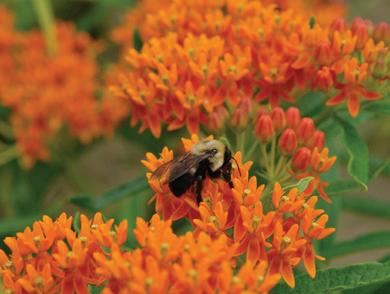
op
24-30” | Z 9-11 | 72
Asclepias incarnata
swamp milkweed
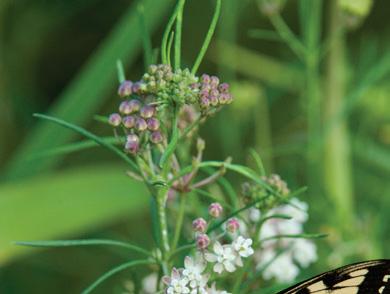

Adaptable to wet and dry soils, this species is one of the most beautiful native perennials with its clusters of upturned pink flowers in June and July. Attracts butterflies of all kinds. Occurs in floodplains and wet meadows.
op
3-5’ | Z 3-9 | LP50
Asclepias incarnata
‘Cinderella’ (1)
Sweetly scented with blooms of blush pink, this outstanding selection from Walters Gardens lasts longer in your garden than her namesake. A perennial with beauty, grace, and staying power, this wetland native does well in average garden conditions and is a pollinator favorite!
scl
3-5’ | Z 3-9 | LP50
Asclepias incarnata ‘Ice Ballet’ (2)
The elegant, bright white form of A. incarnata. Underused garden beauty that thrives in average soil conditions! Long blooming through July and August. Clear white flowers and dark green foliage make the colors of the hundreds of visiting butterflies glisten in the sunlight.
scl
3-4’ | Z 3-9 | 72
Asclepias syriaca common milkweed
This classic native is best known as a food source of larval monarch butterflies, but it is also attractive in bloom with gloves of fragrant pink flowers in June and July, followed by lovely pods full of silky seeds in October. Occurs in open fields and roadsides east of the Rockies.
op
2-4’ | Z 4-9 | LP50
Asclepias tuberosa (3) butterfly milkweed
A tough, drought-tolerant native with intense orange flowers in mid to late summer. Attracts an assortment of butterflies and is especially attractive to Monarchs. A beautiful solution for a dry, sunny slope! Combines well with wild petunia, little bluestem, and Tennessee coneflower. Occurs in dry fields and roadsides across the US. The Perennial Plant Association’s 2017 Perennial Plant of the Year®
op
18-24” | Z 3-9 | 72 + LP50
Asclepias verticillata (4) whorled milkweed
Great for massing or mixing—this widely adaptable and tough native bears delicate white flowers atop fine foliage in mid-summer. A fastgrowing substitute with delicate texture reminiscent of Amsonia hubrichtii. Highly toxic to livestock and horses.
op
1-3’ | Z 4-8 | LP50
Aster cordifolius (5) syn. Symphyotrichum cordifolium blue wood aster
Your search for late season color in dry shade stops here! As the landscape transitions into autumnal tones, this gem bursts into a cloud of blue flowers. A great naturalizer under trees, at the edge of woods, or as filler in the woodland garden. Blooms mid-September–October.
op 2-3’ | Z 3-8 | LP50
Aster cordifolius ‘Avondale’ (6) syn. Symphyotrichum cordifolium ‘Avondale’
This selection of the native wood aster is a prolific bloomer and carpets the shade garden with light blue in early fall. A smart choice for dry shade! A quick and easy pot crop for fall sales. Blooms midSeptember–October.
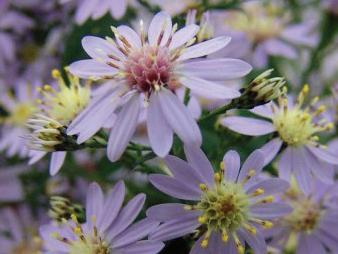
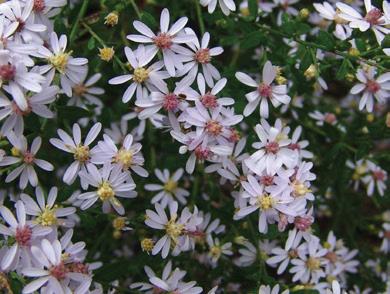
veg
2-3’ | Z 3-8 | 50
Aster divaricatus (7) syn. Eurybia divaricata white wood aster
A fairyland of glistening white small daisies in September and October. Lovely naturalized in shade in average to dry soil. Found in deciduous woods and along roadsides of the Eastern US. Blooms late August–early October.
op
2-3’ | Z 3-8 | LP50
Aster divaricatus ‘Eastern Star’ (8) syn. Eurybia divaricata
‘Eastern Star’
This selection is shorter than the species and has deep, dark shining mahogany stems and white flowers. Excellent groundcover for dry shade. It came our way from Canyon Creek Nursery, via Roger Rache, then of the Berkley Botanic Garden. Originally collected from coastal Rhode Island. Late August–early October.
veg 18-24” | Z 3-8 | 50
Aster ericoides ‘Snow Flurry’ (9) syn. Symphyotrichum ericoides ‘Snow Flurry’ white heath aster
A very low, dense carpeting groundcover that is smothered with ½” single white flowers with gold centers in September. A strong grower and a new look and use for asters. A nice cultivar for deepmedia green roof projects. Blooms late August–early October.



veg
6-8” | Z 5-8 | 72 + LP32
Where Horticulture Meets Ecology™ 877.ECO.PLUG | info@northcreeknurseries.com | northcreeknurseries.com 32
1 2 3 4 5 6 7 8 9
©Walters Gardens
Aster laevis ‘Bluebird’ (10) syn. Symphyotrichum laeve
‘Bluebird’ smooth aster
Large cone-shaped clusters of violet-blue flowers with yellow centers, an inch or more across, appear over a vase-shaped clump. Perfectly clean foliage; tolerant of various soil conditions and moisture levels. Even at 4’ tall, it needs no staking in full sun. Introduced by Mt. Cuba Center. Blooms August–September.
veg
3-4’ | Z 4-8 | 50 + LP50
Aster lateriflorus ‘Lady in Black’ (11) syn. Symphyotrichum lateriflorum
‘Lady in Black’ calico aster
Deep, red-purple foliage is a stately addition to the garden throughout the season. Smoky pink blooms
September to October. Thousands of flowers per plant—a butterfly’s dream!
veg
2-3’ | Z 3-8 | 50
Aster novae-angliae syn. Symphyotrichum
novae-angliae
New England aster
A reliably tough native in shades of purple to pink blooming in August and September. Wide, evergreen basal foliage supplies excellent erosion control; use in combination with other tall meadow species. Found along roadsides, meadows, and woods edge. Prefers a tad more moisture than A. novi-belgii. Begins blooming in August.
op
4-6’ | Z 3-8 | LP50
Aster novae-angliae
‘Grape Crush’ PP33612 (12) syn. Symphyotrichum novae-angliae
‘Grape Crush’
A bold, deep purple introduction by Walters Gardens. Growing into a neat mound, this fall-blooming aster does not splay open as other aster cultivars can, providing a beautiful profusion of saturated flowers for a fabulous fall display.

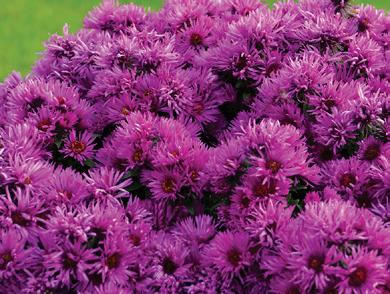

veg
26-30” | Z 3-8 | 50
Aster novae-angliae
‘Pink Crush’ PP33628 (13) syn. Symphyotrichum
novae-angliae ‘Pink Crush’
A deep pink flowering aster with a compact, uniform habit and profuse flowers in early to mid-fall. An excellent introduction by Walters Gardens, this shorter variety maintains its habit without splaying open. A bit shorter than ‘Grape Crush’.
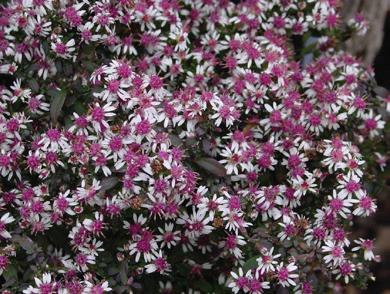
veg
20-24” | Z 3-8 | 50
Aster novae-angliae

‘Purple Dome’
syn. Symphyotrichum novae-angliae
‘Purple Dome’
A garden-worthy native from Mt. Cuba Center with a naturally compact habit and deep purple flowers in August and September. Should be cut back after flowering to prevent self-sowing. On average, begins blooming several weeks later than ‘Vibrant Dome’.
veg
18” | Z 3-8 | 50 + LP50
33 Perennials | Grasses | Carex | Ferns | Vines & Woodies
10 11 12 13
Aster novae-angliae ‘Purple Dome’
©Walters Gardens ©Walters Gardens
Aster novae-angliae
‘Vibrant Dome’ PP19538 (1) syn. Symphyotrichum novae-angliae
‘Vibrant Dome’
Bobbie Schwartz found this treasure in a patch of ‘Purple Dome’, and she suspects her ‘Alma Pötschke’ is the other parent. The result is Alma’s brilliance with the habit of ‘Purple Dome’; slightly taller. Vibrant pink flowers cover this round aster in fall. So tight and floriferous it could be mistaken for a mum if not for the intensity of its color. Begins blooming in late August.
veg
18-20” | Z 3-8 | 50
Aster novi-belgii (2) syn. Symphyotrichum novi-belgii New York aster
Local Mid-Atlantic native of moist to wet meadows, with a mixed bouquet of blue, pink, and white flowers in August and September. This upland cousin of A. novaeangliae is well suited for storm water management projects on the drier side. Establishes a strong population.
op 3-5’ | Z 4-8 | LP50
Aster oblongifolius ‘October Skies’ (3) syn. Symphyotrichum oblongifolium
‘October Skies’ aromatic aster
An intensely floriferous, lowgrowing selection. Related to ‘Raydon’s Favorite’ but more compact and starts blooming two weeks earlier. Long-blooming, densely covered with lavenderblue flowers. Excellent groundcover potential—highly tolerant of drought and poor soils.
veg
18” | Z 5-8 | 72
Aster oblongifolius (4)
‘Raydon’s Favorite’ syn. Symphyotrichum oblongifolium
‘Raydon’s Favorite’
Medium blue, fine textured single ray flowers in September and October; aromatic foliage. Irresistible—a tremendous plant. Introduced by Holbrook Farm. A. oblongifolius is found on calcareous hillsides and cliffs. This is one of the latest blooming varieties we grow and is happy in a dry, mid-height meadow.
veg
3’ | Z 5-8 | 72 + LP50
Aster tataricus ‘Jindai’ (5) tatarian daisy

A shorter form of the species; clusters of sky-blue single flowers top deep green leaves in a basal clump. A vigorous, stoloniferous plant. Found in Jindai Park in Tokyo by Rick Darke and Skip March of the U.S. National Arboretum. The latest blooming aster we grow—lasting well into October.
veg
3-5’ | Z 4-8 | LP32
Aster ‘Wood’s Blue’ (6)
Deep green foliage and single, clear medium-blue flowers with gold centers. Blooms from Augustearly October. A compact plant that works well in containers and the front of the border. From the breeding program of Ed Wood in Portland, Oregon, Wood’s Asters have a rounded pot presentation like that of a fall mum crop and are easy to grow, maintain, and sell!
veg
12-15” | Z 5-8 | 72
Aster ‘Wood’s Pink’ (7)
Virtually mildew and rust free. Compact and floriferous, a wonderful container plant. Clear pink flowers with gold centers blooming August–early October. Carefree, colorful, and compact, Wood’s Asters are an excellent addition to the fall garden.
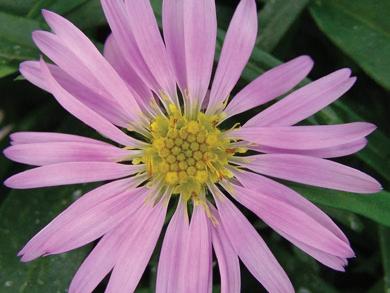
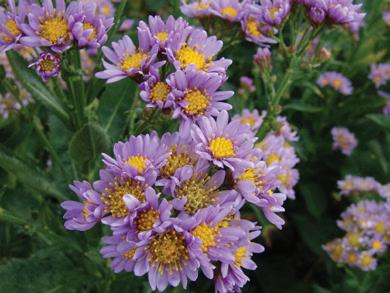
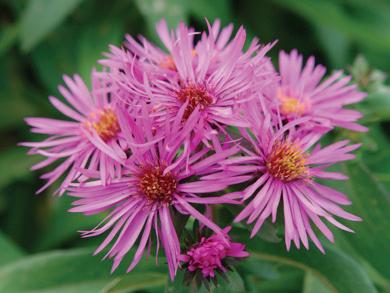
veg
12-18” | Z 5-8 | 72
Aster ‘Wood’s Purple’ (8)
Clear purple flowers cover the foliage from August–early October. Highly resistant to mildew and rust. With their uniform, compact habit and dense, long-lasting bloom, Wood’s Asters are a fall highlight at retail!
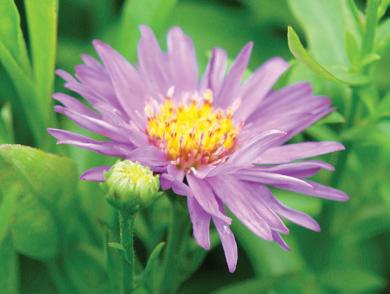

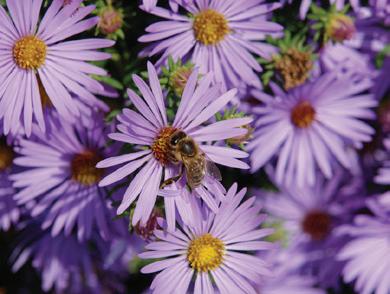

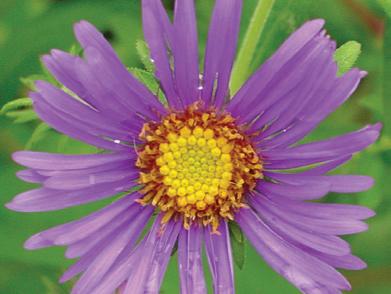
veg
12” | Z 5-8 | 72
Asteromea mongolica (9)
syn. Kalimeris pinnatifida ‘Hortensis’
Tough and easy to grow, this enchanting aster cousin is covered in hundreds of double white daisies from mid-summer to frost. Undemanding by nature, it is ideal for most any sunny garden spot and is a great container plant —fantastic in flower arrangements, too!
2-3’ | Z 4-8 | 72
Where Horticulture Meets Ecology™ 877.ECO.PLUG | info@northcreeknurseries.com | northcreeknurseries.com 34
veg
1 2 3 4 5 6 8 7 9
“ If we surrendered to earth’s intelligence we could rise up rooted, like trees. –Rainer Maria Rilke
Perennials
Baptisia
false indigo
If you are counting on spring retail color, false indigo is best potted before mid-July. All varieties are sold in trays of LP50 and ship only in active growth. For dependable overwintering, especially with vegetative cultivars, it is critical to have a well-rooted plant going into the winter season—early potting is essential!
Chrysogonum
green and gold
Baptista to Helianthus
Eupatorium
Joe Pye weed
Originally hailing from the Piedmont and coastal plains, green and gold is a lowgrowing mat-forming perennial. A perfect plant to edge along woodland garden paths, it has its main bloom in mid-spring and then sporadic blooming all the way through autumn. Performing best in bright shade or part shade situations, it likes moist, well-drained situations as well as drier ones. Each of the varieties we have selected are wonderful performers from the straight species to the production ease of ‘Allen Bush’ and the flower power of ‘Superstar’.
Coreopsis
tickseed
We’re confident you and your customers will have success with our product mix—all the best tried-and-true varieties mixed with the top-rated performers from Mt. Cuba Center’s Coreopsis trials including ‘Summer Sunshine’ and ‘Gold Standard’.
Echinacea
coneflower
Is a garden complete without coneflowers? A goldfinch and songbird favorite, the bright color and architectural quality of Echinacea make it a hit in any sunny border. Our trial program allows us to see how our product mix measures up to the unrelenting rush of new cultivars making waves in the market. We offer a colorful array of newer seed introductions from Jelitto Perennial Seeds as well as many time-tested varieties.
From mesic-moist meadows to dry coastal landscapes, this genus runs the gamut. The diminutive stature of ‘Little Joe’ works well for small gardens and containers while the taller species in our Landscape Plug line establish quickly, provide erosion control, and are salttolerant. See descriptions for details—we will only ship these plants in active growth. The botanists were at it again! Eupatorium is in the Asteraceae family and was recently recategorized. For the sake of ease, we refer to plants here as Eupatorium but note its updated specific epithet.
Geranium
cranesbill
This genus of over 400 species of plants generally hails from temperate regions around the world with access to bright light, average soil, and good drainage. A wonderful perennial for the edge of the border, geraniums provide months of bloom coupled with a rounded, compact habit. We have selected the brightest and best Geranium with the longest season of flowering and easiest care.
Helenium
sneezeweed
These Eastern US natives are attractive to butterflies and cut flower enthusiasts alike! Brightly colored corymbs loaded with flower power in full sun and moist soil. Easy to grow and ideal for spring and summer potting.
Helianthus
sunflower
One of the most recognized genera in the family Asteraceae, sunflowers brighten up the summer and autumn landscape. From the height and bright yellow of ‘Lemon Queen’ to the golden and shorter ‘First Light’, these Helianthus pack a punch!
35 Perennials | Grasses | Carex | Ferns | Vines & Woodies
Baptisia alba var. macrophylla— NEW! (1) white false indigo

A tall and lovely prairie native with long spikes of pure white flowers from May to Mid-June. Easily grown and long-lived, it is native from New York to Minnesota, Texas to Mississippi.
op
2-4’ | Z 4-8 | LP50
Baptisia australis blue false indigo
Add early season color to your meadow or perennial border. Fantastic compound foliage with blue pea-shaped flower spikes in May and early June. Native to open woods, riverbanks, and sandy floodplains. Fixes nitrogen and grows easily in average, welldrained soil. The Perennial Plant Association’s 2010 Perennial Plant of the Year®
op
3-4’ | Z 4-8 | LP50
Baptisia sphaerocarpa—NEW! (2) yellow wild indigo
A riot of yellow in late spring to early summer! A very sturdy, drought-resistant plant with striking spikes of pea-like flowers that range from butter yellow to gleaming gold. A wonderful plant for the perennial border to the naturalized grassland meadow.

op
2-3’ | Z 4-8 | LP50
Boltonia asteroides—NEW! (3) false chamomile
Lacy white daisies top long stems and cover fine-textured silver blue foliage in late summer and early fall. An undemanding native plant that is surprisingly tolerant of both drought and flood.
op 4-6’ | Z 4-8 | 50
Calamintha nepeta ssp. glandulosa ‘White Cloud’ (4) lesser calamint
Bright white flowers are larger and showier than the straight species. A great alternative to baby’s breath that is longer-lived and honestly, better smelling. Blooms from June to October. Thrives in average to dry soils.


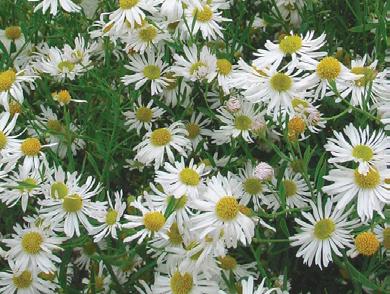
veg
1-2’ | Z 5-7 | 72
Calamintha nepeta ssp. nepeta
Blooms from June to October with airy plumes of small, barely blue flowers hovering above mintscented, oregano-like foliage. Relished by bees, the flowers resemble pale blue Heuchera when in bloom–which seems like all the time! Great in rock walls or as lighttextured filler in container plantings. The Perennial Plant Association’s 2021 Perennial Plant of the Year®
veg
12-15” | Z 5-7 | 72
Callirhoe involucrata (5) wine cups
An outstanding plant with low growing, deeply dissected foliage that gives rise to an explosion of electric purple, single, upright flowers from July to early September. Its spreading habit is reminiscent of ivy; let it drape over stone walls, creep between stones, or scramble between perennials. This tap-rooted Midwest native requires full sun and good drainage.
op
6-8” | Z 5-9 | LP50
Caltha palustris (6) marsh marigold
In early spring, this woodland plant can be found with hundreds of bright yellow buttercup flowers dotting a green carpet of shiny cordate foliage. Native to northern states and Canada, this little beauty is at home at a pond’s edge or along a stream. Clumping by nature but can seed in to form a dense groundcover in a consistently moist site. Unpalatable to deer!
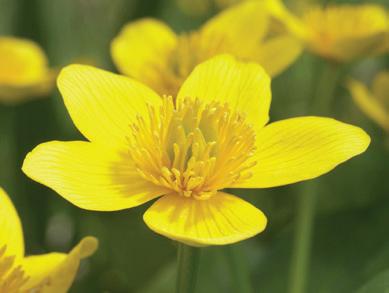
op 8-12” | Z 3-7 | LP50
Ceratostigma plumbaginoides

plumbago
(7)
Brilliant blue flowers with striking red calyces cover bright green foliage from mid-summer to fall, when the leaves turn deep red. A wonderful full-sun groundcover; it is an excellent choice for beds of spring bulbs because it emerges late, as the bulb foliage declines. Will only be shipped in active growth.
veg
9-12” | Z 4-9 | 72
Chelone glabra (8) turtlehead
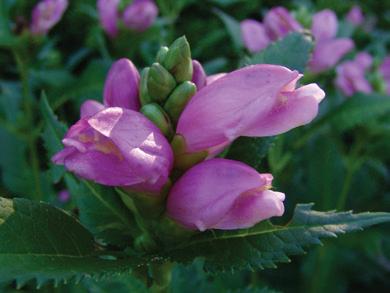
Spikes of elegant white flowers top shiny green foliage in late summer and early fall. Native to moist meadows, stream banks, and swamps. Favorite breeding site for the Baltimore Checkerspot butterfly.
op
2-4’ | Z 4-8 | 50 + LP50
Chelone lyonii ‘Hot Lips’ (9)
Bronze-green early season growth transforms to lustrous, deep green foliage topped in August and September with brilliant rose-pink turtle head-shaped flowers. Red stems persist through the season.
veg
2-3’ | Z 4-7 | 72 + LP50
Chelone obliqua Tiny Tortuga™ PP25350
Good things do come in small packages! The floriferous, pintsized presence of Tiny Tortuga™ is a quick turn for 1-gallon retail programs with undoubtable garden worthiness. Summer flowering, the hot pink blooms are a favorite of butterflies. Very compact, slow to spread, and disease resistant.
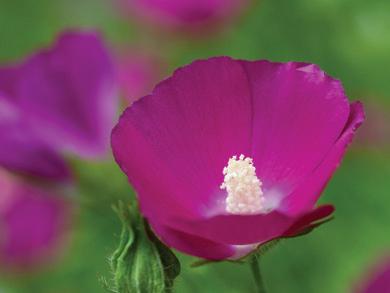
veg
18-24” | Z 4-9 | 72
Where Horticulture Meets Ecology™ 877.ECO.PLUG | info@northcreeknurseries.com | northcreeknurseries.com 36
1 2 3 4 5 6 7 8 9
Chrysogonum virginianum
‘Allen Bush’ (10)
green and gold
A strong-growing groundcover for rocky areas, this variety enjoys well-drained sites. Golden-yellow blooms dot the deep green foliage from April to June and again as temperatures cool in September and October. A fantastic production plant known for both its flower and foliage, a naturally occurring Chrysogonum found by Andre Viette of Viette Farm and Nursery.
veg
8” | Z 5-9 | 50
Chrysogonum virginianum
‘Superstar’ (11)
This green and gold is sure to be a superstar on the retail bench and in the garden! Deep green, semi-evergreen foliage is topped with golden flowers in mid-tolate spring. It is an easy native groundcover that blooms well and is a vigorous clump grower.

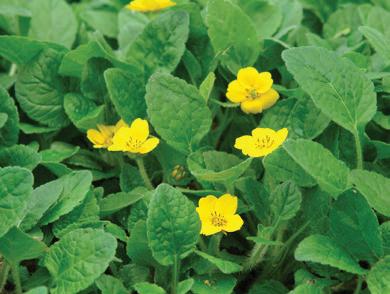

veg
6-8” | Z 5-9 | 50
Chrysogonum virginianum
var. australe (12)
A low and quite compact form with the deepest green and shiniest foliage of all the forms of Chrysogonum we have seen. A dense clumping habit with typical gold flowers in mid-to-late spring. Originally from Woodlanders, Inc.
veg
6” | Z 5-9 | LP32
Coreopsis ‘Crème Brûlée’ PP16096 tickseed
A more vigorous version of C. ‘Moonbeam’ that fills in faster in spring and has larger flowers that occur all along the stems rather than just above the foliage, lending a fuller overall appearance. Our trial gardens have proven excellent winter survival.
veg
18-24” | Z 5-8 | 72
Coreopsis ‘Jethro Tull’ PP18789 (13)
From ItSaul Plants, this stunning little guy always seems to be in bloom. A top seller in the market, this cross between ‘Zamphir’ and ‘Early Sunrise’ has broader fluted petals, a compact habit, and an extended flowering season. Responds beautifully to cutting back but will rebloom without it.
veg
12-18” | Z 5-10 | 72
Coreopsis Permathread™
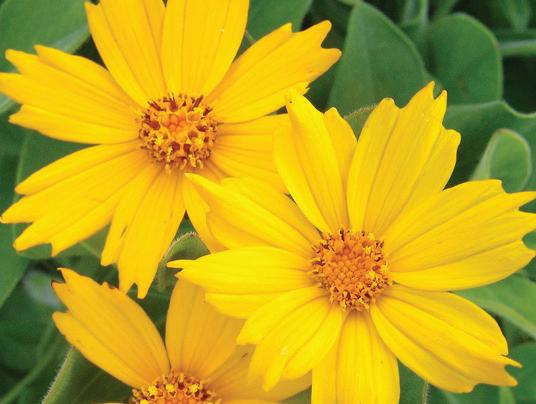

‘Red Satin’ PP25736 (14) threadleaf tickseed
A superior selection for its sturdy upright stems, fine threadleaf foliage and deep wine-red flowers that do not become “frosted” in the heat. Sterile flowers bloom all summer; cutting back will encourage rebloom until frost. Beautiful in the perennial garden or as a special accent. A selection from Darrell Probst that is not to be overlooked!
veg
15-18” | Z 5-9 | 72
Coreopsis palustris
‘Summer Sunshine’ swamp tickseed
Awarded 5 stars from Mt. Cuba Center Coreopsis trials as the most disease resistant tickseed. Vigorous mounds of foliage reach up to a sturdy 30” in height with a bright and sunny end-of-summer bloom that lasts a full 6 weeks. The latest blooming Coreopsis we offer, September and sometimes going into October. C. palustris is slower to spread and can tolerate wet roots for extended periods.
veg
3-4’ | Z 6-9 | LP50
Coreopsis pubescens

‘Sunshine Superman’ (15) star tickseed

A North Creek original, this selection blooms nonstop from mid-summer until October here with saucer-like flowers over lowspreading, slightly fuzzy foliage. Will self-sow where happy; likes hot, bright, well-drained spots but it is not fussy at all. A great, easy native plant for sun or part-shade!
scl
12-18” | Z 5-9 | 72
‘Summer Sunshine’
37 Perennials | Grasses | Carex | Ferns | Vines & Woodies
10 11 12 13 14 15
Coreopsis palustris
©Mt. Cuba Center
Coreopsis tripteris ‘Gold Standard’ tall tickseed
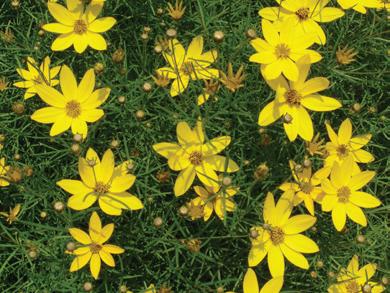
North Creek is thrilled to introduce this fabulous Mt. Cuba Center selection! ‘Gold Standard’ shows better garden performance than the straight species; it is approximately 1’ shorter and blooms for an additional 6 weeks. Flowers borne on shorter, secondary growth distribute the floral display throughout the entire habit.
veg
5-6’ | Z 4-9 | LP32
Coreopsis verticillata (1) whorled tickseed
A charming and tough landscape solution! This hardy native species is vigorous, tolerant to drought, and very easy to grow. Great in combination with grasses in a mid-height meadow. Bright yellow flowers from late May to early August and often later. Taller than ‘Zagreb’ and ‘Moonbeam’.
op
18-24” | Z 5-8 | LP50
Coreopsis verticillata ‘Moonbeam’
Glowing lemon-yellow flowers cover thread-like deep green foliage from June through September. A well-loved perennial. Always available in early spring and often sold as a spring vernalized liner—order early! The Perennial Plant Association’s 1992 Perennial Plant of the Year®.

veg
18-24” | Z 5-8 | 72
Coreopsis verticillata ‘Zagreb’ (2)
Airy, threadlike foliage is topped by an abundance of golden yellow flowers from June to September. Perfect in rock gardens and places with poor soil. Shortest of the Coreopsis verticillata we offer.
veg
12-18” | Z 5-8 | 72
Delphinium exaltatum (3) tall larkspur

A blue-flowered Delphinium for bright shade, native to woodland glades from Alabama to Pennsylvania. Ours came to us thanks to the generosity of the Holden Arboretum in Kirtland, Ohio. Spikes of spurred blue flowers top 3-6’ stems in July. Prefers average to rich soil.
op
3-6’ | Z 5-8 | 50
Echinacea ‘Cheyenne Spirit’ (4) coneflower
A 2013 All-America Selection award winner, and for good reason—they are durable, easy to grow and gorgeous! A delightful mix of colors from rich purples, pinks, reds, and oranges to lighter yellows, creams, and whites makes a bold statement in a perennial border, butterfly garden or patio container. These coneflowers do not require deadheading to maintain their flower power! The spent blooms turn to seeds, providing winter food for songbirds and architectural interest.
scl
24-30” | Z 4-9 | 72
Echinacea paradoxa (5) yellow coneflower
Relatively rare in the wild and in cultivation, this coneflower is stunning in mid-summer with its bright pure yellow flowers that consist of drooping petals surrounding a soft brown cone. Goldfinches devour the seeds in the garden. A yellow flowering purple coneflower—thus the paradox! Native to the Ozark Mountains and surrounding area.
op
2-3’ | Z 5-9 | LP50
Echinacea purpurea (6) purple coneflower
The poster child for native plants! One of the great butterfly magnets, purple coneflower has bright golden discs with long-lasting lavender-pink ray petals. Easily grown in average to dry, welldrained soils. Very drought resistant.

op
2-3’ | Z 3-8 | LP50
Echinacea purpurea (7) ‘Green Twister’

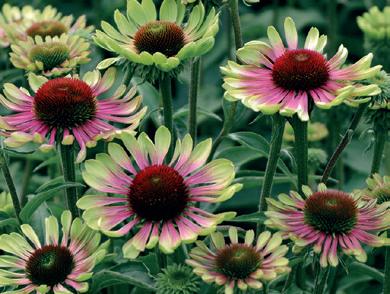
From Jelitto Perennial Seeds, ‘Green Twister’ is a compact, sturdy plant with petals that change in color from edges of lemon green to a bright carmine-red center. Colors vary by flower and with a pleasing range of color patterns. Quite a floral display from summer through autumn.
scl
2-3’ | Z 3-8 | 72 + LP32
Echinacea purpurea


‘Mellow Yellows’
A beautiful and long-lasting coneflower, ‘Mellow Yellows’ is a Jelitto seed introduction that ranges from light yellow to the deepest golden with bright orange centers. Flowering in its first season, this sturdy and reliable plant is an excellent cut flower and a reliable source of nectar and seed to pollinators and wildlife.
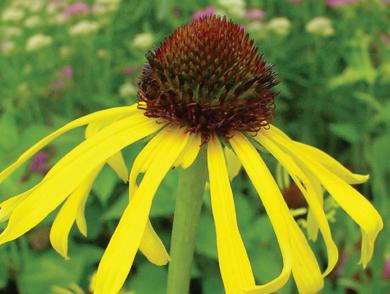
scl 2-3’ | Z 3-8 | 72
Echinacea purpurea ‘Magnus’ (8)
Named by Klaus Jelitto for Swedish nurseryman Magnus Nilsson, who carefully selected Echinacea for ten years, searching for fine form, dark hue, and very horizontal petals. You’re looking at the result of that exhaustive work. Prominent dark orange discs are surrounded by reddish-pink ray petals throughout summer. The Perennial Plant Association’s 1998 Perennial Plant of the Year®.
scl 2-3’ | Z 3-8 | 72
Echinacea purpurea (9)
PowWow® White
Lend a classic look to your garden with PowWow® White’s graceful, downward arching and bright white ray petals and bright yellow cones. This variety is well-branched for summer-to-frost flower power! Amazing in a sunny perennial border or wildlife garden. Easy to grow and very adaptable to heat, humidity, drought, and poor soils.
scl 20-24” | Z 3-8 | 72
Where Horticulture Meets Ecology™ 877.ECO.PLUG | info@northcreeknurseries.com | northcreeknurseries.com 38
1 2 3 4 5 6 7 8 9 ©Jelitto
Echinacea purpurea PowWow® Wild Berry (10)


Up the WOW factor in your garden with this 2010 All-America Selection award winner! This spectacular variety is very well-branched for profuse blooms summer to frost. Brilliant rose-purple flowers retain color longer without fading and will bloom without the need for deadheading. Easy to grow and very adaptable to heat, humidity, drought, and poor soils.
scl
20-24” | Z 3-8 | 72 + LP32
Echinacea purpurea ‘Ruby Star’ (11)
A European seed cultivar with exceptionally large flat-topped flowers that are a deeper purplepink than most others. A further improvement on ‘Magnus’, reaching 2-3’ in the landscape.
scl
2-3’ | Z 3-8 | 72 + LP50
Echinacea purpurea ‘White Swan’ (12)
Beautiful, pure white flowers attract butterflies and birds from June to September. Adaptable coneflower that is tolerant of drought, heat, humidity, and poor soil.

scl
2-3’ | Z 3-8 | 72
Erigeron pulchellus var. pulchellus ‘Lynnhaven Carpet’ (13) Robin’s plantain
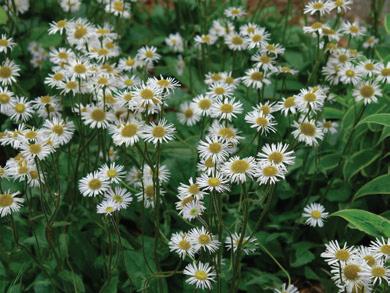
This outstanding form of E. pulchellus was selected for its relatively large gray-green pubescent foliage, dense matforming habit, and astonishing ability to thrive in a wide range of challenging conditions. In early May, individual flower stalks give rise to lightly tinted lavender flowers with a yellow inner eye. Foliage remains less than 6” and forms a tight groundcover, while flowering stems top out at just over a foot tall. Originally found growing on the 27-acre property of Clarice Keeling—named after Virginia Beach’s Lynnhaven River by plantsman Charles Cresson.
veg
6-12” | Z 3-8 | LP32
Eryngium yuccifolium rattlesnake master

A unique and eye-catching plant for a dry, sunny site. Slightly spiny leaves are arranged in a rosette that resembles Yucca. Flower stems shoot skyward in summer and are topped with thistle-like bluish-silver flowers. An architectural addition to the perennial border or meadow. Found in moist and dry sandy soils in open woods, fields, or prairies from Virginia to Minnesota, south to Texas and Florida. A songbird’s favorite snack.
op
4-5’ | Z 5-9 | LP50
Eupatorium ‘Phantom’ PP18354 (14) Joe Pye weed
This short and sweet dwarf variety is fantastic for use in perennial borders, rain gardens, and mixed containers with its shorter stature and upright habit. Attractive domeshaped clusters of tiny, rosy-purple blooms are a favorite of butterflies, lasting from mid-summer to fall before turning into tufts of seedheads. Clump-forming with coarse leaves on sturdy stems.
veg
2-4’ | Z 4-8 | LP32
Eupatorium coelestinum (15)
syn. Conoclinium coelestinum blue mistflower

A haze of blue flowers in September and October on attractive, dark red stems. Works well as a cut flower, naturalizes easily, provides excellent erosion control. A great groundcover species for a mid-height meadow. Attractive to butterflies and bees. Can be aggressive in Southern gardens. Takes full sun with adequate moisture.
op 2-3’ | Z 6-11 | LP50
Eupatorium dubium


‘Little Joe’ PP16122
syn. Eutrochium dubium
‘Little Joe’
Selected by Steve Lighty while at The Conard-Pyle Co., this diminutive Joe Pye has the vivid color of ‘Gateway’ at a height more suitable for small gardens. Compact in a container.
veg
4-5’ | Z 5-9 | 50 + LP32
39 Perennials | Grasses | Carex | Ferns | Vines & Woodies
10 11 12 13 14 15
Eryngium yuccifolium
Eupatorium dubium
©Future Plants
‘Little Joe’
Eupatorium fistulosum (1) syn. Eutrochium fistulosum
A highly functional, long-lived species bearing gigantic, rounded mauve-pink flower heads from July to September. Ideal species for mesic to moist meadows or storm water management plantings. Plays well with taller companions such as Aster and Helianthus. Irresistible to pollinators.
op 5-8’ | Z 4-8 | LP50
Eupatorium maculatum—NEW! (2) syn. Eutrochium maculatum spotted Joe Pye weed
A native prairie plant that lives happily in sunny, wet soils.
Mauve-pink flowers bloom in late summer to early fall. Flowers attract swallowtail butterflies, and the foliage provides food for species of moth caterpillars.

op
4-7’ | Z 4-8 | LP50
Eupatorium perfoliatum
common boneset
White-topped flowers over deep green foliage from late summer to early fall. Tolerant of both wet and dry soils. Commonly found at wood’s edge, along paths, and in moist meadows.
op 3-4’ | Z 4-8 | LP50
Eupatorium purpureum
Euphoria™ Ruby PPAF (3) syn. Eutrochium purpureum
Euphoria™ Ruby
A compact, early flowering variety of the classic summer flowering native perennial. Its small size makes it perfect for growers and homeowners alike while its earlier flowering is a delight to pollinators. This is Darwin Perennial’s answer to the age-old customer question in garden centers: “I like this, but do you have something that grows smaller?”
veg 24-32” | Z 4-8 | LP32
Eupatorium purpureum
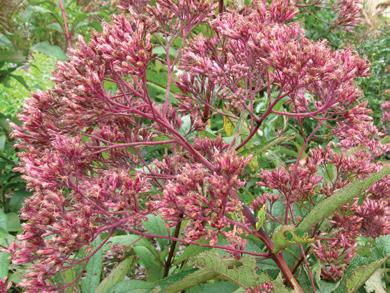
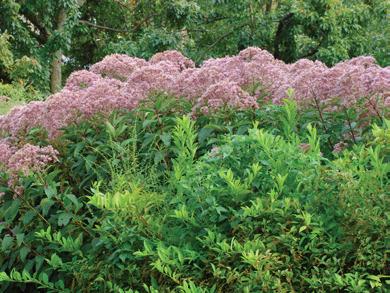
ssp. maculatum ‘Gateway’ syn. Eutrochium purpureum ssp. maculatum ‘Gateway’
More compact than the straight species, this selection is very popular and grows shorter and bushier with tighter and thicker inflorescences. Huge mauve-pink flower clusters atop deep wine-red stems late in the summer.
veg
5-6’ | Z 4-8 | LP32
Euphorbia amygdaloides var. robbiae (4) wood spurge
An evergreen plant that is excellent in sun or shade. A carefree, slowly spreading groundcover with shiny, deep green, leathery leaves. Yellow green disk-like bracts back tiny yellow flowers in late spring. Looks fantastic in a pot and in the garden. Perfect for dry shade—unbeatable!
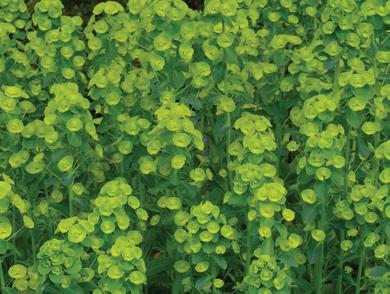
veg
12-18” | Z 5-7 | 50
Gaura lindheimeri Rosyjane®
‘Harrosy’ PP22290 (5) syn. Oenothera lindheimeri ‘Harrosy’ beeblossom
Clear white, 4-petaled flowers with a candy-pink picotee. Flowers bloom along tall, flexible stems throughout summer. Open, vaseshaped habit; quite tolerant of heat, humidity, and drought once established. Requires well-drained soil.
veg
18-24” | Z 5-9 | 72
Gaura lindheimeri ‘Siskiyou Pink’ (6) syn. Oenothera lindheimeri ‘Siskiyou Pink’
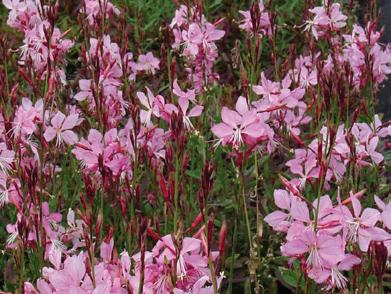

Wine-red buds opening to rosepink flowers with white stamens from June-October. A shorter statured, quick-to-finish variety with darker foliage. A Siskiyou Nursery introduction.
veg
18-24” | Z 5-9 | 72
Gentiana ‘True Blue’ PP20433 bottle gentian

We are delighted to offer this selection from hybridizer Darrel Probst! Large, 2” bright blue flowers are present mid-summer into early autumn. Semi-glossy, medium green foliage is arranged oppositely along sturdy, well-branched stems. Happiest in average garden soil with sufficient moisture.
tc 15-20” | Z 4-7 | 50
Geranium ‘Azure Rush’ PP22684 (7) cranesbill
‘Azure Rush’ is low-growing, compact, and gently fills an area with its fragrant foliage. ‘Azure Rush’ is generously covered with light blue 2 ½” blooms. Everything you’ve come to love and anticipate from ‘Rozanne’ is true + improved this sweet, lighter blue selection!
tc 14-16” | Z 5-8 | 50
Geranium ‘Rozanne’ PP12175 (8)
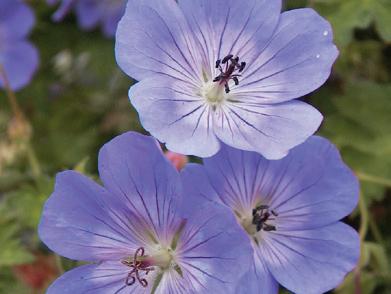
An easy, carefree geranium from Blooms of Bressingham; a strong grower with a sprawling, ever-blooming habit. The finely cut foliage is accented by large blue-purple flowers with pale blue eyes that cover the plant from early summer to frost. Most prolific in full sun- will require more moisture there. ‘Rozanne’ is a naturally occurring sterile hybrid of G. himalayense and G. wallichianum
‘Buxton’s Variety’. The Perennial Plant Association’s 2008 Perennial Plant of the Year®.
tc 15-18” | Z 5-8 | 50
Geranium macrorrhizum
‘Bevan’s Variety’ (9) bigroot geranium

A spring and summer show of magenta-pink flowers blanket sprawling, aromatic sweeps of palmately divided foliage. Thick rhizomes and stout stems expand into a dense groundcover and guarantee this hardy geranium’s survivor status. Leaves acquire a reddish tinge in the fall.
veg 8-12” | Z 4-8 | 50
Where Horticulture Meets Ecology™ 877.ECO.PLUG | info@northcreeknurseries.com | northcreeknurseries.com
40
1 2 3 4 5 6 7 8 9
©Ball Seed
Geranium macrorrhizum
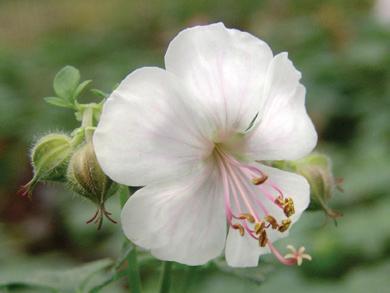
‘Ingwersen’s Variety’ (10)
A great groundcover geranium, this selection has been working hard in gardens since 1929. Tried-and-true in the garden for over 90 years with light pink flowers and dark sepals. Tolerates bright shade and drier soils. Order early, it sells out fast!


veg
12-18” | Z 4-8 | 50
Geranium maculatum cranesbill
This great woodland native is easy to grow in most shady spots. It flowers in spring with pink or lavender blooms. Found in open woods, clearings, wood edges, and roadsides throughout the Eastern US.
veg 8-12” | Z 4-8 | LP32
Geranium maculatum ‘Espresso’ (11)
A gift from our very own backyard—a selection from the woods of Landenberg! Pale lavender-pink flowers over attractive copper-mocha foliage. A bold fresh look for our native cranesbill, useful as a groundcover or shade garden feature plant. G. maculatum is found in open woods, clearings, wood edges, and roadsides.
tc 8-12” | Z 4-8 | LP32
Geranium × cantabrigiense

‘Biokovo’ (12)
Cambridge geranium
A wonderful landscape groundcover for part shade or sun featuring white flowers with light pink veins and stamens. Red to orange fall color is outstanding. Easy plants for shade or bright edge conditions. A naturally occurring hybrid discovered in the Biokovo Mountains in Croatia. The Perennial Plant Association’s 2015 Perennial Plant of the Year®.
veg
6-8” | Z 4-8 | 50
Geranium × cantabrigiense ‘Karmina’ (13)
Hundreds of spring blooming carmine-rose flowers quickly form a respectable carpet atop lowgrowing foliage. Great bright orange to red fall color.
veg
10-12” | Z 4-8 | 50
Helenium ‘Mardi Gras’ PP15124 sneezeweed
Jazz up the garden with a festival of multicolored blooms in midto-late summer. Chestnut cones are surrounded by yellow petals splashed with bright orange and streaked with red. Gorgeous in a pot! Heat resistant, great as a cut flower with long sturdy stems and long vase life. An early pinch back helps promote branching.
tc
36-40” | Z 4-8 | 50
Helenium autumnale (14) common sneezeweed
Our local native with single yellow ray and disc flowers often tinged orange or mahogany. Stout, branching stems in late summer. A good upland or floodplain meadow plant—needs support from sturdy companion species. Found in moist fields, along riverbanks and in alluvial thickets. Heleniums are naturally resistant to deer and rabbits.
op
3-5’ | Z 3-8 | LP50
Helianthus ‘Lemon Queen’ (15) sunflower
A free flowering plant to brighten up the mid and late summer garden. Covered in intense lightyellow single 2-3” flowers from July until September. An irresistible butterfly plant.
veg
6-8’ | Z 4-9 | LP32
Helianthus salicifolius ‘Autumn Gold’ PP30117

willowleaf sunflower


Blooming from September to a hard frost, ‘Autumn Gold’ is a wonderful addition to the perennial garden. A compact selection of willowleaf sunflower, the narrow, dark green leaves form into a tight mound, giving it a shrub-like appearance from spring through summer before it erupts into color in the fall.
veg
24-26” | Z 5-9 | 50
41 Perennials | Grasses | Carex | Ferns | Vines & Woodies
10 11 12 13 14 15
Helianthus salicifolius ‘Autumn Gold’
Helianthus salicifolius
‘First Light’ PP13150 (1)
An explosion of golden yellow flowers in combination with its manageable height makes ‘First Light’ the first choice. Dark green, fuzzy clumps of linear foliage produce spikes of flowers from September through October upon upright, sturdy stems. A wonderful source of color late in the season— hats off to Keith Hammett!
veg
3-4’ | Z 5-9 | 50
Heliopsis helianthoides (2) smooth oxeye
This local native sunflower happily naturalizes in moist or dry conditions. Bright, 2” single medium-gold flowers for 8 weeks, peaking in July. Imagine a selfsowing butterfly magnet that also doubles as a bird feeder in the fall. Found in floodplains, fields, and at wood’s edge.
op
4-6’ | Z 3-9 | LP50
Heliopsis helianthoides
var. scabra ‘Bleeding Hearts’ (3)
Dark purple foliage and black stems provide a perfect foil for the blooms, which begin at fire red, to orange-red, and turn to bronze as they fade. Begins blooming in its first year and blooms from June to mid-October.
scl
3-4’ | Z 3-9 | LP32
Heliopsis helianthoides
var. scabra ‘Burning Hearts’ (4)
Long summer bloom for the perennial border or cutting garden. Flowers are semi-double with golden yellow ray petals and a deep orange-yellow center disk. Profuse and lengthy mid-to-late summer blooms are supported by dark purple stems and enjoyed by a host of pollinators.

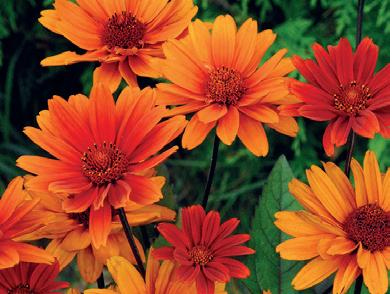


Helleborus Brandywine™ Lenten rose
We are delighted to have introduced this magnificent series from hellebore breeder David Culp! This superior seed strain boasts beautiful dark reds, spotted pinks, picotees and apricots, along with doubles and anemones. A keen eye, hand pollination, and years of careful selection mean beautiful plants for your customers! A staple along the woodland edge and the go-to for mass planting.

Where Horticulture Meets Ecology™
42
scl
3-4’ | Z 3-9 | 50 + LP32
1 2 3 4 Helleborus Brandywine™
op 12-18” | Z 4-8 | LP32
©Jelitto
©Jelitto
Perennials
Heuchera to Monarda
Heuchera alumroot

Our rigorous trialing program allows us to firmly stand behind the wide array of foliage colors and textures in our alumroot collection. Happiest in moist, well-drained soil in bright shade, but will grow in full sun with consistent moisture. Ethereal flowers bloom spring and fall. Pot year round.
Iris blueflag
When it comes to range of color, stature, and bloom period, there is an iris suitable for nearly all garden environments. Our offerings provide a pop of early spring color by way of blooms, stems, and foliage! Punctuate the return of spring with the effervescent foliage of ‘Purple Flame’, or cluster dwarf crested iris along your favorite spring path—site nearby a convenient vantage point to enjoy hummingbirds and butterflies!
Monarda beebalm
A timeless garden standard, beebalm has delighted both bees and gardeners for generations. Our offerings include varieties that have stood the test of time, high scorers from Mt. Cuba Center’s Monarda trials, and strong straight species that excel in attracting pollinators. All are bound to please with their characteristic showy flowers, long bloom time, and presence in the garden.
43 Perennials | Grasses | Carex | Ferns | Vines & Woodies
Heuchera villosa ‘Caramel’
Heuchera ‘Citronelle’ PP17934 (1)
A top-selling and strong growing alumroot with incredible pot presentation. A happy accident in the production of ‘Caramel’, ‘Citronelle’ channels the vigor of H. villosa into bright chartreuse foliage for shade.

tc 12-18” | Z 4-9 | 72
Heuchera ‘Frosted Violet’ PP15085 (2)
This Primrose Path introduction is dependable, tough, and vigorous— not to mention stunningly beautiful! Consistent, velvety-purple leaves with darker veins are topped with pale pink flowers in late spring. With its H. villosa parentage, it is a long-lived favorite of ours.
tc 12-18” | Z 4-9 | 72
Heuchera ‘Green Spice’—NEW!
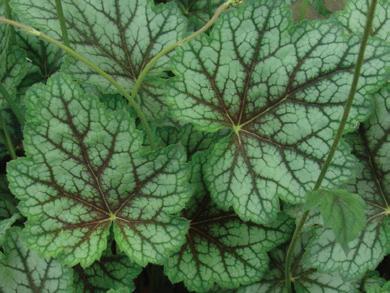

This Heuchera spices up the shade garden! With dark red venation in spring transitioning to cool greens and silvers in the summer, it wraps up its foliage show with orangeyrust colors in fall. This groundcover is perfect for brightening up dull spots, edging along a garden path, or intermingling with other interesting textures to liven things up. Voted a fan favorite in Mt. Cuba Center’s 2014 Heuchera report!
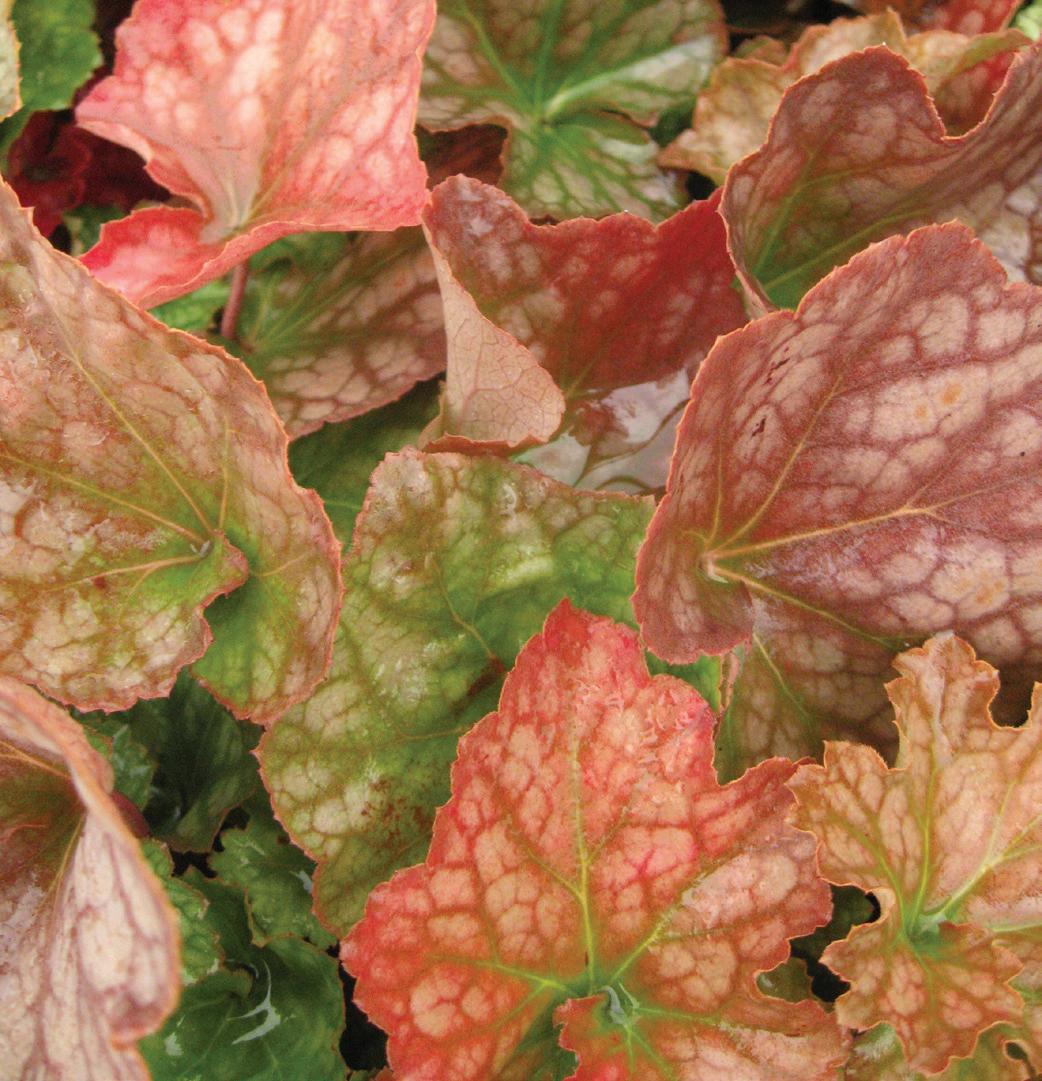
tc 16-30” | Z 4-9 | 72
Heuchera ‘Plum Pudding’ (3) Shiny, dark purple-red ruffled leaves with echoes of silvery marbling and attractive pink flower clusters in early and mid-summer. An excellent selection for East Coast growing; heat and humidity tolerant. Very popular!
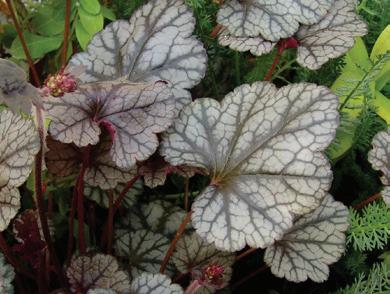

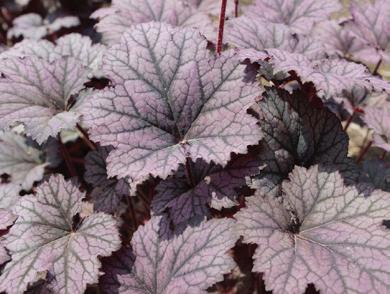
tc
1-2’ | Z 4-9 | 72
Heuchera ‘Silver Scrolls’ PP12066 (4) Metallic silver leaves are bordered and veined with deep wine red. Very trim habit, forming a neat mound. Exceptionally vigorous for a Heuchera and gorgeous in a gallon pot! A prodigious introduction from The Primrose Path.
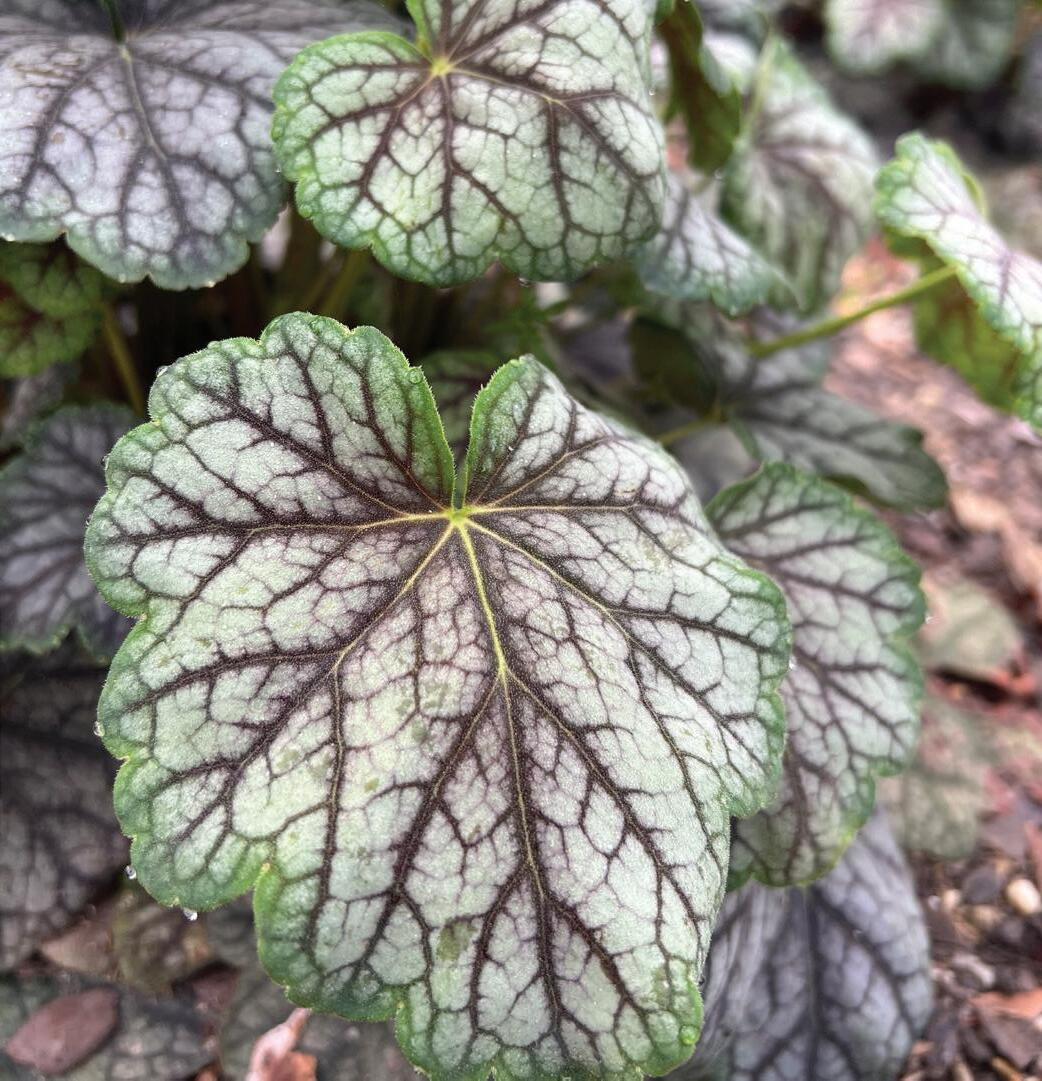
tc 12-18” | Z 4-9 | 72
Heuchera americana ‘Dale’s Strain’ (5) American alumroot
This seed propagated strain, named after plantsman Dale Hendricks, is an outstanding selection with unique silver-blue marbled foliage often streaked in burgundy accents. Blooms with white flowers in spring. Excellent groundcover for shade or part shade.
scl
12-18” | Z 4-7 | 72 + LP32
Heuchera longiflora longflower alumroot
A beautiful display en masse, the long flowering stems of this alumroot sway high above deep green foliage mottled in silver highlights. Tubular calyces surround the pale-yellow flowers and securely affix them to upright stems; expect flowering late May into June and fruiting July through August.
8-14” | Z 5-8 | LP32
Heuchera
(6)
Fuzzy chartreuse to lime green, nearly evergreen foliage graced in September with fountains of pure white flowers, until frost. An easycare plant tolerant of dry shade and a wide variety of conditions. Happiest in medium to bright shade. A tough groundcover that doubles as a cut flower! Named and introduced by Bluemount Nurseries in Monkton, MD.
Where Horticulture Meets Ecology™ 44
op
macrorhiza ‘Autumn Bride’
scl
1 2 3 4 5 6
2’ | Z 3-8 | 50 + LP32
Heuchera ‘Green Spice’ Heuchera longiflora
Heuchera micrantha
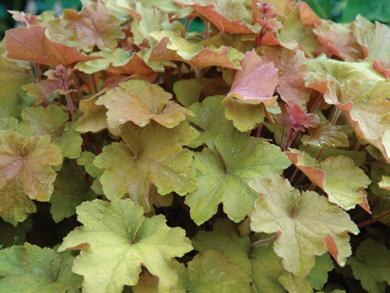
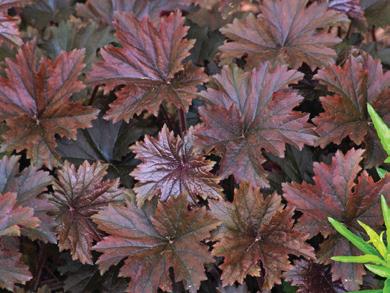

‘Palace Purple’ (7)
A tried-and-true variety with lustrous deep purple foliage—an industry favorite as well as well as one of ours! Dainty, bell-shaped blooms are white to green on mahogany stems. An attractive accent in the garden or cut flower arrangement. The Perennial Plant Association’s 1991 Perennial Plant of the Year®
scl
12-18” | Z 3-8 | 50
Heuchera villosa ‘Bronze Wave’ (8) hairy alumroot
A sturdy, fall flowering shade groundcover with spikes of petite, creamy white flowers. A shiny, almost lacquered finish adds unique color to the landscape. Goes toe-to-toe with tree roots and comes out looking good.
tc
2’ | Z 3-8 | 72 + LP32
Heuchera villosa
‘Caramel’ PP16560 (9)
Bred by Thierry Delabroye, the emerging foliage has a glowing apricot hue fading to soft amber in summer. Intense salmon red fall color. Lobed fuzzy foliage typical of H. villosa. An eastern US native species that is plenty hardy and unsurpassed for longevity, even in the prolonged heat and humidity of the South. Long panicles of creamy white flowers in late summer.
tc
12-18” | Z 4-8 | 72
Hibiscus moscheutos (10) swamp rosemallow
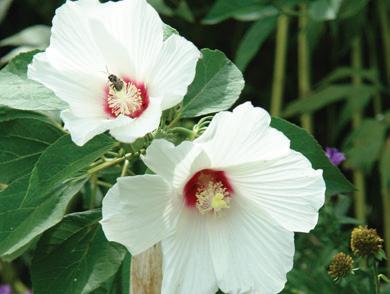
Graceful pale pink to white 3-4” flowers from August to September. Grayish-green, cordate foliage with white undersides. Grows in wet to inundated conditions and tolerant of brackish water. Emerges late but stands its ground in a stormwater management planting. Not an anchor species but certainly the icing on the cake, especially en masse. In the wild, it can be found in ditches, swamps, marshes, and shallow standing water.
op 3-7’ | Z 5-8 | LP50
Hypericum calycinum
St. John’s wort
A widely used and attractive evergreen groundcover. Deep green, oval leaves and 2” gold flowers with pincushion-like centerclustered stamens in late spring and early summer. Most content in cooler areas away from drying winter winds although quite tough once established.

veg 15-18” | Z 5-7 | 72
Hypericum calycinum ‘Brigadoon’ (11)
A bright groundcover for shady sites! Golden yellow, oval leaves with reddish edges. Blooms from late spring to early summer—you will find the yellow flowers blending in among the sea of gold! Prefers loose, well-drained soils in partial sun.
veg 15-18” | Z 5-7 | 72
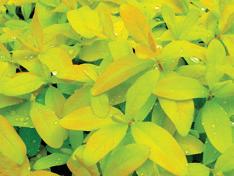
45
7 8 9 10 11 Perennials | Grasses | Carex | Ferns | Vines & Woodies Hypericum calycinum ©Mt. Cuba Center
Iris cristata (1)
dwarf crested iris

Blue-violet flowers in early spring, carpeting the woodland garden or lightly shaded perennial border. Will naturalize to form a beautiful native groundcover. Likes rich, welldrained soil.

tc
6-8” | Z 5-8 | 50
Iris cristata ‘Powder Blue Giant’
Considerably more robust than the species, this sweet giant boasts 3” flowers of delicate light blue with golden crests and deep blue accents. Vigorous and easy to grow!
tc
6-8” | Z 5-8 | 50
Iris cristata ‘Tennessee White’
Kindly shared with us by Don Shadow. A vigorous spreader and prolific bloomer—the fan-like foliage is covered with brilliant white flowers accented by a delicate yellow crest; its late spring show starts earlier and lasts longer than the other selections we’ve tried.
tc
6-10” | Z 5-8 | 50
Iris versicolor (2) blueflag
An emergent aquatic species happiest in marshes, bogs, and wet meadows but tolerant of average garden conditions as well! Dramatic display of large, violet-blue flowers. Flowers in May and June. Pair with Osmunda regalis, Chelone glabra, and Eupatorium perfoliatum
op
2-3’ | Z 2-7 | LP50
Iris versicolor ‘Purple Flame’


Plainly stated, it is a showstopper. Beyond other Iris selections on the market, ‘Purple Flame’ has a richer, more intense cast to stems and flowers, yes. However, the true beauty lies in the irresistible foliage. Emerging in March, the purple flame-like foliage provides an unparalleled performance of vivid and intense eggplant-purple foliage followed by an encore of rich and abundant flowers. Shared with us by Mt. Cuba Center.
tc
2-3’ | Z 2-7 | LP50
Kalimeris incisa ‘Blue Star’ (3) Japanese aster
A wonderful container plant with long retail shelf life and rewarding garden performance. Loves heat and humidity and breezes through a drought. Single 1” pale blue, daisy-like flowers on a compact mound of foliage. Not a runner.
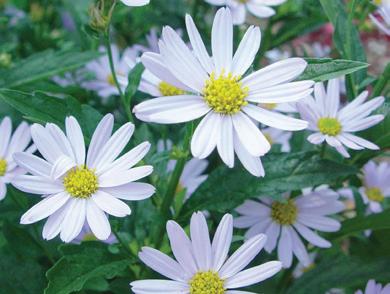
veg
18” | Z 5-9 | 72
Kalimeris integrifolia ‘Daisy Mae’ (4)
Between ‘Daisy Mae’ and ‘Blue Star’ we are hard pressed to say which is easier to grow—both are production friendly and finish beautifully for retail. This selection has all the same top-notch attributes of its cousin but with single 1” white daisy-like flowers. A butterfly garden essential.
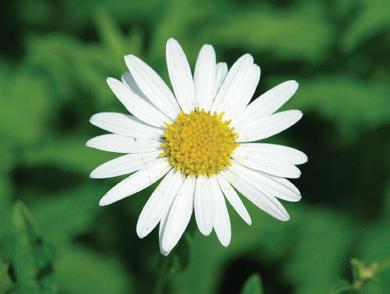
veg
2’ | Z 5-9 | 72
Lavandula × intermedia Phenomenal™ ‘Niko’ PP24193 (5) lavender

Developed and introduced by our dear friends at Peace Tree Farm, we are proud to stand behind this truly phenomenal selection. A breeze in production and touted as one of the hardiest lavenders seen throughout Europe and the United States, Phenomenal™ has exceptional winter hardiness and equal resilience when it comes to extreme heat and humidity. A breeze in production with abundant reward in the perennial border—the robust flower presentation and fragrance are undeniable.
veg
2-3’ | Z 5-9 | 50
Lavandula × intermedia
Sensational!® ‘Tesseract’ PP31786 (6)
From Peace Tree Farm comes the next generation of lavender! What makes it different from Phenomenal™? With large, thick flowers and sturdy, silver stems, this lavender has a dense habit and great branching. The flowers are packed with that trademark lavender scent with low camphor notes. Peace Tree has improved its heat and humidity tolerance, as well as its cold tolerance, making this plant a powerful addition to a wider range of gardens!
veg 24-30” | Z 5-9 | 50
Where Horticulture Meets Ecology™ 46
1 2 3 4 5 6 Iris versicolor ‘Purple Flame’
Leucanthemum × superbum

‘Becky’ (7)
Shasta daisy
A long-lived, large-flowered perennial with single white flowers from June to July. Stands up superbly to the Southern heat. Cut back to encourage rebloom. Likes average to dry soil. The masses of crisp, bright blooms make an excellent cut flower and are an impactful element of the seasonal border. The Perennial Plant Association’s 2003 Perennial Plant of the Year®.
veg
2-3’ | Z 4-9 | 50
Liatris microcephala (8)
smallhead blazing star

The smaller cousin of L. spicata with fine-textured, deep green foliage. This species is tolerant of clay and drought, sending up a bevy of flower spikes of tassellike, rosy-purple flowers in August and September. Unique to the genus, the flowers open from top to bottom. Carefree and adored by butterflies.
veg
18-24” | Z 4-7 | 72
Liatris spicata
blazing star
Equally content in wet or dry environments, the purple upright flower spikes look beautiful peeking through low-growing grasses. A reliable garden performer with seasonal appeal into the winter months as seedheads persist. Pennsylvania provenance; vernalization not required.

op
3-5’ | Z 3-9 | LP50
Lobelia cardinalis (9) cardinal flower
A garden is not complete without cardinal flower. Clump-forming habit with brilliant red flower spikes set against green and purplebronze foliage. Each individual spike of scarlet flowers opens from bottom to top and stays in bloom for weeks on end. Thrives in wet meadows and rain gardens and will happily self-sow from seed.

op
2-4’ | Z 3-8 | 72 + LP50
Lobelia cardinalis
‘Black Truffle’ PP25687
Stunning in the perennial border and perfect for rain gardens, this cardinal flower is sure to stand out with is dark, chocolateypurple foliage and bold red flowers. This superior selection holds this deep foliage color all season long! Introduced by Peter Heus and brought to market by Plants Nouveau. A magnet for hummingbirds and butterflies!
tc
3-4’ | Z 5-8 | 50
Lobelia siphilitica (10) great blue lobelia
All the flower power of its cousin L. cardinalis, but with spikes of brilliant, true-blue late summer flowers. Flourishes in moist soil with filtered shade but will adapt to drier conditions with more shade.
op
2-3’ | Z 4-8 | 72 + LP50
Lysimachia lanceolata
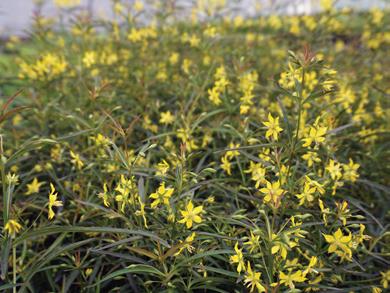
‘Burgundy Mist’—NEW! (11) lance-leaved loosestrife
The short stature, continuous sunny bloom, and deep wine coloring of this native plant make it one of our new favorite groundcovers. We love its carefree, tough nature, heat tolerance, and how it spreads via rhizomes to cover the ground and suppress weeds. Bright, star-like yellow flowers bloom throughout summer just above contrasting, fine-textured maroon foliage. Easy to grow, delightful year-round, and the living embodiment of ‘green mulch.’
veg
12-24” | Z 4-8 | LP32
Meehania cordata (12)
Meehan’s mint
Join us in putting Ajuga, Vinca and Lamium to rest by incorporating Meehan’s mint into your native groundcover lineup! This MidAtlantic all-star hugs the ground, suppresses weeds, and commands full attention in bloom. In late spring, trailing stems give way to a sea of blue flowers with speckled throats. Mix with Scutellaria, Thalictrum, Carex, or Chrysogonum

veg
6-10” | Z 5-8 | 50+ LP32
Mertensia virginica (13)
Virginia bluebells

A much-anticipated harbinger of spring, the ephemeral beauty of Virginia bluebells emerges in accord with the acoustics of spring peepers, tucking in perfectly amongst swaths of native ferns, sedges, and woodland phlox. Pendulous, trumpet-shaped flowers are pink at first blush and later transition to a sea of soft blue. Just as lovely is the faint blue cast to the foliage. Limited shipping window; summer dormant.
veg
18-24” | Z 3-8 | LP32
Monarda ‘Judith’s Fancy Fuchsia’—NEW! (14) beebalm
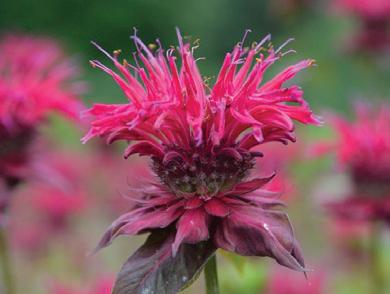
A taller beebalm cultivar with sturdy, upright stems and purplishred hues that are a standout in the garden. Peak bloom occurs for over 3 weeks. An industry favorite selected and named by Peter Heus. A fan favorite in Mt. Cuba Center’s Monarda trials thanks to superior resistance to powdery mildew.
veg
3-4’ | Z 3-8 | 72
Monarda ‘Petite Delight’ PP10784
A standout selection that speaks for itself—having earned a valued spot on our availability for decades! Looking for a fiercely fragrant, compact beebalm? Consider ‘Petite Delight’! Lavender-pink flowers in July and August atop deep green, shiny foliage. Average to dry soil conditions—equally as lovely in container or upfront in the perennial border.
veg
12-15” | Z 3-8 | 72
Monarda ‘Purple Rooster’—NEW! (15)

The darkest, truest purple flowers to come out of Mt. Cuba Center’s Monarda trial—this selection has upright rigid stems, strong verticality, and a rough, sandpapery texture to its foliage. Very resistant to powdery mildew.
veg
30-36” | Z 3-8 | 72
47 Perennials | Grasses | Carex | Ferns | Vines & Woodies
7 8 9 10 13 11 14 12 15 ©Mt. Cuba Center ©Mt. Cuba Center
Monarda ‘Raspberry Wine’ (1)
A steadfast selection from White Flower Farm, the buds of ‘Raspberry Wine’ truly resemble the tasty fruit and bloom a lovely wine-red hue from June through August. Foliage emerges in early April with a beautiful maroon cast. Mildew resistant and a pollinator favorite!
veg
3-4’ | Z 3-8 | 72
Monarda bradburiana (2) eastern beebalm
One of our first beebalms to bloom—you can expect the two-lipped, pink to light lavender flowers to appear in early May. Showy flowers are enveloped in burgundy bracts and carry a purple tracking along the lower lip. Quick to follow will be the butterflies and hummingbirds—these blooms create quite the frenzy.
op
1-2’ | Z 4-8 | LP50
Monarda didyma



‘Gardenview Scarlet’ (3)
One of the most mildew resistant Monarda varieties available. A classic variety with rose-red flowers on stems rising to 3-4’ tall. Blooming from June to August, this long-flowering Monarda is especially beautiful when massed in drifts to attract butterflies, bees, and hummingbirds.

veg
3-4’ | Z 3-8 | 72
Monarda didyma ‘Jacob Cline’ scarlet beebalm
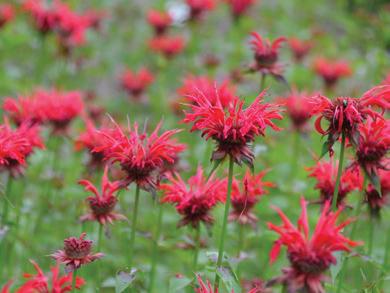
This is the ticket as far as mildew resistant beebalms. ‘Jacob Cline’ is a tall, vigorous, and long blooming selection with fragrant, energetic red flowers and high ornamental appeal. Blooms early June through July—the tried-and-true standard when it comes to red blooming Monarda. Enjoy!
veg
3-5’ | Z 3-8 | 72 + LP50
Monarda fistulosa (4) wild bergamot
A popular and showy wildflower bearing clusters of pink to lavender-purple flowers mid-June through August. Wild bergamot is a great naturalizing wildflower and a magnet for butterflies and hummingbirds—and more tolerant of drought and resistant to powdery mildew than M. didyma
op
2-5’ | Z 3-8 | LP50
Monarda fistulosa ‘Claire Grace’
A selection of our native wild bergamot with soft lavender, pincushion-like flowers that rest just above shiny green foliage. Quite mildew resistant with attractive shiny foliage.
veg
3’ | Z 3-8 | 72 + LP50
Monarda punctata (5) spotted beebalm
We sought out a native spotted beebalm to add depth to our ecological line and landed swiftly on Monarda punctata. It produces stands of tiered pink bracts on sturdy, upright stems reaching nearly 3’ tall. Fragrant, creamy white to yellow flowers with purple spots sit just above the bracts. A pollinator magnet and perfect for the midheight meadow.
op
24-30” | Z 3-9 | LP50
Nepeta ‘Early Bird’ (6) catmint
Aptly named, it’s the first from our catmint collection to bloom–that ‘Early Bird’ getting the job done by attracting early season pollinators whilst the rest of the crew still slumbers. Gray-green aromatic foliage with lavender-blue flowers from early April into May! Excellent groundcover for average, welldrained soils.
veg
10-12” | Z 3-8 | 72
Nepeta Junior Walker™ PP23074 (7) Extend the floral abundance with Nepeta Junior Walker™, flowering from mid-May through September. Junior Walker™ retains the nonreseeding quality of its popular parent ‘Walker’s Low’ at one-third the size. A rock-solid selection from Star Roses & Plants and one of Colorado State University’s Top Perennial Performers. A mid-season haircut will promote a new flush of growth and prolong flowering.
veg
12-18” | Z 5-9 | 72
Nepeta × faassenii
‘Purrsian Blue’ PP24788 (8)
Stands out from the crowd with its small, perfectly rounded, densely branched habit—this selection from Walters Gardens is a staff favorite! Great for planting along the edge of rock gardens, this compact catmint is also a great scale for container plantings.


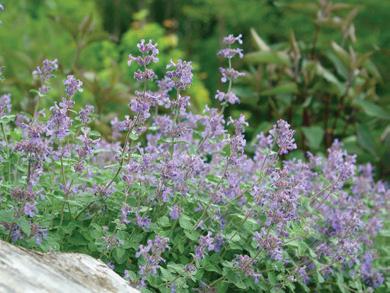
veg 14-18” | Z 3-8 | 72
Nepeta × faassenii ‘Walker’s Low’
We have a long-standing relationship with this selection— and for good reason—it does not disappoint! Available from The Creek since ’97, this prolific bloomer is the tallest variety in our catmint collection with a carefree, sprawling nature, bright gray-green leaves, and soft-lavender flowers indicative of the genus. The Perennial Plant Association’s 2007 Perennial Plant of the Year®
veg 24-30” | Z 5-9 | 72
Oenothera fruticosa (9) sundrops

A versatile and reliable perennial with great early summer color for dry meadows. Buds begin red and open into beautiful, bright yellow flowers. Stems and leaves are thin and hairy with a reddish cast. Will self-show to establish a strong population.
op 15-24” | Z 4-9 | LP50
Where Horticulture Meets Ecology™ 877.ECO.PLUG | info@northcreeknurseries.com | northcreeknurseries.com 48
1 2 3 4 5 6 7 8 9
©Mt. Cuba Center
©Walters Gardens
Oenothera fruticosa ‘Fireworks’
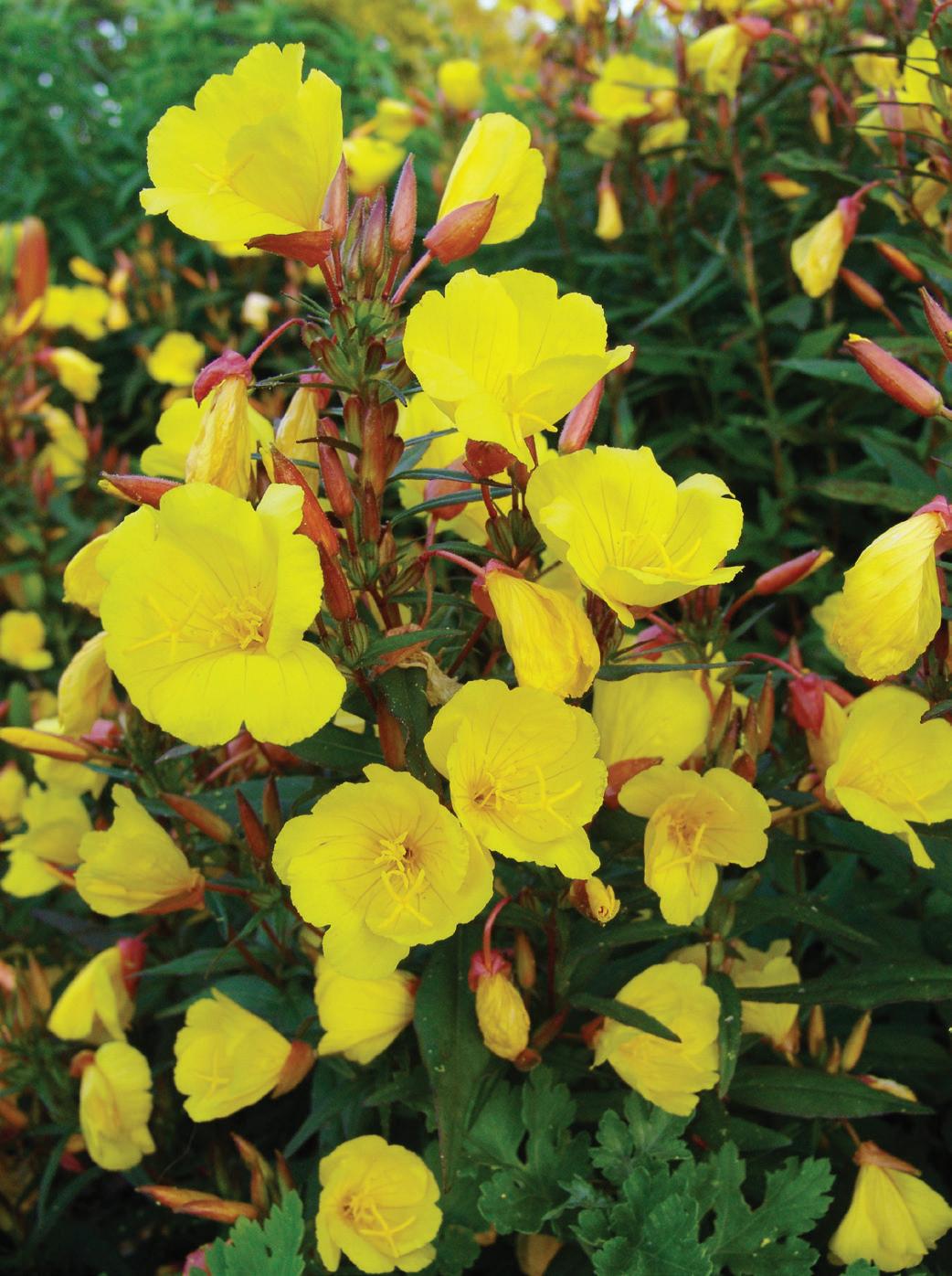
Handsome bronze foliage is beautifully contrasted by vivid, canary-yellow blooms in June. Although individual flowers are short-lived, they bloom in succession over a prolonged period of two months. The true joy of this variety is the evergreen reddish winter show. Compact habit and a pollinator favorite.
veg 15-18” | Z 4-9 | 72 + LP50
Oenothera speciosa—NEW! (10) pink evening primrose
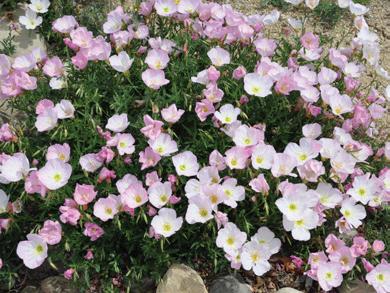
A vigorous perennial that spreads readily to from dense mats of low-growing foliage. Covered with fragrant, pink to white blooms spring through summer! Easy, dependable, and tough, it can spread significantly, particularly in well-drained soils. Native to rocky prairies and plains, this plant spreads by seed and rhizome and is a great candidate for naturalizing an area.
op 18-24” | Z 4-9 | 72
Pachysandra procumbens (11) Allegheny spurge
Fragrant, bottle-brush flowers brighten the early spring woodland garden—ultimately becoming camouflaged by a tapestry of lush green foliage. The foliage has scalloped margins and takes on an attractive pale silver mottling with time. Will slowly spread by rhizomes.
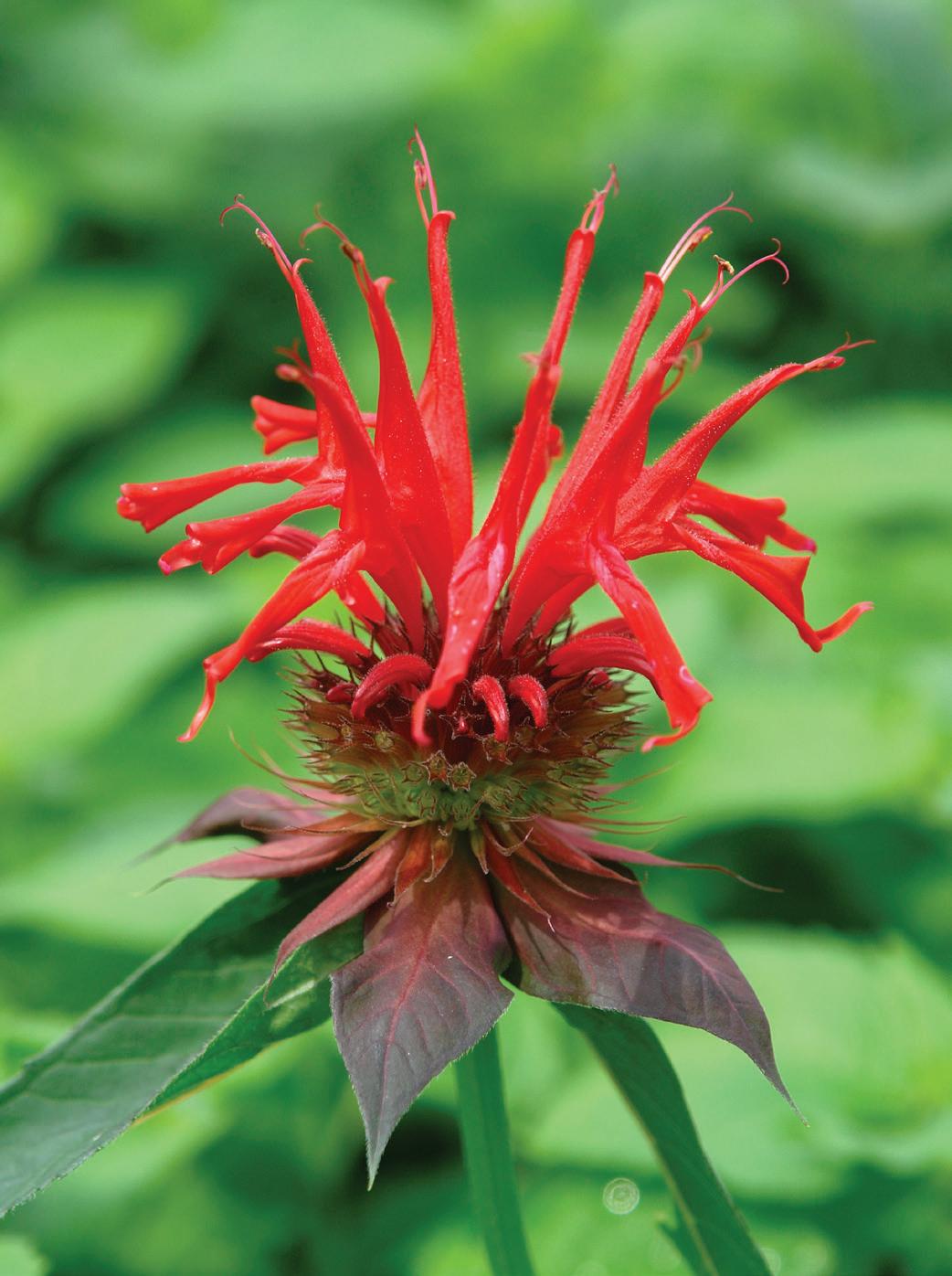
tc 6-10” | Z 4-9 | LP32
Packera aurea (12) syn. Senecio aureus golden ragwort
Full sun to shade, Packera packs a punch with its utilitarian disposition. Golden, daisy-like blooms over dense rosettes of cordate, evergreen basil foliage in late April. Prefers moist soil and partial shade; however, will thrive in full sun with adequate moisture. Spreads readily by seed and rhizomes, forming large stands. Cut back flowers prior to going to seed to minimize wind dispersal.
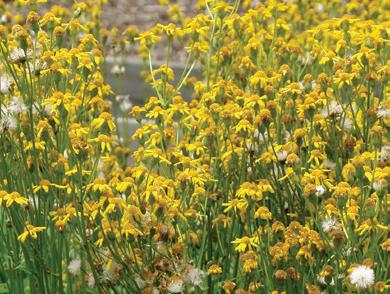
tc 12-18” | Z 4-9 | 50 + LP50
Packera obovata (13) roundleaf ragwort
A tough groundcover, roundleaf ragwort is similar to its cousin, P. aurea, but with smaller, more rounded individual leaves and the ability to withstand drier, full-sun conditions without losing its verdant appearance! Excellent native groundcover.

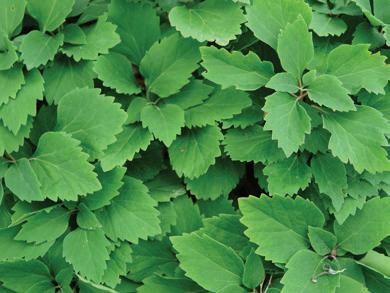
veg 12-18” | Z 3-8 | LP32
Penstemon ‘Blackbeard’ PPAF (14) beardtongue
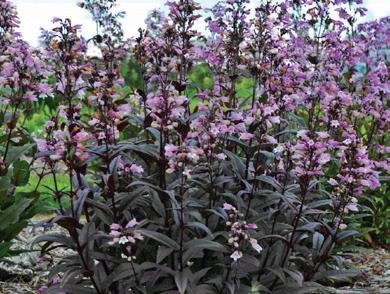
Named in honor of the infamous English pirate Blackbeard, this Walters Gardens introduction has the richest of eggplant foliage with bright lilac-purple flowers which rise high above and bloom through the summer. Multiple seasons of interest and a magnet for hummingbirds and bees, this unique selection is sure to cause a delightful cry of “Shiver me timbers!” Well-drained soils are best to avoid root rot.
veg 28-34” | Z 3-8 | 50
49 Perennials | Grasses | Carex | Ferns | Vines & Woodies
10 11 12 13 14
Monarda didyma
‘Jacob Cline’
Oenothera fruticosa ‘Fireworks’
©Walters Gardens
50 Penstemon digitalis (1)


Basal rosettes of lustrous, darkgreen foliage provide excellent winter erosion control and produce early summer blooming white to light pink, tubular 1” flowers on branching stalks. Prefers average to moist, well-drained soil in full to partial sun. Tolerant of drought but grows poorly in heavy clay soils.
op 3-4’ | Z 3-8 | LP50
Penstemon digitalis ‘Husker Red’
This standout selection has been in the trade for what seems like forever—and for good reason!
‘Husker Red’ tolerates heat and high humidity, stands up to winter wet, is undesired by deer, and attracts a host of beneficial insects and pollinators. Moreover, the foliage carries a maroon hue and provides dramatic appeal along the perennial border and as a backdrop for its white flowers.
scl
24-30” | Z 3-8 | LP50
Perovskia ‘Little Spire’ (2) Russian sage
An excellent garden performer characterized by its upright and relatively compact habit, shorter and more abundant flowering stems, dark purple flowers, and floriferous nature—this pintsized beauty is your go-to for an intimate, small scale garden where abounding fragrance and pollinators are a must and low maintenance is the added bonus.
veg
2’ | Z 4-9 | 72
Perovskia atriplicifolia (3) ‘Blue Steel’
A seed cultivar with upright silver stems covered in a mist of lavender-blue flowers. The perfect plant to intermingle textures in flower borders, it is tough as steel and adds cool color through the late summer. A favorite of butterflies and bumblebees, avoided by deer, and able to withstand the sweltering temperatures of summer—what’s not to like?
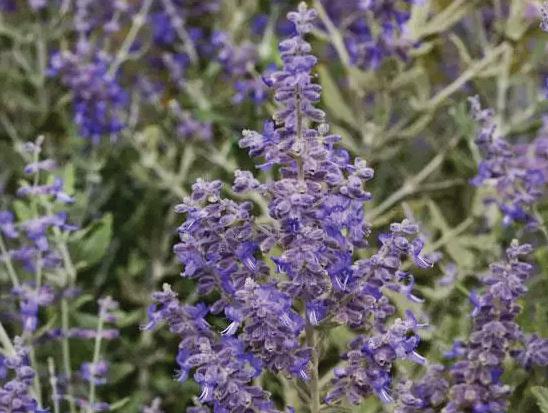

scl
28-34” | Z 4-9 | 72
Einstein
Where Horticulture Meets Ecology™
1 2
3
“
Look deep into nature, and then you will understand everything better.
–Albert
Penstemon digitalis ‘Husker Red’
Perennials
Phlox
phlox
Phlox to Tiarella
Sedum stonecrop
There is phlox for every season! With the range of bloom times of this genus of garden favorites, you will never find yourself short on flowers. Starting with ‘Sherwood Purple’ as a harbinger of spring, flourishing into the fragrant flowers of ‘Blue Moon’ and ‘May Breeze’, bursting into the iconic summer bloom of ‘Jeana’, closing with ‘Kim’ as the season fades into fall—Phlox will delight until season’s end.
Rudbeckia orange coneflower
Coneflowers grace the summer garden with their cheerful, bold, long-lasting flowers. Rudbeckia are striking with clear yellow, golden, to bold orange blooms—ranging impressively from 1’ to 7’ tall! Our native coneflowers define the season through summer and early autumn, but it’s not just us who adore them—their flowers are loved by pollinators and seeds are relished by goldfinches.
Salvia garden sage
Long-blooming, low-maintenance performers in the perennial border, Salvia are essential elements of the summer garden! The characteristic spires of these reliable plants bloom for weeks on end. Perfectly happy in full sun, the striking floral display can be extended with deadheading. We offer our staple Salvia varieties as well as an assortment of exciting new additions.
Beloved groundcovers with succulent foliage and bright flowers, Sedum never fail to entice us with unique shades and shapes and arresting floral displays. These foundational green roof plants thrive in tough, dry environments—bring on the sun, drought, and thin soils! The name sedum comes from the Latin sedeo meaning ‘to sit,’ a reference to the habit of these plants, which are often found sitting on rocks.
Solidago goldenrod
Our Solidago collection certainly runs the gamut–but all their bold yellow blooms mean autumn abounds! These famous fallflowering native perennials are outstanding performers. We offer a range from clumping to spreading, full sun extending to full shade, and all beloved by a host of pollinators such as bees, flies, and wasps. Excellent additions to restoration projects and garden settings alike, there is a goldenrod to suit your site.
Tiarella foamflower
The fine, delicate flowers of Tiarella are nothing short of magic in the spring. This vigorous woodland groundcover carpets the forest floor with fairy-like plumes of white to pink flowers and charming, heart-shaped foliage. The name Tiarella comes from the Greek tiara meaning ‘small crown,’ a reference to shape of the fruit.
51 Perennials | Grasses | Carex | Ferns | Vines & Woodies
“
Those who contemplate the beauty of the earth find reserves of strength that will endure as long as life lasts.
–Rachel Carson
52
Phlox carolina ssp. carolina ‘Kim’ (1)
thickleaf phlox
Bright pink five-petaled flowers are open and airy, resting just above bright green, linear foliage, blooming summer into early autumn. Forms a nice mat along the front of the perennial border. Stems are sturdy; mildew-resistant foliage remains clean throughout the growing season.
veg
18-24” | Z 5-9 | 72
Phlox divaricata ‘Blue Moon’ (2) woodland phlox
A long-time North Creek favorite introduced by the New England Wildflower Society, ‘Blue Moon’ was selected for larger overlapping flower heads, outstanding color, and its full and abundantly fragrant array of violet-blue flowers. Works well with Tiarella, Geranium ‘Espresso’, and a host of woodland ferns.
veg
12-18” | Z 3-8 | 72 + LP32
Phlox divaricata ‘May Breeze’
A small-statured selection with loose clusters of fragrant, pale blue to nearly white flowers that are loved by butterflies! Will fill in around bulbs or perennials that are late to emerge. A standout introduction from Piet Oudolf.

veg
12-15” | Z 3-8 | 72
Phlox paniculata ‘Jeana’ (3) garden phlox
A garden is not complete without Phlox ‘Jeana’! This selection possesses outstanding mildew resistance with varying shades of sweetly scented, lavender-pink flowers, vibrant mid-summer through early autumn. Flower clusters create a tiered effect along upright, multi-stemmed branches. An industry favorite—expect a flurry of pollinator activity!

tc 4-5’ | Z 3-8 | 50 + LP50
Phlox stolonifera
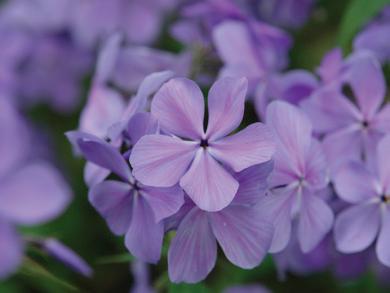
‘Sherwood Purple’ (4) creeping phlox
Masses of star-like, clear purple flowers in spring with deep green foliage. A valuable early nectar source for pollinators. This beautifully vibrant groundcover is a welcome sign of spring in the shade or woodland garden!
veg
6-10” | Z 5-8 | 72 + LP32
Physostegia virginiana
‘Miss Manners’ PP12637 (5) obedient plant
Noted for its well-behaved, nonspreading habit. Compact, clumpforming, excellent secondary branching and good rebloom. Pure white snapdragon-like flowers June to September over deep green, glossy foliage.
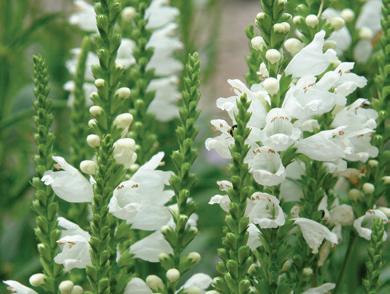
veg
18-24” | Z 3-9 | 72
Physostegia virginiana
‘Pink Manners’ PP23482
Darrell Probst has done it again with this taller sport of ‘Miss Manners’. Adorned by tubular flowers in shades of lavenderpink from midsummer through autumn. As expected, it holds an upright, clump forming habit with attractive medium green foliage. An adaptable and easy-to-grow native; the flowers are beloved by bees!
veg
36” | Z 3-9 | 72 + LP50
Polemonium reptans (6) Greek valerian
A spring beauty by all accounts— this native woodland gem provides lush texture with its delicately segmented foliage and April color with loose nodding clusters of bellshaped pale blue flowers. A finetextured groundcover for average to moist soil.




op
12-18” | Z 4-8 | LP32
Polemonium reptans
‘Stairway to Heaven’ PP15187
A variegated selection brought to us by Bill Cullina. Foliage is a wash of green and yellow strokes with leaf tips brushed by shades of pink in the cooler spring temperatures. Perfect for massing in the spring woodland garden.
tc 15-18” | Z 4-8 | 72
Porteranthus trifoliatus (7) syn. Gillenia trifoliata Bowman’s root
Carefree native for bright shade or partial sun that tolerates tree root competition. Compact habit, mahogany stems, and ethereal white flowers with red petioles. Tolerates drought once established. Foliage turns up the contrast with the onset of autumn with its deep bronzy red cast. Interesting form and unique seedheads persist into winter.
tc 2-3’ | Z 4-8 | LP32
Porteranthus trifoliatus ‘Pink Profusion’ (8)
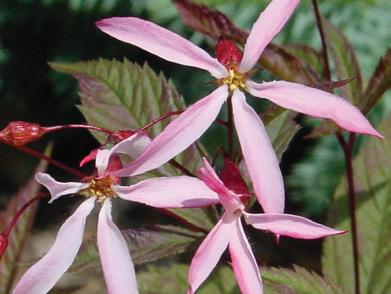
Discovery by Virginia plantsman Paul James, this selection has all the sought-after qualities of the straight species but with a profusion of perfectly pink flowers. Easy-to-grow native that tolerates most garden soils but thrives in moist, rich, woodland soil. Best planted in groups for full floral impact. Introduced by Mt. Cuba Center in 2001.
tc 24-30” | Z 4-8 | LP32
Pycnanthemum flexuosum (9) syn. Koellia hyssopifolia Appalachian mountain mint
We have come to love the utility of our Pycnanthemum collection. P. flexuosum works hard to stabilize soil and spreads slowly via rhizomes. While the roots are getting the job done, upright stems are busy producing mounds of fuzzy white flowers. A richly aromatic summer standout— blooming over a lengthy period, and larval host for the Gray Hairstreak Butterfly.
Where Horticulture Meets Ecology™ 877.ECO.PLUG | info@northcreeknurseries.com | northcreeknurseries.com
2-3’ | Z 4-8 | LP50 1 2 3 4 5 6 7 8 9
veg
Pycnanthemum muticum (10) clustered mountain mint
A highly competitive perennial for extreme sites and slopes, P. muticum performs well from full sun to shade and dry-to-moist conditions. Pleasantly aromatic, the leaves are broad, lustrous, and topped by showy silver bracts that function as pollinator landing pads. Dainty, light-pink flowers are enjoyed by an assortment of bees. Interesting winter seedheads. Needs room to move about!
veg
2-3’ | Z 4-8 | LP50
Pycnanthemum tenuifolium— NEW! (11) narrowleaf mountain mint
Densely branched with slender, lanceolate foliage—this species has a more delicate appearance than P. muticum but with all the same pollinator-attracting influence. Like its mountain mint brethren, this species spreads handsomely via rhizomes and creates a wonderful cloud of white blooms in late summer.
op 24-30” | Z 4-8 | LP50
Pycnanthemum verticillatum
var. pilosum NEW! (12) hairy mountain mint
An attractive clump-forming native perennial with silver foliage. When the white flowers bloom in summer, they are covered in bees and butterflies. The seeds are loved by birds, this species makes a powerful addition to a pollinator habitat hub!
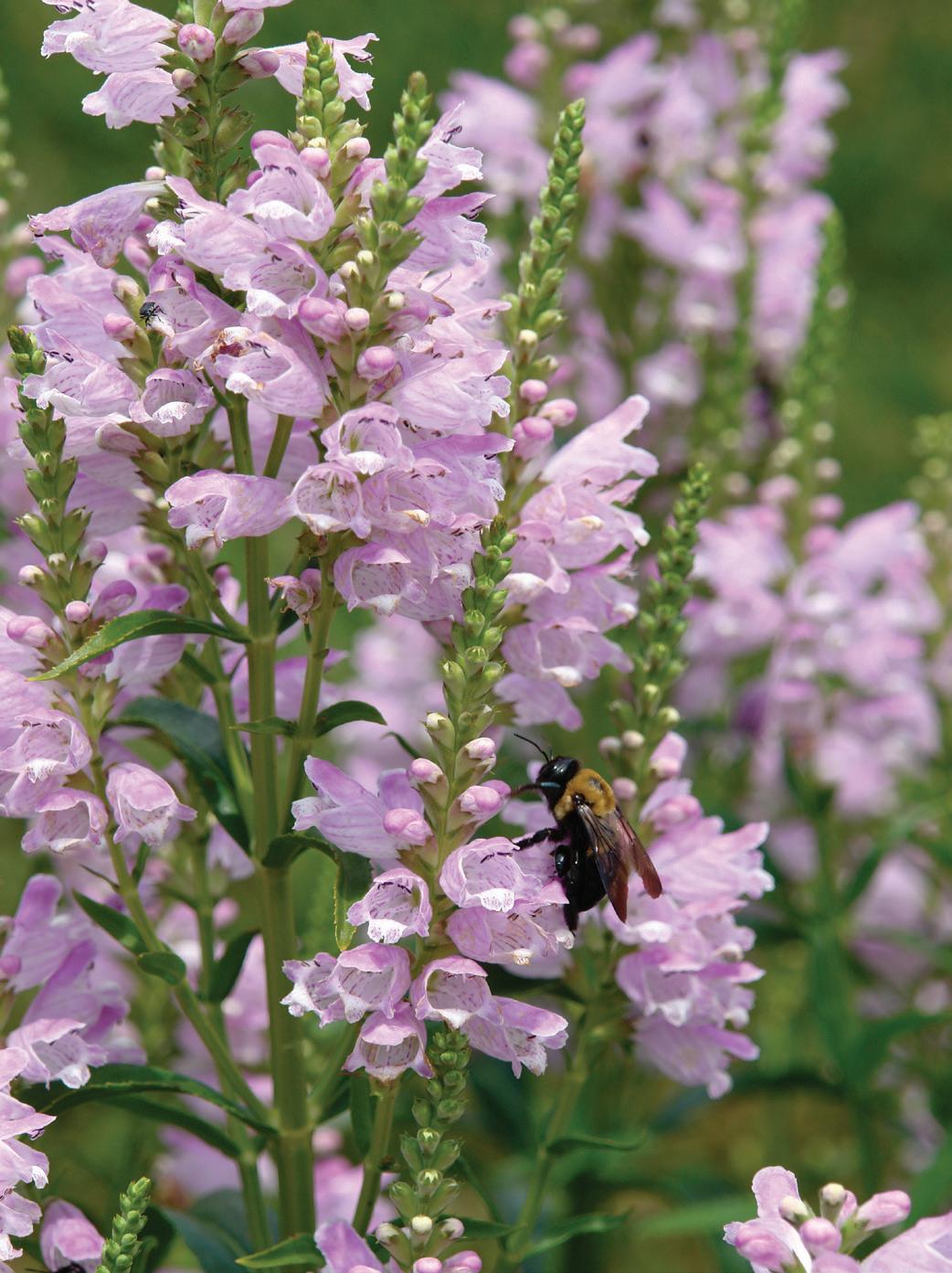

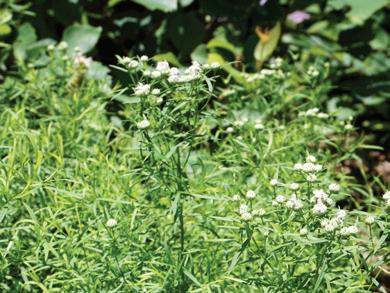

op
1-3’ | Z 4-8 | LP50
Ratibida columnifera
‘Red Midget’ (13) upright prairie coneflower

Fun, unique flowers bloom above mounds of fine green foliage from June until frost. Long, prominent cones give way to wide, reflexed petals in shades of deep reddishbrown, orange, and yellow. A native prairie plant, this dwarf variety performs exceptionally well in hot and dry conditions.
scl 18-36” | Z 3-8 | 72
Ratibida pinnata
prairie coneflower
This iconic Midwestern prairie native has a skirt of golden yellow ray petals that reflex from the base of a brown coneflower. Excellent for naturalized, meadow and pollinator gardens as well as en masse plantings. Thrives in average to dry, well-drained, clay or sandy soil. Incorporating with tall meadow grasses, Monarda fistulosa, and Agastache foeniculum is sure to entice pollinators of all types.

op
3-5’ | Z 3-8 | LP50
Rubus calycinoides (14) creeping raspberry
Living mulch—if you need a durable groundcover, your search ends in success with creeping raspberry. The crinkly foliage shades out weeds, stabilizes soil, and puts on quite a show with its burgundy fall color. Four seasons of interest, but not of interest to deer.

veg
6” | Z 6-9 | 50+ LP32
53 Perennials | Grasses | Carex | Ferns | Vines & Woodies
10 11 12 13 14
Physostegia virginiana
‘Pink Manners’
Ratibida pinnata
©Prairie Moon
Rudbeckia ‘American Gold Rush’ PP28498—NEW!
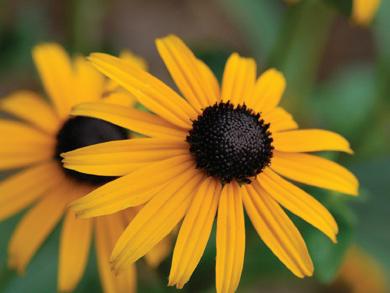
A stunning introduction from Brent Horvath of Intrinsic Perennials. This compact coneflower has a domed, uniform habit and is fantastic as a focal point, en masse, or in containers. This long-blooming selection is densely covered in flowers for weeks on end! Resistant to septoria leaf spot due to its thinner, hairier leaves. The Perennial Plant Association’s 2023 Perennial Plant of the Year®.
tc 18-24” | Z 5-9 | 72 + LP50
Rudbeckia fulgida ‘Goldsturm’ (1)
A garden classic with bold texture and upright habit, blooming July to September. Average to dry conditions, incorporate with a mixture of warm season grasses, Liatris, Echinacea and Perovskia
Allow seedheads to persist through winter, as this will provide fodder for birds. Needs vernalization. The Perennial Plant Association’s 1999 Perennial Plant of the Year®.
scl
2-3’ | Z 5-7 | 72 + LP50
Rudbeckia fulgida var. deamii (2)
Deam’s coneflower
While there may be a bounty of coneflowers on the market, what makes this one especially excellent is its effortless ability to wrap strength, beauty, and both disease and pest resistance into all it gives to the garden. Very deserving of the prestigious Award of Garden Merit from the Royal Horticultural Society in 1993—grow it, you will understand why!
op 2-3’ | Z 4-9 | LP50
Rudbeckia fulgida var. fulgida (3)

Shiny, deep green foliage.
Smaller and finer than Rudbeckia ‘Goldsturm’ with 10 weeks of flowers from July to October. Six weeks after ‘Goldsturm’ is brown, this plant is at its peak! Excellent cut flower. Average to dry soil; no vernalization.

op 24-30” | Z 5-7 | 72 + LP50
Rudbeckia fulgida var. sullivantii ‘Little Goldstar’ PP22397
This knee-high performer is a knockout in the landscape! Selected for copious floral display and dwarf habit with increased manageability, this variety has excellent branching and forms a compact clump. A bit more floriferous than ‘Goldsturm’, flowers are held high above rich, green foliage and bloom from July into October.
tc
12-16” | Z 4-9 | 72
Rudbeckia laciniata (4) cutleaf coneflower
Elegant, bright yellow petals surround green cones August to September. A striking moist meadow and streamside native wildflower adaptable to most conditions. Spreads by rhizomes, likes room to grow.
op
5-8’ | Z 5-7 | LP50
Rudbeckia laciniata ‘Autumn Sun’ syn. Rudbeckia ‘Herbstsonne’
Ideal for the back of a border, the stately habit of this selection boasts daisy-like flowers for 8+ weeks in mid-to-late summer. Loose clusters of clear yellow ray flowers with large green cones which darken with age. Reliably cold hardy. Mix with Panicum and Eupatorium
tc
5-6’ | Z 5-9 | LP32
Rudbeckia maxima (5) great coneflower
If you plant it . . . the goldfinches will come! Large clumps of glaucous, powder-blue basal foliage give rise to towering, sturdy stems topped with traditional golden-yellow ray petals and an elongated central cone—the perfect perch from which pollinators feast. A showstopper en masse—also beautiful in a bioswale or rain garden.
op
6-7’ | Z 5-8 | LP32
Rudbeckia subtomentosa



‘Henry Eilers’ (6) sweet coneflower
We cannot get enough of ‘Henry Eilers’! The only quilled variety we offer, individual florets are rolled lengthwise and create a very playful presence along the perennial border. Flower stalks begin their ascent in June and are in full flower from August through September. Excellent cut flower with fragrant foliage.
veg
4-5’ | Z 5-7 | LP32
Rudbeckia triloba (7) three-lobed coneflower
Hundreds of small golden flowers from July through autumn. A shortlived perennial that self-seeds well, naturalizing in the landscape. Good for moist areas and very drought, heat, and pest tolerant. Georgia Gold Medal Winner in 1997.
op
2-3’ | Z 5-7 | LP50
Rudbeckia triloba ‘Prairie Glow’ (8)

With brightly colored flowers with a red eye fading to a glowing orange-bronze, this native beauty brings fire to the sunny border. Its multi-branching habit provides dense flower cover—more so than the straight species—and its late blooming time, starting in July and flowering through October, makes this a valuable pollinator plant.

scl 24-40” | Z 5-7 | 72
Ruellia humilis (9) fringeleaf wild petunia
A drought-tolerant prairie native with delightful, lavender-blue petunia-like flowers from summer to fall. A smart choice for a midheight meadow or rock garden that self-seeds well. Compact, easy to grow, and looks great in a container.
op 2-3’ | Z 4-8 | LP50

Where Horticulture Meets Ecology™ 877.ECO.PLUG | info@northcreeknurseries.com | northcreeknurseries.com 54
1 2 3 4 5 6 7 8 9
Salvia lyrata ‘Purple Knockout’ lyreleaf sage

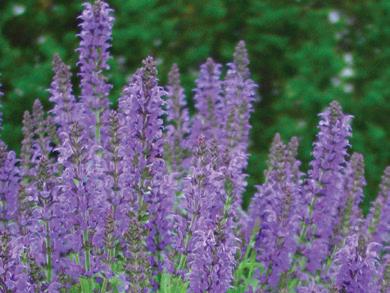

‘Purple Knockout’ is a TKO and deserves more attention in the trade. Native? Check. Compact basal rosettes that secure the soil and look stellar all the while? Check. Multi-season ornamental appeal? Check. Will self-sow into a dense, weed-suppressing groundcover? Check. Has pollinator-attracting flowers? Check. Finally, a reliable native comparable to Ajuga? Ding, ding, ding—we have a winner—help us spread the word!
scl
18” | Z 6-9 | 50
Salvia nemorosa ‘Blue Hill’ (10) garden sage
A resilient performer selected by Ernst Pagels for its sky-blue flowers and compact habit. Insect and disease resistant, long flowering, and tough as its brethren to follow.
veg
18-30” | Z 4-9 | 72
Salvia nemorosa ‘Caradonna’ (11)
A fan favorite for good reason, the floral display is simply incomparable! Rich purple-black stems with the most vivid indigo flowers available on the market. Upright habit makes for excellent pairing with Geranium, yellow Baptisia and purple Heuchera
veg
18-30” | Z 4-9 | 72
Salvia nemorosa ‘East Friesland’ Spikes of violet-purple, tubular flowers with light green, aromatic foliage in June and July. Remove spent flower spikes to help extend the bloom period. Well-drained soil.

veg
18-30” | Z 4-9 | 72
Salvia nemorosa
Marcus® PP13322 (12)
A smaller ‘May Night’ cousin, covered in violet-blue flowers in early summer. A good bloomer with compact and very short habit. Very easy to grow. A Haussermann Nursery Selection.
veg
10-12” | Z 4-9 | 50
Salvia nemorosa ‘May Night’ (13)
A staple in the landscape thanks to its overall low maintenance, vigor, and striking violet-blue flowers in May and June. A garden-worthy plant that stands the test of time. The Perennial Plant Association’s 1997 Perennial Plant of the Year®
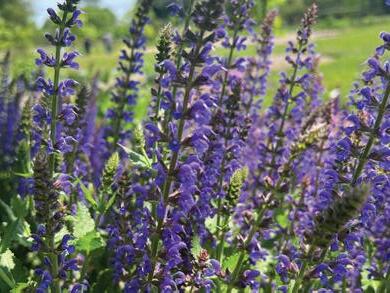

veg
18-24” | Z 4-9 | 72
Salvia nemorosa
‘Rose Marvel’ PP30118 (14)
Brings a rich, deep rose color to the popular Marvel family. Has the largest flowers of any rosecolored S. nemorosa and can be positioned as a premium perennial item, creating more opportunity for grower margin.
veg
10-12” | Z 4-9 | 72
Salvia nemorosa
Sallyrosa™ ‘April Night’ PP26520 (15)
An early blooming, petite Salvia blooming a month earlier than the popular ‘May Night’, ‘April Night’ provides lush violet-blue blooms from spring to summer.
veg
12-14” | Z 4-9 | 50
Salvia nemorosa ‘Snow Hill’
Another Pagels breakthrough, this white flowering selection is a sport of ‘Blue Hill’ and has not lost its stride since adding it to our product offering back in 1997.
veg
18” | Z 4-9 | 72
Scabiosa columbaria

‘Butterfly Blue’ (16) pincushion flower
A profusion of blue-purple flowers from May until frost. A fantastic performer and butterfly magnet. Basal foliage is finely cut with a grayish-green cast. Thrives in welldrained soil. The Perennial Plant Association’s 2000 Perennial Plant of the Year®.
veg
12-15” | Z 5-10 | 72
Scutellaria ‘Appalachian Blues’ PPAF—NEW! skullcap

This seed selection is a cross of S. ovata and S. serrata, both plants indigenous to the mountains of West Virginia where breeder Peter Heus resides. The result of this cross? A compact, clump-forming skullcap with serrated leaves and dark margins that adapts to both sun and shade, with spikes of bicolor purple and white flowers that bloom for weeks on end.
veg
24” | Z 4-9 | 50
Scutellaria incana (17) hoary skullcap
An East Coast native blooming with loose racemes of small, two-lipped, purplish-blue flowers mid to late July. Happiest along the dry forest edge. Combine with native ferns and sedges, Anemone canadensis, and Iris versicolor
veg
2-4’ | Z 4-9 | LP50
Sedum ‘Autumn Fire’ (18) stonecrop
An easy-to-grow stonecrop that takes heat and drought. This selection boasts all the splendor of ‘Autumn Joy’ with a longer bloom period. Bold clusters of closely packed, rosy-pink flowers appear in late summer, age to a salmonbronze, and finish with a deep coppery-red in fall.
veg
2-3’ | Z 3-9 | 50
Sedum cauticolum ‘Lidakense’
A clumping Sedum with mounds of round blue-gray to bluegreen foliage on low spreading, gracefully arching stems. Foliage is nearly concealed by a brilliant array of rose-pink star flowers in early autumn. Onset of cooler temperatures coax foliage into a reddish-bronze appearance. Ideal accent plant, prefers a richer soil.

veg
8” | Z 3-9 | 72
55 Perennials | Grasses | Carex | Ferns | Vines & Woodies
10 11 15 12 16 13 17 14 18
Sedum kamtschaticum var. floriferum

‘Weihenstephaner Gold’ (1)
Named after an agricultural college in southern Germany, Sedum ‘Weihenstephaner Gold’ illuminates the perennial border or stepping stone pathway with an array of starry, pale yellow flowers come June. Compact low-growing foliage tops out around 6” with trailing stems that create a weed-proof mat. Dark scalloped leaves and red winter foliage.
veg
4-6” | Z 3-9 | 72
Sedum reflexum ‘Blue Spruce’
A dense mat of conifer-like blue foliage forms a tight weedresistant groundcover. In June, mauve-pink stems rise to 10” and are topped with brilliant yellow flowers. Excellent selection for rock walls, green roofs, walkways, and containers. Evergreen in warmer climates, easy to maintain.

veg
3-6” | Z 3-9 | 72
Sedum rupestre ‘Angelina’ (2)

A quick-to-spread groundcover with needle-like foliage that emerges chartreuse and turns golden-yellow. Autumn coaxes rich shades of orange and red. Yellow flowers bloom mid-summer.
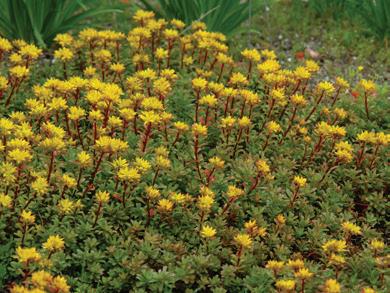
veg
6-10” | Z 3-9 | 72
Sedum sieboldii (3)
Scalloped, silver-blue foliage with clusters of star-shaped, bright pink flowers in late September and October. Unique arching habit and the best winter resistance. BONUS—fall color, as foliage takes on shades of orange, yellow, red, and pink.
veg
6-12” | Z 3-9 | 72
Sedum spurium ‘John Creech’ (4)
The small, scalloped green leaves of this weed-smothering groundcover are topped with rose-pink flowers in late summer and fall. It is very hardy, vigorous, and gorgeous weaving in and out of steppingstones or along a garden path.
veg
3-6” | Z 3-9 | 72
Sedum spurium ‘Red Carpet’ (5)
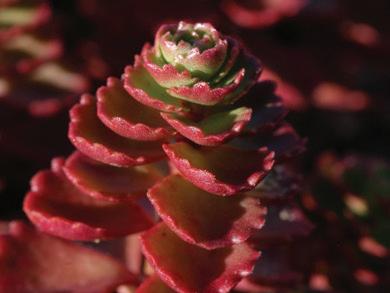
A vigorous and long-lived groundcover that forms a dense, weed-blocking mat. It starts red in the spring, stays red throughout the season, and is not prone to reversions. Rosy-red flowers appear in summer.
veg
3-6” | Z 3-9 | 72
Sedum SunSparkler®
‘Cherry Tart’ PP24603 (6)
‘Cherry Tart’ does not disappoint! A breakthrough series from Chris Hansen, this selection has a compact growth habit, attractive foliage, large flower heads, and brilliant bloom color. Masses of brilliant pink, 5” diameter flower clusters explode above cherry-red leaves from late summer into early autumn.
veg
6” | Z 4-9 | 72
Sedum SunSparkler®
‘Dazzleberry’ PP22457 (7)
The compact, smoky blue-gray foliage is an attractive groundcover throughout the season. Raspberrypink flower heads range in diameter from 6-8” and put on a dazzling display from late summer to fall.
veg
6-8” | Z 4-9 | 72
Sedum SunSparkler®


‘Lime Zinger’ PP24632
Lime green foliage with a crisp, contrasting red edge. Hot pink flower heads last for weeks through late summer into fall, and do not flop or fade! Excellent in a perennial border, rock garden, or as a groundcover.
veg
6” | Z 4-9 | 72
Sedum telphinum ‘Autumn Joy’
A garden classic, the brilliant floral display of ‘Autumn Joy’ is sure to spark joy in all the butterflies and bees that stop by for a visit! Introduced by Georg Arends of Germany, this selection has rounded pink flower clusters in June and July, changing to deep red the months to follow. Heads hold up well all winter. An easy-togrow plant that tolerates drought.
veg
2-3’ | Z 3-9 | 50
Sedum ternatum ‘Larinem Park’
One of our favorite Shady
Groundhuggers™! A low-growing, succulent native for shade, it carpets the woodland floor with whimsical round leaves arranged in threes. In spring it is covered in white star-shaped flowers. Delightful!
veg
6” | Z 3-9 | 72 + LP32
Silene caroliniana var. wherryi ‘Short and Sweet’ (8) wild pinks

Your go-to native substitution for Dianthus—similar in appearance and bloom time yet tolerates a wider variety of garden situations. Silene ‘Short and Sweet’ has been reliable hardy for us in wet and dry seasons, is compact and easy to grow, and covered in deep pink late spring blooms for weeks on end!
veg
6-8” | Z 4-7 | 72
Sisyrinchium angustifolium ‘Lucerne’ (9) blue-eyed grass
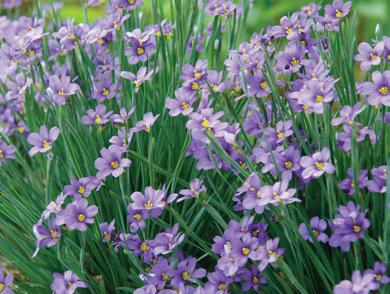
Utility, functionality, and beauty—a triple threat, and the ultimate garden center and landscape plant—it sells itself when in bloom. Bright blue star-shaped flowers with gold centers rise above fine, semi-evergreen, Iris-like foliage from May to June. Excellent for edging, it provides beautiful delineation along the front border of our rain garden. ‘Lucerne’ will charm your customers for 8-10 weeks!
8-10”
Z 5-9 | 72
Where Horticulture Meets Ecology™ 877.ECO.PLUG | info@northcreeknurseries.com | northcreeknurseries.com 56
tc
|
1 2 3 4 7 5 8 6 9
Sisyrinchium nashii

‘Suwanee’—NEW! (10)
Soft blue star-shaped flowers with gold centers from May to June. Excellent for edging, the 3/4” flowers are very good sized for the genus. A strong floral show without seeding around and a tidier habit with more flower power than the straight species.
veg
8-10” | Z 6-9 | 72
Solidago ‘Solar Cascade’ goldenrod
‘Solar Cascade’ is a clump-forming goldenrod which maxes out somewhere between the taller ‘Fireworks’ and more compact ‘Golden Fleece.’ Performs best in moist-to-average garden soil under full sun or partial shade; extremely drought tolerant once established. Shared with us by the Cincinnati Zoo & Botanical Garden.
veg
2-3’ | Z 3-8 | 50 + LP50
Solidago caesia (11)
bluestem goldenrod
The arching wands of golden clusters in September are contrasted beautifully by bluegreen stems. Add life to the garden and a dry shady spot with this butterfly magnet. Lovely interplant with Monarda didyma, Chrysogonum virginianum, Echinacea spp., and Andropogon gerardii as noted by our friends at Mt. Cuba Center.
op
2-3’ | Z 4-8 | LP50
Solidago flexicaulis—NEW! (12)

zigzag goldenrod
Distinguished by broad, toothed leaves and zigzag stems, this goldenrod brings pollinators to your dappled shade areas with subtle yellow flower clusters in mid-summer to fall. A hardy native perennial, it tolerates deer, shade, and clay soils.
op
1-3’ | Z 3-8 | LP50
Solidago graminifolia (13) syn. Euthamia graminifolia flat-top goldenrod
Fine-textured linear foliage and golden flat-topped inflorescences in late summer. Cherished by butterflies and praying mantises as well as the wildflower enthusiast.
op
3-4’ | Z 3-9 | LP50
Solidago Little Lemon® PP17297 goldenrod

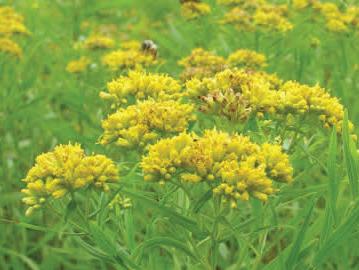
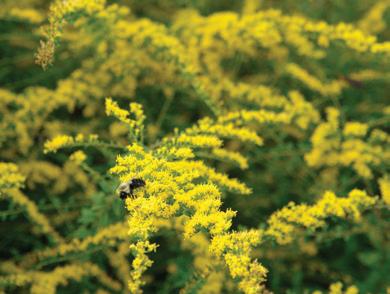
By far the most compact, carefree goldenrod available. A retail gem with its well-branched, compact habit, and great shelf life. It is versatile, easy to grow and combines well with purple and pink asters both in the garden and in a container. Great as a cut flower.
veg
12-18” | Z 4-9 | 50
Solidago odora (14) anisescented goldenrod
When crushed, the wonderfully fragrant foliage of this species gives off an anise scent. Occurs in upland environments throughout much of the Eastern US. Clump-forming habit—is not weedy or aggressive in the garden. Likes average to poor sandy soils. High ecological value and a favorite of birds and beneficial insects.

op
2-4’ | Z 4-9 | LP50
Solidago rugosa ‘Fireworks’ (15) wrinkleleaf goldenrod
A tried-and-true selection for 1–2-gallon potting for fall perennial programs. ‘Fireworks’ is a compact, clump-forming goldenrod with reflexed, radiating flowers that resemble a spectacular display of fireworks. A long-time industry favorite selected and named by Ken Moore of North Carolina Botanical Garden and introduced by Niche Gardens.
veg
3-4’ | Z 4-9 | 50 + LP50
Solidago sempervirens (16) seaside goldenrod
Fleshy, waxy leaves with large individual flower heads that bloom August to November. This species plays a significant role in providing nesting habitat for shorebirds like willets, killdeer and black skimmers and is ideal for swales and rain gardens due to its salt tolerance. Plant amongst friends such as Panicum, Aster, and Eupatorium
op
3-6’ | Z 3-9 | LP50
Solidago sphacelata
‘Golden Fleece’ (17)
autumn goldenrod

Another fantastic Mt. Cuba Center introduction! Numerous wands of golden flowers from mid-August through October. Semi-evergreen, heart-shaped leaves. Truly an excellent groundcover and bee and butterfly charmer! Hairstreaks, sulphurs, and skippers are particularly attracted to goldenrod.

veg
18-24” | Z 4-9 | 50
Stachys ‘Helene Von Stein’
lamb’s ears
Also referred to as ‘Big Ears’, this selection produces a dense mat of woolly silver-gray leaves with an alluring velvety touch. Primarily grown for its ground-hugging excellence—do not discount the lovely spikes of purplish-pink flowers on tall stems that appear in summer. This cultivar is particularly useful to gardeners as its leaves will not melt in heat and humidity—can develop into a 3’ sweep in 2 years.
Cheers, ‘Big Ears’!
veg
12” | Z 4-9 | 50
Stachys ‘Silver Carpet’ (18)

This selection features smaller leaves and finer texture compared to ‘Helene von Stein’, and seldom blooms. What it may lack in floral display, it makes up in foliar appeal. Silky hairs cover the leaves, giving them a silvery appearance overall. Incorporate along the perennial path, rock gardens or living wall— mixes nicely with Allium cernuum and a variety of Heuchera
veg
12” | Z 4-9 | 50
57 Perennials | Grasses | Carex | Ferns | Vines & Woodies
10 11 15 12 16 13 17 14 18
©Mt. Cuba Center ©Uli Lorimer
58 Stachys monieri ‘Hummelo’ (1)
betony
Adored by pollinators as well as visitors to our trial gardens! Towering spikes of magentapurple bloom profusely atop bright green, trouble-free foliage. What sets this garden all-star apart is its strong flower production, vigor, habit quality, and winter hardiness. Evergreen in mild climates, clumps gradually expand via stolons. The highest rated Stachys in the Chicago Botanic Garden Evaluation Trials. The Perennial Plant Association’s 2019 Perennial Plant of the Year®
veg
18-20” | Z 4-8 | 50
Stokesia laevis ‘Peachie’s Pick’ Stoke’s aster
Selected in Peachie Saxon’s Mississippi garden, this Stokesia has the typical lavender-blue flowers of the species, but it is very compact and has incredible flower power— and the flowers just keep coming, especially with periodic trims. A breeze in production and excellent addition to the perennial border.
tc
12-18” | Z 4-8 | 50
Stylophorum diphyllum (2)
celandine poppy
Predominant woodland species that brings cheer in spring with brilliant 4-petaled, bright yellow flowers blooming atop blue-green, pinnately-lobed foliage. Best grown in medium-to-wet, humus-rich soils. Tolerates all but the driest conditions, will go dormant in early summer if soil dries out. Blooming in March and April, this wildflower is the perfect companion for Mertensia, Aquilegia and Phlox.
veg
12-24” | Z 4-9 | LP32
Thalictrum rochebrunianum (3)

giant meadow-rue
Airy, maidenhair fern-like foliage produces rich purple stems that are topped with broad umbels of bright lavender clusters in July and August. An architectural gem for borders, meadows, and naturalized areas. Plant en masse to accentuate the vertical appeal and floral display.
op 4-6’ | Z 4-8 | 50
Thermopsis villosa (4) syn. Thermopsis caroliniana Carolina lupine
Clump-forming perennial with dense spikes of sulfur-yellow in June resemble that of Baptista or Lupine. Gray-green, compound foliage is attractive late into the season. Prefers poor soil, very durable and long lived once established.
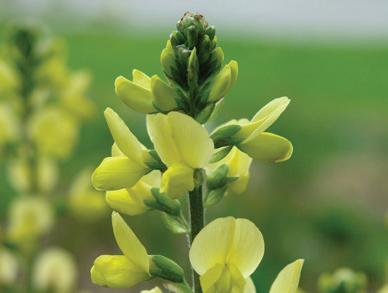
op
3-4’ | Z 5-8 | LP50
Tiarella ‘Elizabeth Oliver’ (5) foamflower

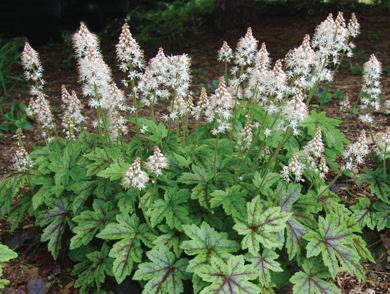
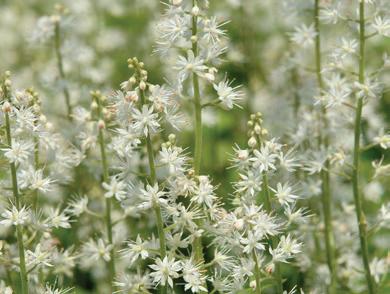
A beautiful foamflower selected by Charles Oliver of the Primrose Path for its striking, red-streaked foliage and delicate flowers tinged with pink—a classic among the fancyleaved varieties of foamflower available today. Clumping habit, slowly spreading by 6-12” runners to form a dense patch.
tc
12-15” | Z 4-8 | 72
Tiarella cordifolia (6)
A woodland treasure and one the best native plants for use as a shade groundcover. In early spring, playful, fairy wand flowers of white or light pink appear over green, deeply veined foliage often tinged with burgundy.
op
8-12” | Z 4-8 | 72 + LP32
Tiarella cordifolia ‘Brandywine’
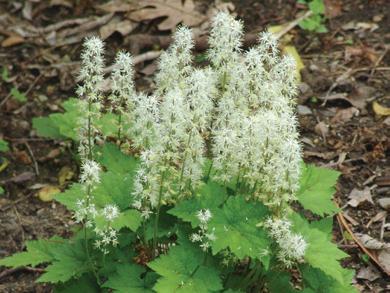
From The Pharoah of Foamflowers himself, Sinclair Adam brought this strong grower with glossy, rugose leaves and excellent bronze autumn and winter color. A robust clump former with short runners in spring and fall; rated one of the most vigorous of the genus.
tc
8-10” | Z 4-8 | 72 + LP32
Tiarella cordifolia
‘Running Tapestry’ (7)
A selection discovered by local plantsman and friend, Jim Plyler, of Natural Landscapes Nursery. ‘Running Tapestry’ is exactly what you expect—a carpet of deeply dissected, richly textured, heartshaped foliage propelled by a vigorous, running nature. Traditional spring flowers indicative of the species with a very attractive red streaking along the foliage.
tc
10-12” | Z 4-8 | 72 + LP32
Tiarella cordifolia
var. collina ‘Oakleaf’ (8)
Clump forming and free flowering form—still one of the best available after all these years! Flowering from May to June with light pink blooms atop emerging bronze foliage.
tc 10-12” | Z 4-8 | 72 + LP32
Tradescantia ‘Sweet Kate’ spiderwort
An eye-catching accent for the border, the vibrant golden-yellow foliage is the perfect backdrop for its brilliant purple blooms. Forms a clump that slowly expands from year to year; best grown in a partly shady site to prevent leaf burn.
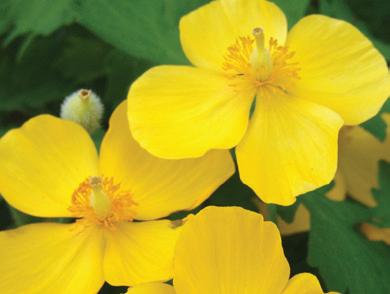
tc 18” | Z 5-8 | 50
Tradescantia ohiensis
A long-flowering, grasslike native perfect for dry-to-mesic meadows. Bluish-gray foliage with blue to violet-blue flowers from early June to September. Combines well with Chrysogonum, Liatris, and Phlox

op 24-36” | Z 4-9 | LP50
Tricyrtis ‘Sinonome’ (9) toadlily

A time-honored cultivar noted for white orchid-like flowers heavily speckled with ruby-colored accents. Prefers moist-to-wet, well-drained, slightly acidic soils in partial shade. Will spread slowly via rhizomes. veg
| 50
Where Horticulture Meets Ecology™ 877.ECO.PLUG | info@northcreeknurseries.com | northcreeknurseries.com
1 2 3 4 7 5 8 6 9
2-3’ | Z 5-8
Tricyrtis formosana ‘Gilt Edge’
A lovely compact form with touches of cream and light green along the foliage margin. Flowers look like miniature speckled orchids and bloom en masse summer into fall— be sure to plant this beauty where it has room to be admired! Thrives in moist, well-drained soils under part to full shade.
veg
12-24” | Z 5-8 | 50
Tricyrtis formosana ‘Samurai’ (10)
Stellar selection with lily-like flowers with dark purple spotting and yellow throats. One of the few varieties of variegated Tricyrtis that is a tough, garden-worthy plant with clean foliage! A shade garden must have, and the perfect cut for a bud vase.
veg
12-18” | Z 4-8 | 50
Tricyrtis hirta

Miyazaki Hybrids—NEW!
Growing under 2’ tall, Miyazaki Hybrids bear purple-speckled flowers on more gently arching stems than the straight species and a clumping nature unlike other rhizomatous toadlilies on the market. Best displayed along a pathway or near a seating area in the garden, as their unique flowers are certain to draw attention. A wonderful addition to the fall shade garden.
scl
18-24” | Z 5-8 | 50
Verbena ‘Homestead Purple’ (11) verbena
A roadside attraction turned industry standout—this mass of purple flowers caught the eye of Dr. Alan Armitage and Dr. Mike Dirr while traveling back to Athens, GA. Vigorous, deep purple flower clusters from June to November. Excellent deep green foliage. Best treated as an annual zone 6 or less.
veg 10-12” | Z 7-10 | 72
Verbena hastata (12) swamp verbena
Tall thin spikes of violet-blue flowers grace wet meadows, bioswales, and rain gardens in July and August. Highly functional; combines well with S. graminifolia
A short-lived perennial that readily self-sows where happy.
op
4-6’ | Z 3-9 | LP50
Vernonia lettermannii

‘Iron Butterfly’ (13) narrowleaf ironweed
Foliage comparable to Amsonia hubrichtii with a fall floral display of clusters of vivid purple flowers. Although native to moist meadows, it is tolerant of hot, dry summers. Thrives in the upper lip of our stormwater management basin. Very attractive to a host of pollinators.
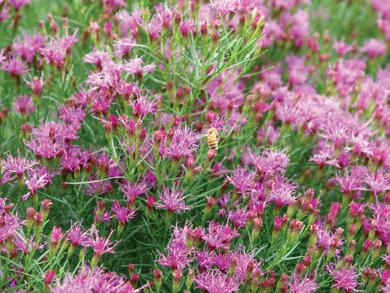
veg
30-36” | Z 4-9 | 50 + LP50
Vernonia noveboracensis (14) New York ironweed
Lovely native species that adapts well to moist locations. A rich purple haze of late summer blooms. Excellent stormwater management species; intermix with tall companions.
op
4-7’ | Z 5-8 | LP50
Veronica spicata


‘Glory’ PP18932 speedwell
Selected for dense, upright habit and abundant supply of deep violet flower spikes. The habit is compact and slow to spread. Superb in production and the landscape.
veg
12-15” | Z 4-8 | 72
Veronicastrum virginicum (15) Culver’s root
Dramatic spikes of white Veronicalike flowers in July and August. Found in open woods and moistto-mesic meadows. Very tough and long-lasting once established. Intermix with Andropogon virginicus, Rudbeckia maxima, Vernonia noveboracensis, and Echinacea purpurea
op
4-6’ | Z 3-10 | LP50
Viola walteri ‘Silver Gem’ (16) prostrate blue violet

Shared with us by Mt. Cuba Center, we are delighted to represent this tough native groundcover. Our longest blooming perennial— easily identified by trailing stems, distinctive foliage, and delicate lavender flowers—‘Silver Gem’ forms a dense mat of attractive silver foliage. Flowers appear in March and persist into autumn. Our plant trials have proven it to be exceptionally drought tolerant and happiest in part to full shade. Pot in quarts or gallons for early spring sales.
tc
3-5” | Z 6-8 | 72 + LP32
Waldsteinia ternata (17) barren strawberry
Emerging late spring, the 5-petaled, golden yellow flowers create a striking contrast with lush, evergreen foliage. Basal leaves are trifoliate with toothed margins. This low-growing, strawberry-like perennial spreads via rhizomes just below the soil surface and is commonly found along riverbanks. This multi-season groundcover makes a terrific substitute for Hedera and Vinca. A tough garden performer, use in the rock garden, planted below woodies and shrubs, or in a naturalized area.
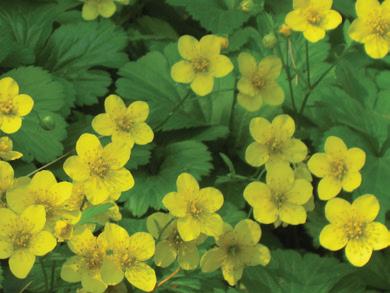
veg
3-6” | Z 4-7 | LP32
Zizia aurea (18) golden Alexanders
Golden-yellow, flat-topped flower clusters are nearly 2” in diameter and bloom spring into summer. Native to wet meadows, thickets, and swamps—perfect bioswale species. Tremendous ecological value as it is a larval host for the Black Swallowtail.
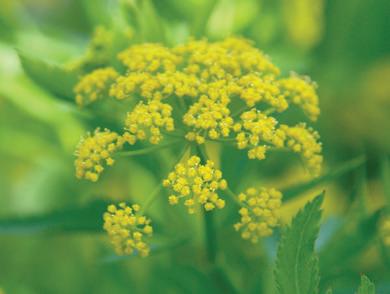
op 24-30” | Z 3-9 | LP50

59 Perennials | Grasses | Carex | Ferns | Vines & Woodies
10 11 15 12 16 13 17 14 18
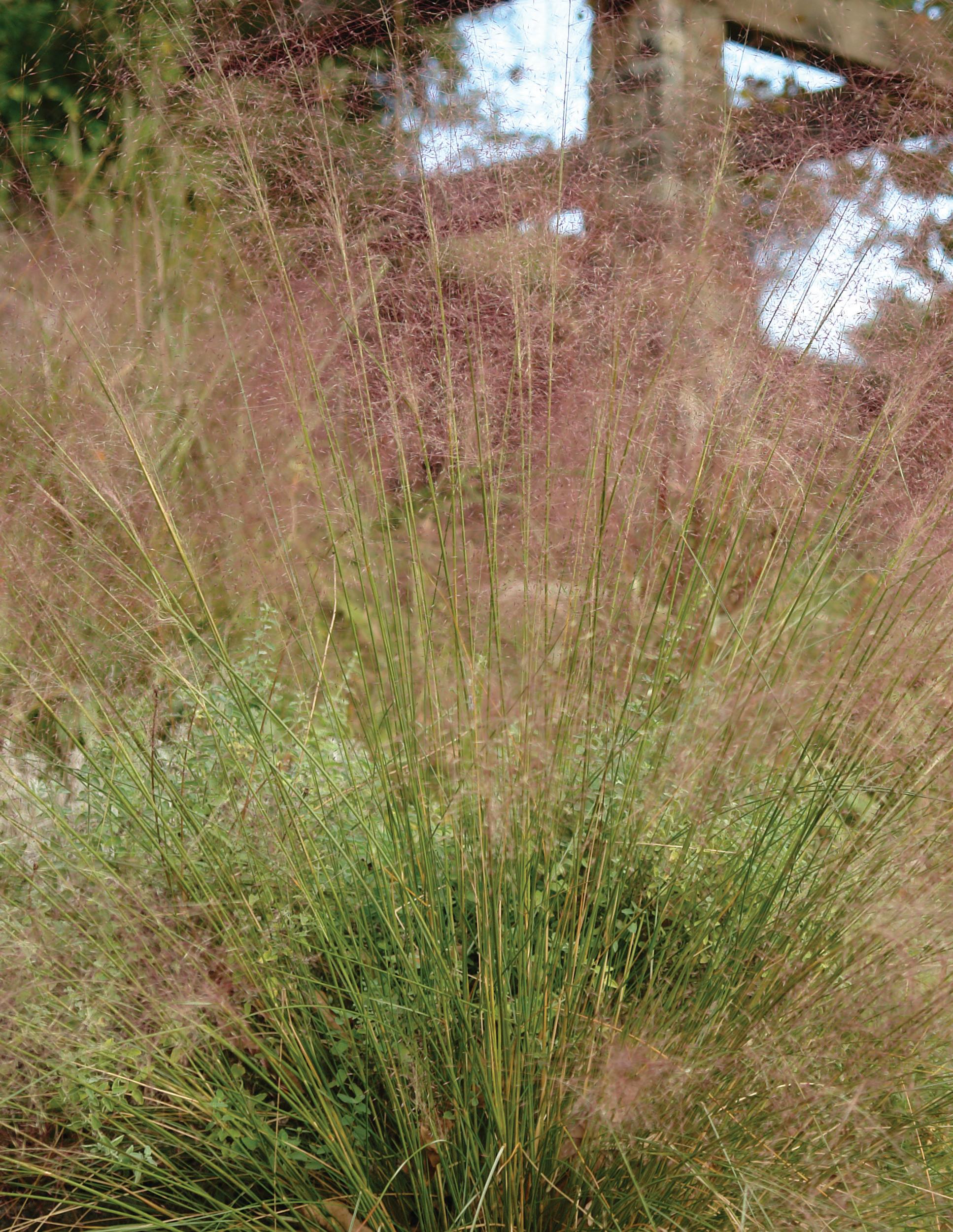 Muhlenbergia capillaris at Chanticleer
Muhlenbergia capillaris at Chanticleer
Grasses
North Creek offers a wide selection of warm and cool season grasses. Warm season grasses (C4) emerge in late spring and require warmer temperatures to push new growth— remaining in active growth throughout the summer and gradually coming to a stop after blooming in late summer or autumn. Cool season grasses (C3) prefer to ‘wake up’ with the cooler temperatures of spring and sometimes autumn; they go dormant during the heat of the summer and care must be taken not to overwater at this period.

Warm Season Grasses
Andropogon, Bouteloua, Eragrostis, Hakonechloa, Muhlenbergia, Panicum, Schizachyrium, Sorghastrum, Sporobolus
Cool Season Grasses
Acorus, Calamagrostis, Chasmanthium, Deschampsia, Festuca, Juncus, Scirpus
61 Perennials | Grasses | Carex | Ferns | Vines & Woodies
“ Preserve and cherish the pale blue dot, the only home we’ve ever known.
–Carl Sagan
62 Acorus americanus sweetflag
Excellent erosion control species with broad, spice-scented blades of foliage resembling Iris. Forms rhizomatous stands, providing effective soil stabilization and dense cover for wildlife. Ideal for use in sites with deer pressure due to aromatic foliage. An excellent choice for freshwater marsh restoration, rain gardens, or bioswales.
op
2-3’ | Z 3-6 | LP50
Andropogon gerardii (1) big bluestem
Handsome blue-green foliage and distinctive seedheads create a majestic presence in the landscape. Fundamental species for bioretention basins with extensive fibrous root system. Larval host and nectar source for the Delaware and Dusted Skipper.
op
4-8’ | Z 4-9 | LP50
Andropogon virginicus (2) broomsedge
A soil stabilizing plant that thrives in average to poor soils, infertile areas, and floodplains. Narrow, upright foliage takes on striking copperyorange tones in winter. Tolerates more moisture than little bluestem. Larval host for Zabulon Skippers. Blooms September to November.
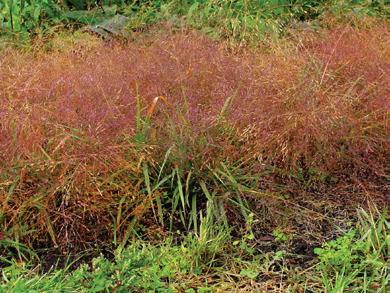
op
2-3’ | Z 5-8 | LP50
Bouteloua curtipendula (3) sideoats grama
Fantastic anchor species for short grass meadows or dry urban medians. Excellent choice for compacted soils. Purple oat-like spikelets line the flowering stem along one side and fade to tan; basal foliage turns hues of purple and red as temperatures cool in the fall.
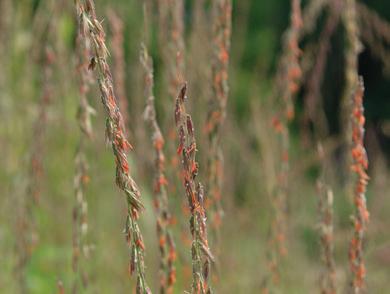
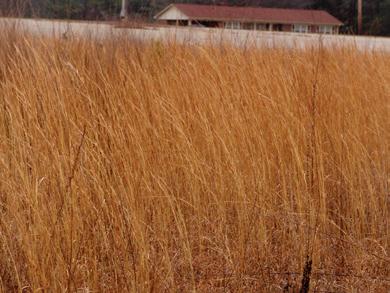

op
18-30” | Z 3-9 | LP50
Calamagrostis × acutiflora ‘Karl Foerster’ feather reed grass
A ubiquitous garden grass known for its ease of culture, strict upright habit, and beautiful feathery blooms. Tawny summer flowers turn golden in autumn. Easily grown in dry to average soil. The Perennial Plant Association’s 2001 Perennial Plant of the Year®
tc
4-5’ | Z 5-9 | 50 + LP50
Calamagrostis brachytricha Korean feather reed grass Puffy, tawny-pink plumes September to November. Soft and lovely, one of the few flowering grasses that is happy and blooms well in the shade. Average to dry soil.
veg
2-3’ | Z 5-9 | 50 + LP50
Chasmanthium latifolium (4) northern sea oats

A versatile native grass with attractive nodding seedheads late summer through winter. Good dry shade naturalizer. Profound golden fall color. Found in alluvial woods and along stream banks.
op
3’ | Z 5-8 | 50 + LP50
Deschampsia cespitosa tufted hairgrass
A dense, semi-evergreen tussock of medium green foliage through winter; showy light green to gold summer flowers. This cool season grower works well in heightrestricted meadows and wildlife habitats.
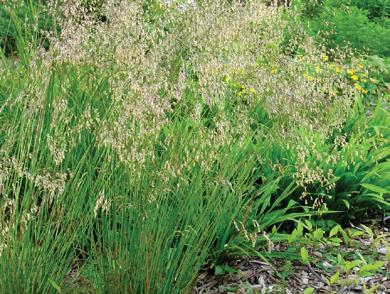
op
2-4’ | Z 4-9 | LP50
Deschampsia cespitosa ‘Goldtau’ (5)
Selected for lustrous foliage, compact habit, and extended bloom period. Airy, golden-yellow flowers emerge in June and last through to September, with attractive seed heads persisting through winter.
veg
12-24” | Z 4-9 | LP32
Deschampsia flexuosa (6) wavy hairgrass
The perfect woodland grass for dry shade. Delicate, fine-textured foliage is evergreen. Tough and tolerant of drought with a neat clumping habit. Arching inflorescences reach 18-24” in spring. Consider this species where it is too dry for C. pensylvanica op 6-18” | Z 4-9 | LP50
Eragrostis spectabilis (7) purple lovegrass
Fluffy clouds of purplish-pink flowers in late summer age to golden wheat. Bold textured, light green foliage turns bronzy red in the fall. Spectacular texture for urban sites and short meadows. Combine with Ruellia and C. verticillata. Found in dry, sandy fields.
op 18-24” | Z 5-8 | LP50
Festuca glauca
Beyond Blue™ PP23307 (8) common blue fescue
Intense blue foliage stays bright through all seasons for yearround interest. Flowers extend above uniform mounds of fine powder-blue blades in late spring and summer. Flowers fade to light brown by late summer and can be cut back if preferred. This low-maintenance gem will thrive despite heat, humidity, or poor soil conditions.
veg
10-12” | Z 4-8 | 50
Festuca glauca ‘Elijah Blue’ (9)
Clumping deep sea blue foliage. The most heat tolerant fescue by leaps and bounds. Neat evergreen mounds with wheat inflorescences that stand tall above the foliage. Use in perennial borders, mass plantings, containers, and edgings as well as in rock gardens or troughs. Stunning!



veg
10-12” | Z 4-8 | 50
Where Horticulture Meets Ecology™ 877.ECO.PLUG | info@northcreeknurseries.com | northcreeknurseries.com
1 2 3 4 5 6 7 8 9
Hakonechloa macra (10)

Hakone grass
Easily flowing through the landscape, this grass softens the garden with its gracefully arching blades as they drift between plantings. Airy flowers appear in late summer as the foliage becomes tipped in pink. Especially impactful in large masses under limbed-up deciduous trees.
tc 24-30” | Z 5-9 | LP32
Juncus effusus (11) soft rush
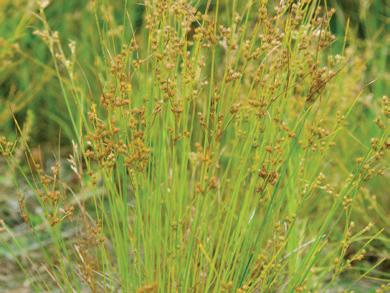
A deeply rooted anchor species ideal for wetland restoration and stormwater management. Deepgreen architectural stems form distinct clumps—combine with C. emoryi, V. noveboracensis, and H. autumnale. Excellent for winter erosion control; lovely golden flowers appear atop the stems in summer. Provides food and shelter for wildlife.
op
3’ | Z 2-9 | LP50
Juncus tenuis (12) path rush
A drought-tolerant, semi-evergreen species ideally suited for detention basins and highly compacted soils. Durable and adaptable in rain gardens, as a groundcover, and for erosion control. Will naturalize; intermix with taller species.
op
1-2’ | Z 3-9 | LP50
Muhlenbergia capillaris (13)
pink muhly grass

Fine, blue-green foliage explodes into vivid clouds of pink come autumn. This long-lasting floral performance is sheer magic when backlit by autumn sunsets. This clumping grass withstands heat, humidity, and drought, but requires good drainage in winter.
op
2-3’ | Z 6-11 | 50
Muhlenbergia reverchonii
UNDAUNTED® ruby muhly
A Plant Select® introduction bearing similar showy pinkishred flowers to M. capillaris, UNDAUNTED® was selected for compact habit, superior drought tolerance, and cold hardiness. A long lived and low-maintenance grass great for use in high pH urban meadows intermixed with fall flowering perennials.
scl
15-18” | Z 5-10 | 50
Panicum ‘Cape Breeze’ PP24895 (14) switchgrass

From production to the landscape, this standout selection is truly a breeze! Selected by celebrated New England landscape designer Paul Miskovsky, ‘Cape Breeze’ is distinguished for early bloom time, compact habit, rust resistance, and ability to push lush green foliage into late fall. Impressive golden inflorescences stay intact, maturing to beautiful open seedheads. Provides great texture and movement in the landscape.
tc
2-3’ | Z 4-9 | 50 + LP50
Panicum virgatum (15)
A diverse species with bluishgreen foliage, airy panicles, and a spectrum of applications ranging from meadows to stormwater management. Low input plant with abundant biomass and much to contribute in terms of wildlife and ecosystem services.
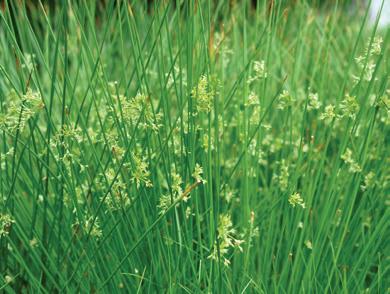
op 3-5’ | Z 2-9 | LP50
Schizachyrium littorale—NEW! (16) coastal little bluestem



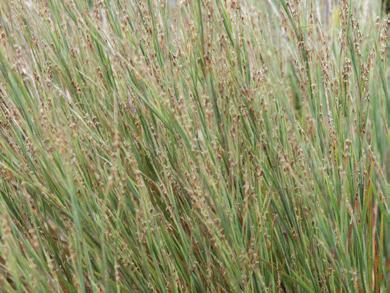
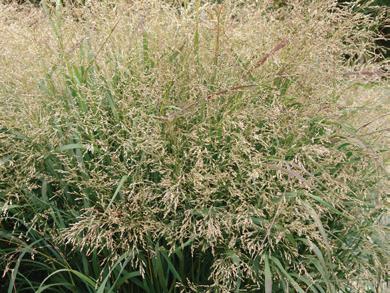
An underutilized native warmseason grass, this compact species needs minimal maintenance and adds a layer of durability and function to the landscape. Distinctive feathery seedheads remain on the stem well into the winter. We predict this grass will become a favorite for dune restoration projects, coastal landscaping, and low-maintenance high-exposure urban sites.
op 1-2’ | Z 3-8 | LP50
Schizachyrium scoparium (17) little bluestem
An upright, clump-forming native grass with spiky blades of blue to green. Wispy, silvery flowers occur in late summer, followed by a spectacular display of fall color changing from green and orange to deep burgundy. Consider little bluestem when conditions are too dry for A. virginicus. S. scoparium and cultivars were named the Perennial Plant Association’s 2022 Perennial Plant of the Year®.
op 3-4’ | Z 3-8 | LP50
Schizachyrium scoparium
‘Standing Ovation’ PP25202 (18) little bluestem
Our pride and joy and first ever patented introduction—this selection retains a tight, upright habit and architectural appeal from summer through winter. Evaluated in lean to rich soils in our gardens, ‘Standing Ovation’ is true to its name and worthy of applause. The summertime spikey, bluish-green foliage transitions to an array of oranges, yellows, and purplish-reds in autumn. A 5.0 top-rated performer at the Penn State SEAREC Landisville, PA Trial Gardens.
tc 3-4’ | Z 3-8 | 50 + LP50
63 Perennials | Grasses | Carex | Ferns | Vines & Woodies
10 11 12 13 14 15 16 18
“ Nature does not hurry, yet everything is accomplished. –Lao Tzu
64 Scirpus cyperinus (19) wool grass
A deeply rooted species with attractive, woolly inflorescences that turn copper in late summer. Phenomenal species for phytoremediation and bioretention. More drought tolerant than S. validus
op
4-6’ | Z 4-8 | LP50
Scirpus validus syn. Schoenoplectus tabernaemontani softstem bulrush
Obligate wetland plant for inland shallow waters, non-tidal marshes, and wildlife. Dark green, hollow, upright stems spread quickly in permanently inundated conditions and capture pollutants. Excellent species for stormwater runoff and erosion control
op
6-8’ | Z 3-9 | LP50
Sorghastrum nutans (20) yellow prairie grass
Ideal anchor species for meadow restoration; incorporate with E. purpurea and A. syriaca. Bluishgreen foliage turns a translucent yellow-gold fall color and bears beautiful copper panicles. Larval host and nectar source for the Pepper and Salt Skipper.
op
3-6’ | Z 2-9 | LP50
Sorghastrum nutans

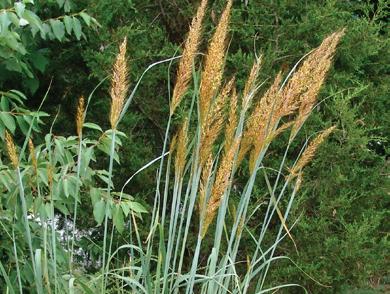
Golden Sunset® PP33776 NEW!
Selected for upright stature, olive-green foliage, and abundant yellow and golden-bronze flowers, this impressive selection from the University of Minnesota performed excellently in our trial gardens. Gorgeous golden plumes appear earlier and more profusely than the species.
tc
4-6’ Z 3-9 LP50
Sporobolus heterolepis prairie dropseed

Considered to be the most handsome of the prairie grasses according to Neil Diboll of Prairie Nursery, the fine textured nature of this species makes a well-defined and distinctive border accent. Lovely, light, and airy flowers in September and October with a fragrance reminiscent of coriander. Glowing pumpkin-orange fall color. Great drought tolerance.
op
2-3’ | Z 3-9 | 50 + LP50
Where Horticulture Meets Ecology™
19 20 Scirpus validus
“
Nature is not a place to visit. It is home.
–Gary Snyder
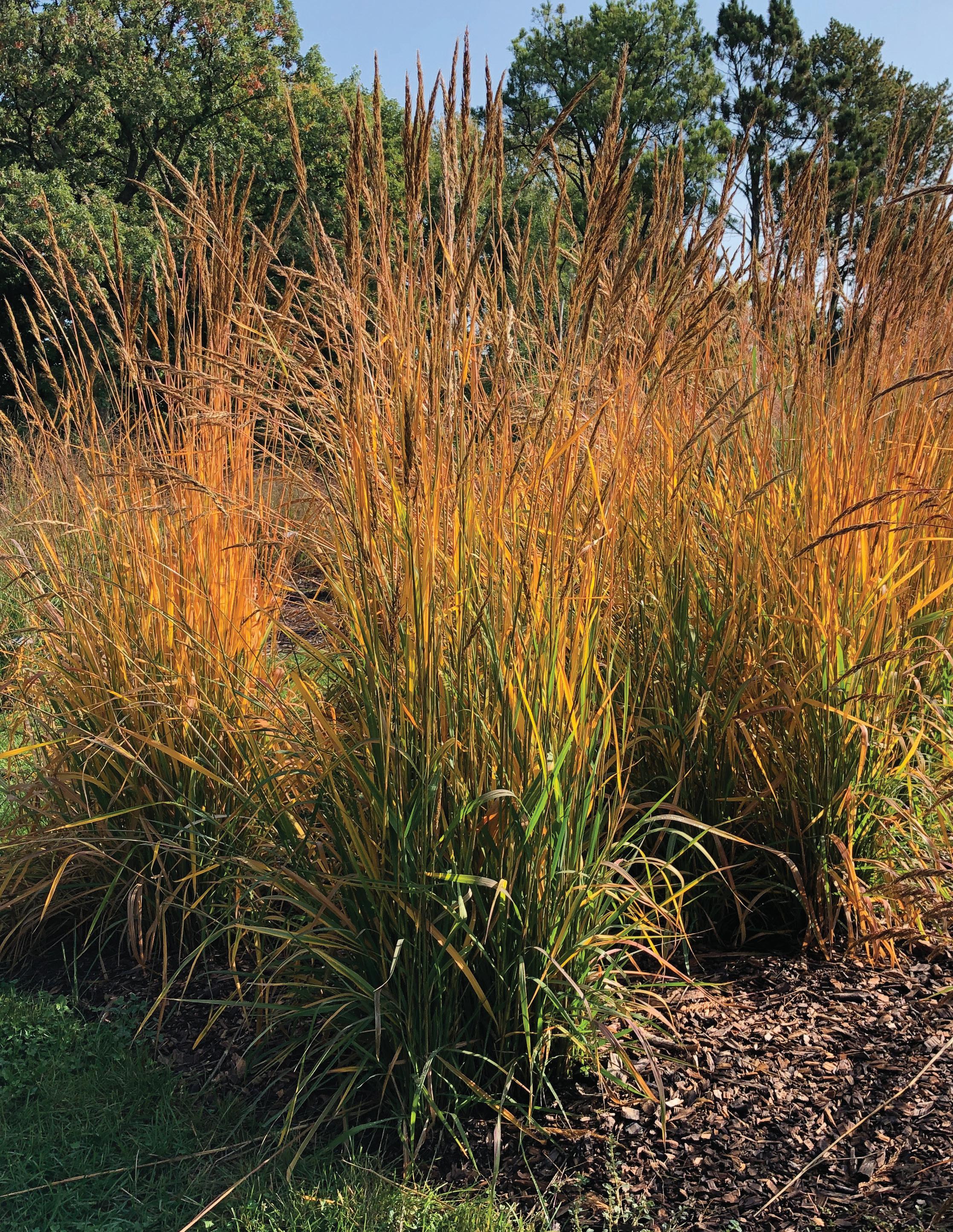
Sorghastrum nutans Golden Sunset®
 Carex stricta at North Creek Nurseries
Carex stricta at North Creek Nurseries
Carex

Get Edgy, Get Sedgy!
Sedges have edged their way into our hearts, taken foothold in the marketplace, and continue to gain popularity and notoriety—as their durability and utility is undeniable. This expansive genus puts forth key players for the groundcover layer in green infrastructure and myriad stormwater management solutions. Their ability to withstand winter salt, stabilize soil, and attract pollinators at a low-maintenance investment makes them a natural choice for garden applications. Our Carex collection is diverse—obligate to upland species—and tolerant of permanently inundated soils or areas where you seek to create a low foot traffic lawn alternative. Interested in building out your groundcover collection? We are hard at work trialing new species and tailoring our offering of solution-driven sedges.
67 Perennials | Grasses | Carex | Ferns | Vines & Woodies
“
Every flower is a soul blossoming in nature.
–Gerard de Nerval
68 Carex amphibola (1)
creek sedge
A widely adaptable sedge with shiny, semi-evergreen foliage and a compact clumping habit. Prefers deciduous shade in upland or floodplain conditions but can take full sun with adequate moisture. This long-lived beauty is an excellent native alternative to Liriope
veg
8-12” | Z 3-9 | LP32
Carex appalachica (2) Appalachian sedge
Forms dense clumps of cascading, exceptionally fine textured foliage. Adaptable to a wide variety of garden settings—including dry, shady sites under trees—but requires good drainage. Ideal substitute for C. pensylvanica, especially for drier conditions.
tc 12” | Z 3-8 | LP32
Carex cherokeensis (3)
Cherokee sedge
This clump-forming sedge works wonders for controlling soil erosion. Fares best in consistently moist, nearly saturated soil. Top ranked performer in our trial gardens with multiple seasons of interest and modest maintenance requirements. Semi-evergreen with early spring flowers and wispy, ornamental seed heads.


veg
12-18” | Z 6-9 | LP32
Carex eburnea (4) bristleleaf sedge
A wonderful naturalizer, this is an ideal native groundcover for the woodland or rock garden. Delicate, thread-like foliage with inconspicuous whitish-green flower spikes in spring. Each clump has a softly spherical habit, forming sizable stands in loose, friable soils. A low foot traffic lawn alternative.
tc 6-8” | Z 2-8 | LP32
Carex × hybrida Feather Falls™ PP26199—NEW! (5)
Consistently turning heads in our trial gardens, Feather Falls™ lands nowhere short of garden worthy and we are thrilled to now offer this beauty to customers! Give it room to spread as its reach can be quite sizeable—and use en masse where applicable—its clumping habit and long strands of brightly variegated white margined foliage brightens perennial garden. A more suntolerant selection from Exceptio Plants of Holland.
veg
14-18” | Z 6-9 | LP32
Carex flaccosperma blue wood sedge
A strong, clump-forming sedge with striking glaucous blue-green leaves. An excellent companion for ferns and other woodland natives. Spreads slowly; tolerant of drought and bright shade. Evergreen in warmer zones.


veg
6-10” | Z 5-8 | LP32
Carex laxiculmus Bunny Blue® ‘HOBB’ creeping sedge
A low growing native sedge with bold textured, silver-blue foliage. Matures into a dense, rounded clump. A naturalizer that remains evergreen in warmer climates. Late spring flowering.




tc 8-12” | Z 5-9 | LP32
Carex morrowii ‘Ice Dance’ Japanese sedge
A bright groundcover for a shady spot with long, shiny leaves with bright white edges. Over time, forms a semi-evergreen groundcover that provides contrast in the shade garden. Thrives in average to rich soils; quite tolerant of drought once established. Longlasting and easy to grow!
veg
12-15” | Z 5-9 | LP32
Carex muskingumensis (6) Muskingum sedge
A fine-textured sedge with upright habit and foliage which resembles palm fronds. This species has a dense, clump-forming habit and is happiest in moist meadows and along streams—will thrive in damp environments but does not like inundation. Combine with native ferns or incorporate into rain gardens. A showy textural plant that adds dimension in the garden and great for erosion control in restoration plantings.
op
2-3’ | Z 4-8 | LP50
Where Horticulture Meets Ecology™
1 2 3 4 5 6
Carex laxiculmus Bunny Blue®
Carex morrowii ‘Ice Dance’
©Walters Gardens
Carex oshimensis ‘Evergold’ (7) golden sedge

Fountains of narrow leaves with broad cream stripes and dark green margins provide superb contrast to surrounding plants. With its distinct arching form and cleanly clumping habit, this shade-loving sedge becomes an architectural feature wherever it is planted. A great accent in containers.

tc 12” | Z 5-8 | LP32
Carex pensylvanica (8) Pennsylvania sedge
A highly versatile native groundcover for average to dry, deciduous shade with finely textured foliage and a graceful, fountainlike habit. Lovely as an underplanting for bolder shade perennials or as a low traffic shade lawn alternative. Spreads via rhizomes and seed to form soft, flowing sweeps. Very popular!
tc 8-10” | Z 4-8 | LP32
Carex plantaginea (9) seersucker sedge
Broad, deep green, puckered leaves provide unique texture in the shade garden. Blooms early to midspring with finely tufted mahogany flowers. An excellent groundcover for average to moist shade. Foliage is semi-evergreen with a fresh flush of leaves in the spring.
tc 8-10” | Z 4-8 | LP32
Carex radiata (10) eastern star sedge
Very adaptable, preferring dappled sunlight to medium shade, moist to mesic conditions, and a rich loamy soil with abundant organic matter. Great groundcover to incorporate with native ferns or spring ephemerals, and in shady spots in a rain garden. Blooms in late spring; songbirds enjoy feeding on the seeds.
tc 1-2’ | Z 4-8 | LP32
Carex rosea—NEW! (11) rosy sedge
A petite woodland sedge with fine textured foliage and elegant starlike flower clusters appearing in spring. Neat, bright green clumps are densely mounded, providing form and function when used en masse—and just as lovely dotted through the landscape.
op 12” | Z 3-9 | LP32
Carex ‘Silver Sceptre’ (12) Japanese sedge
A brightly variegated, showy selection with narrow green leaves with white margins. This clumping Carex is awe-inspiring when planted in sweeps—thriving in the driest of conditions under mature trees. A bright addition to the shade palette, and salt tolerant to boot!





veg 12” | Z 5-9 | LP32
Carex stricta tussock sedge
Elegantly arching, rich green grasslike foliage forms dense clumps in moist to wet soils. Fibrous roots and rhizomes anchor to the soil and provide erosion control, filtration, and habitat in wetlands. A wonderful plant for bioswales, constructed wetlands, and along pond edges—right at home in a rain garden.
op 2-3’ | Z 3-8 | LP50
Carex vulpinoidea fox sedge
Key species for bioretention, phytoremediation, rain gardens, and bioswales. Matures into attractive tufts of narrow foliage with rhizomatous and fibrous root systems. Seedheads mature in late summer and resemble foxes’ tails.
op 1-3’ | Z 3-7 | LP50

69 Perennials | Grasses | Carex | Ferns | Vines & Woodies
7 8 9 10 11 12
Carex flaccosperma Carex vulpinoidea
“ Heaven is under our feet as well as over our heads.
–Henry David Thoreau
Athyrium niponicum

var. pictum
Ferns
All our fronds can find something they fancy within this collection—from tasty fiddleheads, painted pinnae, and architectural grace to species that take hold and work hard to get the upper hand on soil erosion—we have you covered! Offered in the Landscape Plug™ LP32, these robust plugs are a quick turn in production and ready to root for your success.
North Creek’s fern collection is a customer favorite and becomes available to ship in early April. It is our guarantee that ferns will arrive healthy, actively growing, and ready for potting. To ensure the best possible plant quality is hitting your production line— we only ship ferns in active growth.
Athyrium lady fern, painted fern
Handsome crowns of feathery fronds are typical of this genus. Stronggrowing and dependable, these ferns are great garden plants.

Dryopteris woodfern
There are at least 255 species of woodfern populating the temperate woodlands of the world. All are easy to cultivate if given consistent moisture and good drainage during establishment.
71 Perennials | Grasses | Carex | Ferns | Vines & Woodies
“
Every sunset brings the promise of a new dawn.
–Ralph Waldo Emerson
Adiantum pedatum (1)
northern maidenhair
Elegant, bright green fronds held atop shiny black stipes, creating a light, airy texture in the woodland garden. Spreads by shallow rhizomes to form a dense groundcover. Prefers moist, rich, well-drained acidic to neutral soil under bright shade.
tc 12-30” | Z 2-8 | LP32
Athyrium ‘Godzilla’ (2) Japanese painted fern
An introduction by Plant Delights Nursery in 2009, this Japanese painted fern is a monster! Growing up to 3’ tall and spreading up to 6’ wide, ‘Godzilla’ has the appearance of A. var. pictum with the punch of an ostrich fern. Thrives in shady locations in moist soil to dry shade.
tc 2-3’ | Z 5-8 | LP32
Athyrium angustum forma rubellum ‘Lady in Red’ (3) lady fern
Distinctive lacy, nearly luminescent bright green fronds contrast with brilliant deep burgundy stipes. Grows slightly shorter than the species—lovely, dependable, and easy to grow.
tc 18-30” | Z 3-8 | LP32
Athyrium filix-femina (4)
Tough as nails and easy to grow. A breathtaking flush of new fronds appears in spring with new growth throughout the season. Tolerates full sun with adequate moisture, flourishes in bright shade with evenly moist soil.
tc 2-3’ | Z 5-10 | LP32
Athyrium filix-femina ‘Victoriae’ (5)
Discovered in Scotland in 1861 during the Victorian Fern Craze, this unusual selection’s pinnae crisscross, forming a filigreed pattern of x’s. The intricacy increases with each finely crested leaflet. These frilly, feathery fronds have graced gardens since the reign of their namesake queen.
tc 18-24” | Z 4-8 | LP32
Athyrium niponicum ‘Regal Red’ (6) Japanese painted fern

This fern is a tapestry of color! The dark violet-red interior of each frond is fringed with bright silver, making each leaflet distinct in this breathtaking brocade. Pinnules twist softly, giving each frond a fluffed look. A unique, uniform, slowly spreading groundcover.

tc
15-18” | Z 4-9 | LP32
Athyrium niponicum var. pictum (7) Pearlescent blue-gray fronds are accented with subtle shades of green, purple, and red. The color is more intense when sited in a sunnier locale—preferably in morning or late afternoon. A jewel amongst the greens of the woodland garden. The Perennial Plant Association’s 2004 Perennial Plant of the Year®
tc
12-18” | Z 4-9 | LP32
Athyrium × ‘Ghost’ (8) lady fern
Selected for silvery-white fronds and a decidedly upright habit. Fronds age to a handsome green, providing a lovely backdrop for vivid new growth. Dynamic deep red stipes provide pronounced contrast to the luminous foliage.
tc 24-30” | Z 3-8 | LP32
Dryopteris erythrosora ‘Brilliance’ autumn fern
A colorful groundcover from start to finish—attractive pink fiddleheads unfurl to reveal varying hues of coppery-red new growth that mature into lustrous, evergreen fronds. Noted for new growth that is brighter red and lasts longer into the spring than the species.
tc 18-24” | Z 5-8 | LP32
Dryopteris goldiana (9) Goldie’s woodfern
Our largest and most attractive native woodfern. Stately stands of broadly arching, medium to dark green fronds spread on short rhizomes. Named for botanist John Goldie.
tc 3-4’ | Z 3-8 | LP32
Dryopteris marginalis
eastern woodfern
The leathery, evergreen fronds of this sturdy East Coast native form a tidy clump that will not spread. Occurs on rocky ledges and shady edges in neutral to slightly acidic soils. More shade is required in southern zones.


tc 12-18” | Z 3-8 | LP32
Dryopteris × australis southern woodfern
A statuesque addition to the garden, this natural hybrid (D. celsa × D. ludoviciana) is found in wild populations from Louisiana to Virginia. Coarse, slightly arching fronds remain upright.
tc 3-4’ | Z 5-9 | LP32
Matteuccia struthiopteris ostrich fern
The award for most dramatic goes to . . . ostrich fern! Tiny, tightly wound fiddleheads emerge in early spring and slowly unfurl into an arresting display of brilliant green fronds—the transformation is something to behold. Named for feathery sterile fronds suggestive of the plumes of an ostrich. Young fiddleheads are edible and an excellent source of vitamins A and C. Spreads freely by rhizomes especially in moist, loose soils.
tc
Onoclea sensibilis sensitive fern
A freely running, deciduous fern with broad, deeply pinnatifid, smooth fronds. Bold textured, bright green foliage is accented in late summer with upright fertile fronds that appear beaded. Very effective as a moist shade groundcover. Found in wet meadows, swamps, and open woods.




tc

Where Horticulture Meets Ecology™ 877.ECO.PLUG | info@northcreeknurseries.com | northcreeknurseries.com 72
3-4’ | Z 3-8 | LP32
1 2 3 4 5 6 7 8 9
1-2’ | Z 2-10 | LP32
Osmunda cinnamomea (10) syn. Osmundastrum cinnamomea
cinnamon fern

Brilliant green lacy fronds gracefully arch outward in stately vase-shaped clumps. Named for reddish-brown fertile fronds, which arise from the center of the plant in early spring and appear as if dusted in cinnamon. Prefers a moist shady site but tolerates more sun in cooler zones.
tc
2-5’ | Z 2-10 | LP32
Osmunda regalis var. spectabilis (11) royal fern
Aptly named for its handsome architecture, bold texture, and truly royal garden presence—with adequate moisture royal fern can reach a towering 6’ tall and create a lush, tropical feel along a stream or beside a pond.


tc
4-6’ | Z 2-10 | LP32
Phegopteris decursive-pinnata (12) syn. Thelypteris decursive-pinnata
Japanese beech fern
One of the best landscape ferns available! Excellent in pot culture and travels well. Arching fronds are a lustrous dark green and have a lighter green underside. Produces large stands via short runners in moist or average shade. Exceptional groundcover.




tc
1-2’ | Z 4-10 | LP32
Polystichum acrostichoides
Christmas fern
A top-selling, low-maintenance native fern with smooth evergreen fronds and a neat, clumping habit. Found in acid to neutral soils along shaded slopes and well-drained flats. An ideal species for massing on slopes to help combat soil erosion; perfect companion for spring blooming bulbs.

tc 12-18” | Z 3-9 | LP32
Polystichum polyblepharum (13)
Korean tasselfern
Meaning ‘many eyelashes,’ polyblepharum refers to the fuzzy stipe and rachis of this garden fern. Glossy evergreen fronds emerge starkly upright and arch gracefully as they age. A favorite amongst designers for its year-round structural and textural appeal, all while being extremely tolerant of drought and easy to grow.
tc 18-24” | Z 5-8 | LP32
73 Perennials | Grasses | Carex | Ferns | Vines & Woodies
10 11 12 13
Matteuccia struthiopteris Dryopteris marginalis Onoclea sensibilis
Dryopteris × australis
“
Men argue. Nature acts. —Voltaire
Lonicera sempervirens
‘Major Wheeler’

Vines & Woodies
Looking for beautiful blooms to twine through your perennial program? Our outstanding native vines have you covered all season long! The gorgeous, golden flowers of Gelsemium ‘Margarita’ brighten gardens in spring—while our Lonicera collection is covered late spring through summer in shades of orange, coral, and crimson. These long lasting and prolific blooms attract hummingbirds, butterflies, and bees, while the fruits appeal to goldfinches, hermit thrushes, purple finches, and American robins. And new to our collection, Clematis virginiana features graceful, soft white blooms that provide late season nectar for hummingbirds and bees.
North Creek’s woodies collection features two bold, reliable Caryopteris from both ends of our perennial offering spectrum—a legacy plant and newer introduction! A North Creek legacy plant, ‘Dark Knight’ has been a standby since our beginnings with striking, deep purple-blue flowers that have stood the test of time. Blue Empire™, an excellent selection we started growing in 2019, continues to impress us with large, clear blue flowers held on long-lasting wands. These outstanding selections feature fine, aromatic foliage deterrent to deer and provide valuable mid to late summer nectar for pollinators, as well as stunning late season impact in the landscape.

75 Perennials | Grasses | Carex | Ferns | Vines & Woodies
Clematis virginiana—NEW! (1)

old man’s beard
Blooming in late summer to early fall, this vigorous native vine is covered in showy, sweetly scented white flowers that are 1” across. A fine addition to fences, on trellises, or trained up trees, the blooms provide nectar to bees and hummingbirds, while the foliage provides cover for birds. Commonly found in moist, woodland edge areas east of the Mississippi, Clematis virginiana is a sound alternative to the invasive sweet autumn clematis.
op 12-20’ | Z 3-8 | 50
Gelsemium sempervirens

‘Margarita’ (2)
Carolina jessamine

Profuse display of fragrant, bright yellow, funnel-shaped blooms in early to mid-spring. Evergreen foliage takes on purple tones with reddish-brown stems through winter. Selected for exceptional cold hardiness. Best used to climb trellises, arbors, and fences. A Gold Medal Award winner from the Pennsylvania Horticultural Society.
veg 8-12’ | Z 6-9 | 50
Lonicera sempervirens (3)
trumpet honeysuckle
Showy, two-toned, crimson to redorange 2” trumpet-shaped flowers each have a yellow throat. Reliably blooms from spring into autumn; the floral display is succeeded by ornamental berries attractive to birds. Larval host for the Spring Azure and Snowberry Clearwing Moth. Blooms on previous year’s growth and new growth—trim it back, or leave it be! Locally sourced in Chester County, PA.
Where Horticulture Meets Ecology™ 76
veg 10-20’ | Z 4-9 | 50
1 2
Caryopteris × clandonensis Blue Empire™
Lonicera sempervirens
‘Magnifica’ (4)
A garden-worthy selection shared with us by PA plantsman and dear friend, Charles Cresson, ‘Magnifica’ lives up to its name! Coated with fragrant flowers ranging from coral to vibrant orange, each bloom features a golden inner accent. This vigorous vine blooms from May through June and is happy twining along fences or up trellises.

veg
4-7’ | Z 4-9 | 50
Lonicera sempervirens

‘Major Wheeler’
Found along the Carolina coast by Charles Wheeler—former president of the NC Botanical Garden Foundation— ‘Major Wheeler’ is the most intense and prolific redflowering selection available. Dark green foliage is completely covered with blooms from late spring through autumn. If you’re searching for a showstopper, your search ends with ‘Major Wheeler’. The hummingbirds will thank you.

veg
3-8’ | Z 4-9 | 50
Caryopteris × clandonensis
Blue Empire™ PP30494 blue mist shrub
According to our friends at Plantipp, the motto of this stunning Caryopteris is big, blue, and beautiful! We found that to be 100% true in our own trial gardens. Long wands of extra-large, deepblue blooms last for weeks on end with powdery green-gray foliage. Superior low growing habit, excellent landscape and cut flower appeal.
veg
30-40” | Z 5-9 | LP32
Caryopteris × clandonensis

‘Dark Knight’
‘Dark Knight’ is shrouded in a cloud of blooms from late summer into early fall—a reliable performer with a profusion of deep, purple-blue flowers and an upright growth habit with soft, gray-green foliage. Fragrant and incredibly attractive to pollinators, providing a late season nectar source for bees and butterflies.
veg
2-3’ | Z 5-9 | LP32
77 Perennials | Grasses | Carex | Ferns | Vines & Woodies
Caryopteris × clandonensis
‘Dark Knight’
Lonicera sempervirens
3 4
‘Major Wheeler’
“
No matter how complex or affluent, human societies are nothing but subsystems of the biosphere, the Earth’s thin veneer of life, which is ultimately run by bacteria, fungi and green plants.
–Vaclav Smil
How To Order
North Creek is a wholesale supplier of starter plants and Landscape Plugs™. Plants are sold in full flats of the quantities listed on our availability. We are not able to mix varieties within flats.

Deadlines
All new orders, revisions, and additions to existing orders—subject to availability—must be received by 12:00pm on Thursday for shipment the following week. Cancellations received less than a week prior to shipment or pickup date are subject to a 20% restocking fee.
Guarantee
Orders will be acknowledged in the order they are received; at times of high business volume, our sales and customer service team will confirm your request within three days of inquiry receipt.
Please carefully review your North Creek Order Confirmation and contact us at once if you see a discrepancy or have not yet received your Order Acknowledgement.
Order Placement
order@northcreeknurseries.com
877.ECO.PLUG



610.255.0100
Critical Order Details
• Company Name

• Order Contact
• Billing & Shipping Addresses










• Phone Number & Email Address

• Requested Ship Date
• Requested Ship Via
• Payment Method
• Sales Tax Exemption Number (PA, NJ only)

North Creek plants are guaranteed to be true to name and to arrive in good condition. True to our word, we will replace or issue full credit for plants proven to be incorrectly represented. Due to a wide range of grower experience and nursery conditions we cannot guarantee successful growth after potting, but please let us know about any disappointments you experience.
Claims
It is essential to inspect your shipment upon arrival. Claims will not be reviewed for shortages or errors unless reported within 1 week of receipt of goods— we require photos of damaged material. When possible, please note visible damage to carrier at time of receipt. North Creek is not liable for the productivity of plants upon potting up into larger containers or direct installation at project sites.
Payments
We accept all major credit cards. Invoices are charged at the time of shipment—freight charges are based on weight and applied at the time of shipment. To request Net 30 Terms, please complete and return the Credit Application from our website.
Terms Application
northcreeknurseries.com/Availability
Customers With Terms
Terms & Conditions Of Sale

Minimum Order
North Creek is wholesale to the trade—with a $500 minimum for first time orders. There is no order minimum for existing customers. A valid business license and tax identification number (EIN) are both required to set up a wholesale account.
All bills are due at Net in 30 days. 2% interest per month (24% year) will be added to any bills left unpaid after 30 days. Accounts showing 60 days past due will automatically be put on hold and no orders will be shipped until payment arrangements have been made. All available or accrued discounts will be forfeited until the account has been brought up to date. A $35 fee will be charged for all returned checks. The buyer agrees that if an overdue invoice remains unpaid, they shall be liable for collection charges including reasonable attorney fees. Action to enforce payment shall fall under the authority of Chester County, Pennsylvania.
Prices are subject to change without notice.
Where Horticulture Meets Ecology™
| info@northcreeknurseries.com | northcreeknurseries.com 78
877.ECO.PLUG
Stay Connected
Product Highlights & Availability
Keeping customers current on new product offerings and best management practices is integral to North Creek’s core values—working in and promoting sustainable environments while delighting our customers and providing opportunities for continuous learning. Keep in touch—our timely e-marketing updates and product announcements are designed to meet your needs.
All Plugs: 72, 50, LP32 & LP50
Landscape Plugs™: LP32 & LP50
Limited Offering: Unique items—including custom grow and trial offering selections—not included in our core product mix
Availability
Sent to your email with Plant of the Week on Monday mornings on a weekly, fortnightly, or monthly frequency—you choose!
The PLUG®
An ecological and landscape focused newsletter with informative tips on how to utilize Landscape Plugs™. Delivered Thursday morning to your inbox.
Plug Specifications
Plant Tags
A picture is worth a thousand words—but content is king! North Creek is proud to offer a custom line of pot tags ready for your retail benches. Our tags are the key to consumer confidence and include proper care guidelines, a comprehensive description, pollinator & habitat benefits, and beautiful photography. Price/tag is $0.16 and pre-bundled in the quantity of plants per flat. Tags shipped with all patented varieties unless otherwise requested. Most items in our core product offering have tags available for purchase, inquire when placing your order!
Availability Updated Daily northcreeknurseries.com/Availability
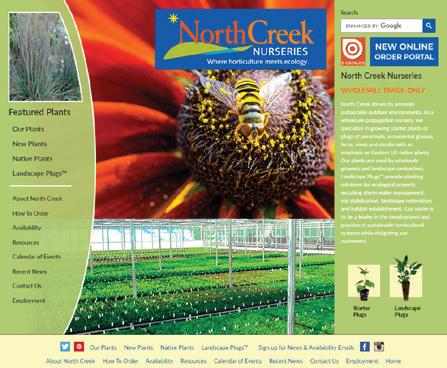

72
Horticultural Sizes
Vigorous & economical starter plug for horticultural varieties.

72 plugs/flat
Cell depth: 2.25”
Cell width: 1.52”
Cell volume: 3.60 in3
50
Robust & cost-effective starter plug for items with bigger root systems or broad leaves.


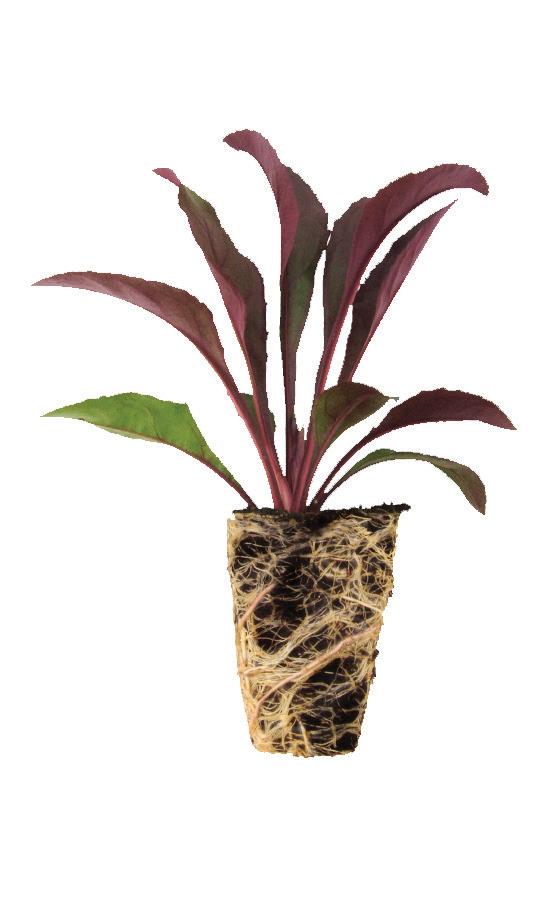
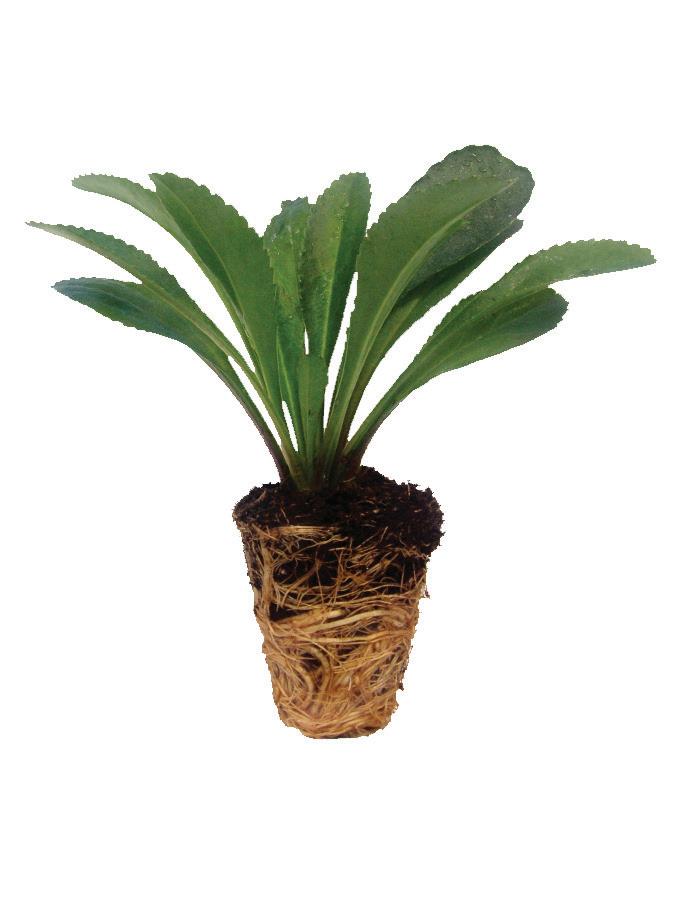
50 plugs/flat
Cell depth: 2.37”
Cell width: 1.90”
Cell volume: 6.77 in3
Landscape Plug™ Sizes
LP32
A husky plug for laterally rooted species including our fern, carex, and dry shade collections.
32 plugs/flat
Cell depth: 4.00”
Cell width: 2.22”
Cell volume: 10.07 in3
LP50
Our largest plug size for tap and deep-rooted species—a quick finish in landscape or container production. 50 plugs/flat
Cell depth: 5.00”
Cell width: 2.00”
Cell volume: 11.90 in3
79 Great Plants Start Here™
Shipping
Delivery Via North Creek Truck
North Creek is delighted to provide delivery on our trucks to locations within 600 miles of our shipping facility in Oxford, PA. Orders of 35 flats or more may be eligible for North Creek truck shipment if we can coordinate with other orders in your area. A per flat rate will be applied to all truck shipments based on distance from our shipping facility. If you prefer to receive plants on a North Creek truck, please let Customer Service know at the time of order placement. We will do our best to honor this request; we might also contact you to see if receiving your order on our truck is acceptable.
Cost per flat within U.S.
$4.50—up to 150 miles
$5.50—151 to 300 miles
$6.50—301 to 600 miles
(Additional fees may apply for difficult delivery areas.)
Rack Shipments
To ensure competitive market rates, we ship via XPO & FedEx Freight. Orders totaling 32 flats or more may ship using our cost-effective custom wooden rack—no boxes needed! Rack shipments provide several advantages over boxed shipments including increased air circulation while in transit, reduced cardboard waste, and reduced customer time and labor costs. An onsite forklift, loading dock and/or flat delivery area is required to receive your shipment on our custom wooden rack. If you wish to utilize our rack shipment option, please contact Customer Service for additional information. A $130 fee per wooden rack will be applied in addition to the outside carrier charge.
Canadian Shipments
Canadian orders require a USDA Phytosanitary Certification to ship with each order. Orders must be placed 3 weeks in advance to allow for inspection and required treatment. A $30.00 fee for certification and $1.00/flat drench fee will be added to shipments.
Rack Dimensions & Capacities
46” (l) × 46” (w) × 81” (h)
80 flat rack—72 & 50 plug flats
64 flat rack—LP32 & LP50 plug flats
Boxed Shipments
We partner with FedEx and UPS. Each flat is wrapped in netting to secure individual plugs throughout transit. A per-box handling charge and outside carrier charge is applied once the order is assembled and processed (see Box Dimensions & Capacities).
If you need final shipping costs for a boxed shipment, please request this from Customer Service at time of order placement.
Box Dimensions & Capacities
Boxes $8.00 each—All Sizes
Small Box (21” × 12” × 9”)
72 & 50 plug flat—fits 2 per box
LP32 & LP50 plug flat—fits 1 per box
Medium Box (21” × 12” × 15”)
72 & 50 plug flat—fits 3 per box
LP32 & LP50 plug flat—fits 2 per box
Large Box (21” × 12” × 18”)
72 & 50 plug flat—fits 4 per box
LP32 & LP50 plug flat—fits 2 per box
A Systems Approach to Nursery Certification (SANC)
North Creek is SANC (Systems Approach to Nursery Certification) compliant. This credential allows us to ship into a range of US states using the SANC certification instead of obtaining a phytosanitary certificate. There is no fee for SANC Certificates. Colorado, Montana, Nebraska, and New Mexico require a SANC Certificate. We do not ship plant material into Montana from June through September. All orders using SANC require a drench. The fee for drenching is $1.00/flat and is not to exceed $50.00. Standard order deadlines apply.
We are unable to ship plants to Arizona, California, Hawaii, Idaho, Nevada, Oregon, Utah, and Washington.
Summer Shipments
During the warm summer months, we might suggest delaying your shipment to ensure your order arrives in the best possible condition. If delaying a shipment is simply not possible, we offer and recommend expedited services to reduce the transit time of your order and reduce the risk of possible losses.
Winter Shipments
Many of our plants are acclimated to unheated greenhouses—vernalized—during winter months. If you receive dormant material through the late winter and early springtime of year, we recommend taking extra precautions to ensure viability upon transplant. When placing the plants in a warm greenhouse, it is important not to overwater the material or subject them to drastic temperature fluctuations. If you have questions or are uncertain on how to best manage dormant material, please contact Customer Service. We will happily direct you to a member of our growing team for additional information and guidance to ensure your success.
Where Horticulture Meets Ecology™ 877.ECO.PLUG | info@northcreeknurseries.com | northcreeknurseries.com 80
How To Find Us
Corporate Office & Trial Gardens
388 North Creek Road

Landenberg, PA 19350
Office Hours
Monday−Friday 8am−5pm
Customer Pick-Up & Shipping Facility
124 Wedgewood Road Oxford, PA 19363
Pick-Up Hours
Tuesday−Friday 7:30am−3:30pm
CUSTOMER PICK-UPS ARE NOT AVAILABLE AT THE LANDENBERG LOCATION.
Pick-Up
To ensure your order is ready upon arrival, please contact customer service to schedule a date and time for pick-up. If your pick-up time is not scheduled beforehand, you may experience delays. If you prefer orders to be boxed or put on a rack for pick-up, please notify customer service when placing the order. An $8.00 per box charge applies to all boxed customer pick-ups. The cost per rack is $130.00. No handling charges are incurred.
PICK-UPS MUST BE SCHEDULED IN ADVANCE. PLEASE CALL TO BOOK YOUR DATE & TIME.







 Steve Castorani President & CEO
Steve Castorani President & CEO




















































































































































































































































 Muhlenbergia capillaris at Chanticleer
Muhlenbergia capillaris at Chanticleer























 Carex stricta at North Creek Nurseries
Carex stricta at North Creek Nurseries






















































